- Travelogues
- Travel Agent Cooperation
.jpg)

How to Visit Tibet: follow the 9 easy steps
A visit to Tibet is one of the most spectacular journeys you can take, during which you will not only witness the highest mountains in the world, but also meet hospitable local Tibetans who live and breathe Buddhism in their everyday lives.
However, lying on the world’s highest Qinghai-Tibet Plateau, Tibet remains a far-flung destination that requires careful tour preparation.

Can I visit Tibet? Is there any age limit?
Of course, you can visit Tibet at any age, if you are physically able to adapt to high altitude travel. The youngest tourist we had was an 8-month baby, while the oldest was 82-year-old.
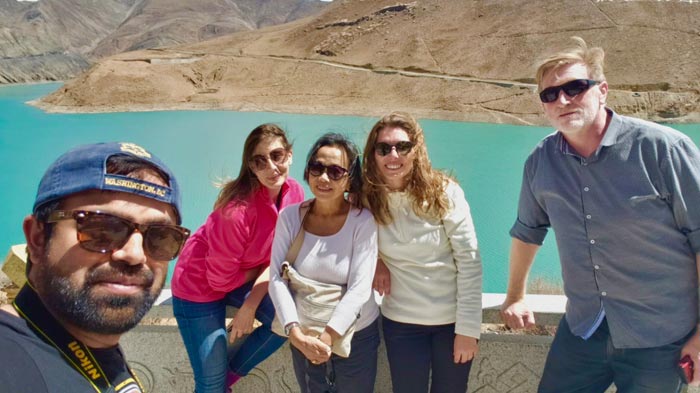
Please notice that even you can visit Tibet without an age-limit, you can’t visit Tibet independently. According to the Tibet travel policy, you need to book your Tibet tour through a registered travel agency, either a group or a private one, and visit Tibet with a licensed guide and driver.
Is it safe to visit Tibet nowadays?
Yes, absolutely!
No matter you are a solo traveler, a single woman tourist, or travel with family, the journey to Tibet will be surprisingly safe. The social security in Tibet is quite good and local Tibetans are simple and welcoming to guests from all over the world.
The only thing that threatens your safety is altitude sickness. Travelers with high blood pressure, cardiovascular disease, respiratory disease, coronary heart disease, severe asthma, lung disease, and untreated cold are not able to visit Tibet.
It is advised to have a good rest after arriving in Lhasa so that your body can get used to the high altitude. You can also take medicine and oxygen to reduce the discomfort of altitude sickness.
Insider Tips: 1. The high altitude sickness in Tibet varies from person to person and can be life-threatening in severe cases. Therefore, please seek professional advice from your doctor before traveling.
2. If you feel any discomfort while traveling in Tibet, please contact your guide immediately.
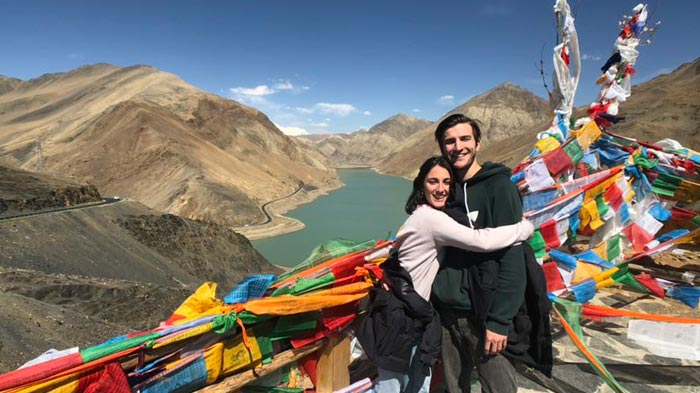
What travel documents required to visit Tibet?
You need Tibet Travel Permit , a Chinese Visa, and your valid passport to visit Tibet. Without any of these, you can even not board the flight or the train to Tibet. You can easily get a Chinese visa in your county. But the Tibet Travel Permit can be only applied through a licensed local Travel agency with a pre-booked Tibet tour package.
Insider Tips: 1. It is suggested to apply for your Tibet permit at least 20 days before your Tibet tour starts.
2. If you have more than one passport, please make sure you visit Tibet with the same one you used for your Tibet Travel Permit. Or you will be denied entry into Tibet.
3. If you enter Tibet from Nepal, you need to apply for a Chinese group visa in Kathmandu.

How much does it cost to visit Tibet?
Overall, the total cost of a Tibet tour alone ranges from US$400 to over US$2500 (not include the transfer to Tibet). And it all depends on how long you are staying for, the travel season you are in, where you want to go to visit in Tibet, and your personal expenses like souvenirs.
The best way to cut down the cost of a Tibet tour is to travel with more people as a group. You can share the transfer cost, the accommodation, and the service fee with your group members.
Insider Tips: 1. No matter when you visit Tibet, joining a Tibet Small group tour is always cheaper than taking a private tour in Tibet.
2. You can also make your own group with your family and your friends. The more people in the group the cheaper price you can enjoy.

When is the best time to visit Tibet?
Spring and summer are the best seasons to visit Tibet for the perfect weather, during which the weather in Tibet is warm enough to travel, yet neither too hot nor too cold. Also, you can have more chances to enjoy a clear view of the mountains in Tibet, especially when you visit Everest Base Camp.
Tibet winter, from November to mid-February, is the best time to visit Tibet for a cheaper price. In this low season of Tibetan tourism, the prices of Tibet flights and hotels are much cheaper than usual.
Summer is known as the rainy season in Tibet. But the rainfall is almost at night and will not have much impact on daytime sightseeing activities.
However, summer is the best time to experience Tibetan festival tours . Some popular Tibetan festivals, such as the Shoton Festival, the Saga Dawa Festival, and horse racing festivals are held in summertime (Late May to August).
Insider Tips: 1. Winter in Tibet is not as cold as you think. The average temperature of Lhasa in the daytime is around 18°C.
2. Pay attention to landslides or other geological disasters if you take a Sichuan Tibet overland tour in summer.
3. Please check the updated Tibetan Calendar for the exact dates of Tibetan festivals.

How to get to Tibet? which is the easiest way?
Visit tibet from the mainland of china.
Mainland China is the major gateway to enter Tibet. You can easily visit Tibet from the mainland of China by air, by train, or by land.
It is easy and convenient to take a flight to Tibet from most major cities in mainland China. Among all the entry cities, Chengdu offers the most frequent daily flights to Lhasa and Nyingchi.
The Qinghai-Tibet railway from Xining to Lhasa is the only railway to Tibet. Joining the train network in China at Xining, you can also take Tibet trains from Beijing, Shanghai, Guangzhou, Chengdu, Chongqing, and Lanzhou.
There are also four highways to Lhasa, namely Sichuan-Tibet highway (G318 and G317), Qinghai-Tibet highway (G109), Yunnan-Tibet highway (G214), and Xinjiang-Tibet highway (G219). You can enjoy a lifetime overland tour to Tibet through any of them as you like.

Visit Tibet from Nepal
Nepal is another popular gateway to enter Tibet, and Kathmandu is the only overseas city that offers international flights to Lhasa. The daily Kathmandu to Lhasa flights are run by Sichuan Airline and Air China.
You can also choose to enter Tibet from Nepal by land via the Gyirong border. The epic overland journey from Kathmandu to Lhasa takes about 8 days including a one-night stay on the Everest Base Camp at the northern side of Mount Everest.
Getting around Tibet
Road travel is the major way to visit Tibet. You need to prepare for long-distance travel if your Tibet tour including attractions outside Lhasa city.
The road condition in Tibet has been improved in recent years and most are asphalt roads, which are good for both vehicles, bikes, and motorbikes.
What are the must-sees places in Tibet?
Covering a total area of 1,228,400 square km, Tibet promises infinite opportunities for adventure, spiritual, and cultural discovery.
Lhasa is the must-see on all trips to Tibet. And a classic 4-day Lhasa tour is the best choice for the first-timers to Tibet and those who are short on time. The trip to nearby Namtso Lake or Yamdrok Lake only takes one more day.
Everest Base Camp is always on the list of most travelers to Tibet. The classic EBC tour from Lhasa takes 8 days, which includes an overnight stay at the base camp, so that you can enjoy the sunset or the sunrise at the top of the world.
Mount Kailash is like an ultimate goal for both pilgrims and non-pilgrim. A general 15 days Kailash Tour combines the classic Lhasa to EBC tour with an extended 3-day Kailash Kora and Manasarovar Yatra.
The overland tour from Lhasa to Kathmandu covers all the best along the Sino-Nepal friendship highway. This epic overland journey through the Himalayas takes 7 days by car and around 15 days by bike.
Insider Tips: In fact, there are more attractions in Tibet . You can find something that interests you in Tibet.
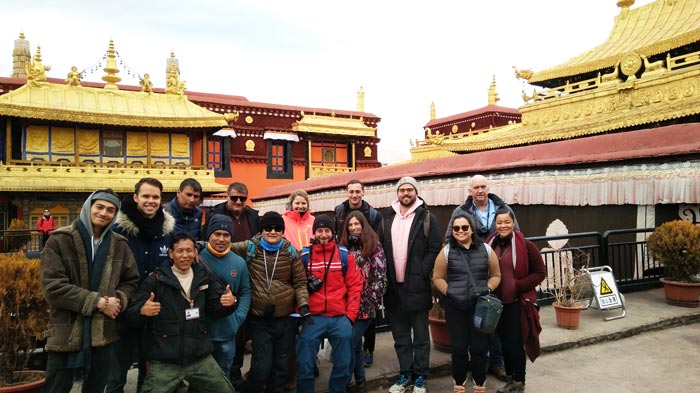
What to pack? Do I have to pack a lot?
Traveling to Tibet is not recommended to carry too big luggage. It is recommended to use a boarding case, hiking backpack, and carry-on backpack so that it is convenient to carry the necessary items and documents with you, and also to ensure that there is enough space to store your luggage on the train or your travel vehicles in Tibet.
Some Packing Tips for Visiting Tibet
Clothing: Warmth is the main concern. Also, it is recommended to wear a windproof jacket for your Tibet tour.
Shoes: Comfortable shoes or more professional hiking boots if you are going to enjoy a Tibet trekking tour.
Skincare products: Lotion and lipstick are essential to protect your skin in Tibet.
Sun Protection Products: Sunscreen with SPF 50 is recommended. Physical sun protection, like a hat, sunglasses, etc. is also essential.
Medicines: Follow your doctor’s instructions and prepare some cold medicine, gastrointestinal medicine, and pain relief medicine according to your condition.
Professional Gears: Things like trekking poles, biking accessories, sleeping bags can be rent or buy at outdoor stores in Lhasa. You can also bring the ones you are used to using.
Learn more about what to pack for a Tibet tour from our ultimate packing guide.
Insider Tips: We have prepared some common items free trial services for tourists, such as rechargeable batteries. There are also rental services for professional equipment such as trekking poles and sleeping bags.
Accommodation and dining tips of Tibet visting
Accommodation in tibet.
The Tibet hotels are not as good as those in big cities like Beijing, Shanghai, Guangzhou, Chengdu, etc. The best hotels mostly center in Lhasa, Shigatse, and Nyingchi. As you travel north or to the west of Tibet, like EBC and Mount Kailash, where you can stay are often the guesthouses or yak tents with a filthy pit toilet and no running water.

What to Eat in Tibet
The major Tibetan food you can taste in a local restaurant or a Tibetan teahouse includes Tsampa, yak butter tea, Tibetan noodles, yak meat, and so on. Also, Chinese dishes are widely served in Tibet.
In Lhasa city, you can find more food options such as Nepali, Indian and western cuisines.
If you have special food requirements, like vegan food or Muslim food, please tell your travel consultant or tour guide in advance so that they can arrange the right food for you.

Visiting Tibet is not as difficult as you think. You can travel to Tibet at any age, in any season, as you like. Just make sure you are physically healthy enough to take the tour at such a high altitude.
Getting to Tibet is no longer a problem, as now both flights and trains connect to Tibet. Moreover, there are five highways to Lhasa from Chengdu, Xining, Lijiang, Yecheng, and Kathmandu.
No matter what you want to know about visiting Tibet, such as the tour cost, the best places to visit, the accommodation standard in Tibet, etc. we are always here to provide the most professional suggestions and share our experiences with you.
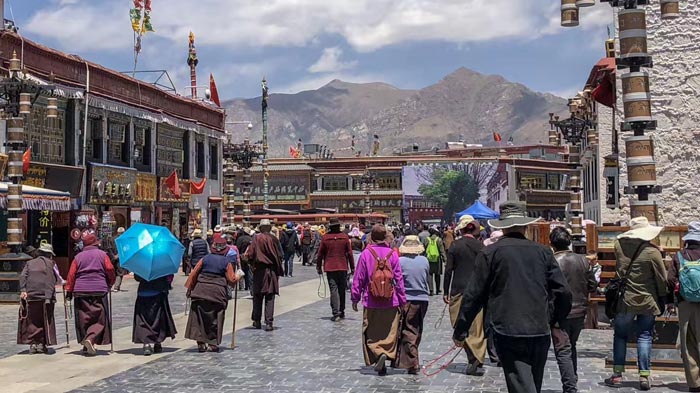
About the Author - Master Kungga Dundruk
The Lhasa-born prodigy used to study business overseas, and got his Bachelor of Business in Nepal and India before moving back to his homeland. With pure passion for life and unlimited love for Tibet, Kunga started his guide career as early as 1997 .
Responsible, considerate, and humorous, he devoted his entire life to guiding and serving international tourists traveling in Tibet. As a legendary Tibetan travel guru with 20-year pro guide experience. Currently, he is working in Tibet Vista as the Tour Operating Director. Whenever our clients run into trouble, he is your first call and will offer prompt support.
https://plus.google.com/+Kunga-TibetVista
Read all my articles about Tibet travel
Related Articles & Posts
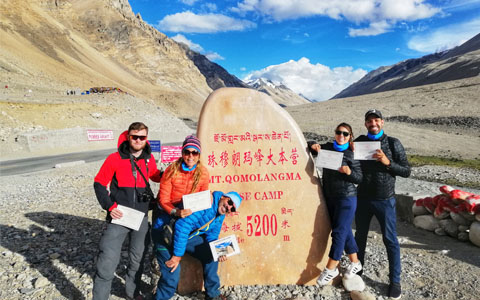
How many days should you spend in Tibet? Plan travel days in Tibet depends on many factors, including the places you wan ...
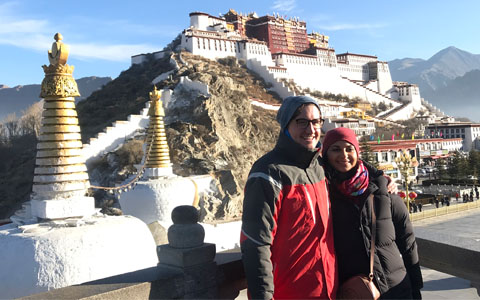
Planning to visit Tibet in 2024? With the reoepn of China Visa application and Tibet tours, it is possible for all forei ...
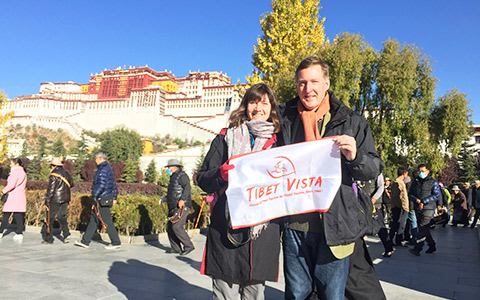
Experts' guide to how to find the best Tibet travel agency to run your Tibet tour, such as securing your Tibet permit, p ...
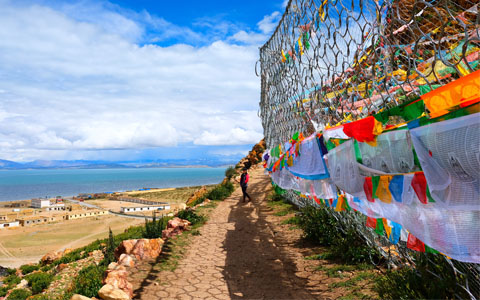
Tibet in Summer: Traveling to Tibet during the rainy season (June to Aug) is definitely not all a bad time. You can stil ...
Most Popular Tibet Tour Packages

8 Days Lhasa to Everest Base Camp Small Group Tour: Marvel at Mt.Everest Real Close from 4 Different Viewing Platforms
Lhasa - Gyantse - Shigatse - Everest Base Camp - Shigatse - Lhasa

15 Days Kailash and Manasarova Small Group Tour: A pilgrim’s final fantasy and the greatest overland trip in Tibet.
Lhasa - Gyantse - Shigatse - E.B.C - Saga - Kailash Trek - Darchen - Lake Manasarovar - Saga - Gyirong - Tingri - Lhasa

10 Days Lhasa to Everest Base Camp and Namtso Lake Small Group Tour
Lhasa - Gyantse - Shigatse - EBC - Shigatse - Lhasa - Namtso Lake - Damxung - Lhasa

8 Days Driving Across Himalaya Overland Adventure from Kathmandu to Lhasa
Kathmandu - Gyirong - Everest Base Camp - Tingri - Shigatse - Gyantse - Lhasa

4 Days Lhasa Impression Small Group Tour: Explore the Heart of Tibet and Mingle with the Locals

7 Days Lhasa to Kathmandu Overland Small Group Tour: Traverse from the North Side to the South Side of Mt.Everest for the Best of the Himalayas
Lhasa - Gyantse - Shigatse - Everest Base Camp - Gyirong - Kathmandu

6 Days Central Tibet Culture Small Group Tour: Explore Tibet's religion, cultural gems, and captivating landscapes.
Lhasa - Gyantse - Shigatse- Lhasa

13 Day Lhasa, Mt. Everest, Mt. Kailash, Lake Manasarovar and Kathmandu Adventure Tour
Lhasa - Gyantse - Shigatse - EBC - Saga - Darchen - Kailash Trek - Darchen - Saga - Gyirong - Kathmandu
0 Comment ON "How to Visit Tibet: follow the 9 easy steps"
Check All Tibet Travel FAQs Here

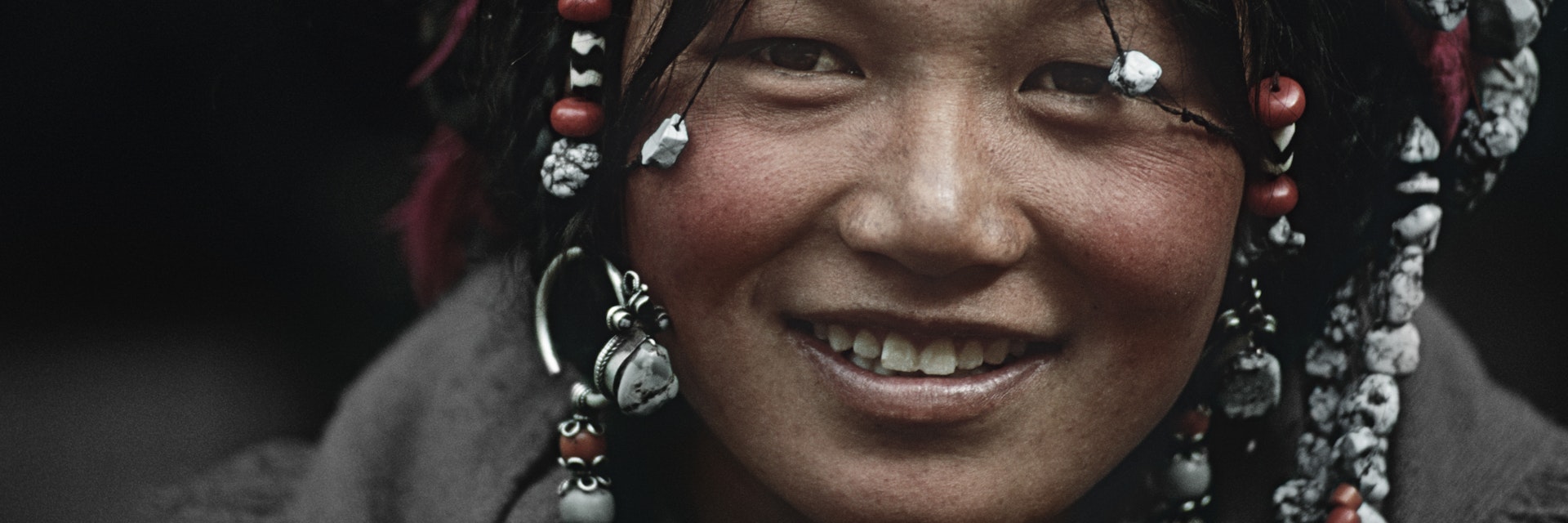
Getty Images/Brand X
Tibet offers fabulous monasteries, breathtaking high-altitude walks, stunning views of the world’s highest mountains and one of the warmest cultures you will ever encounter.
Attractions
Must-see attractions.
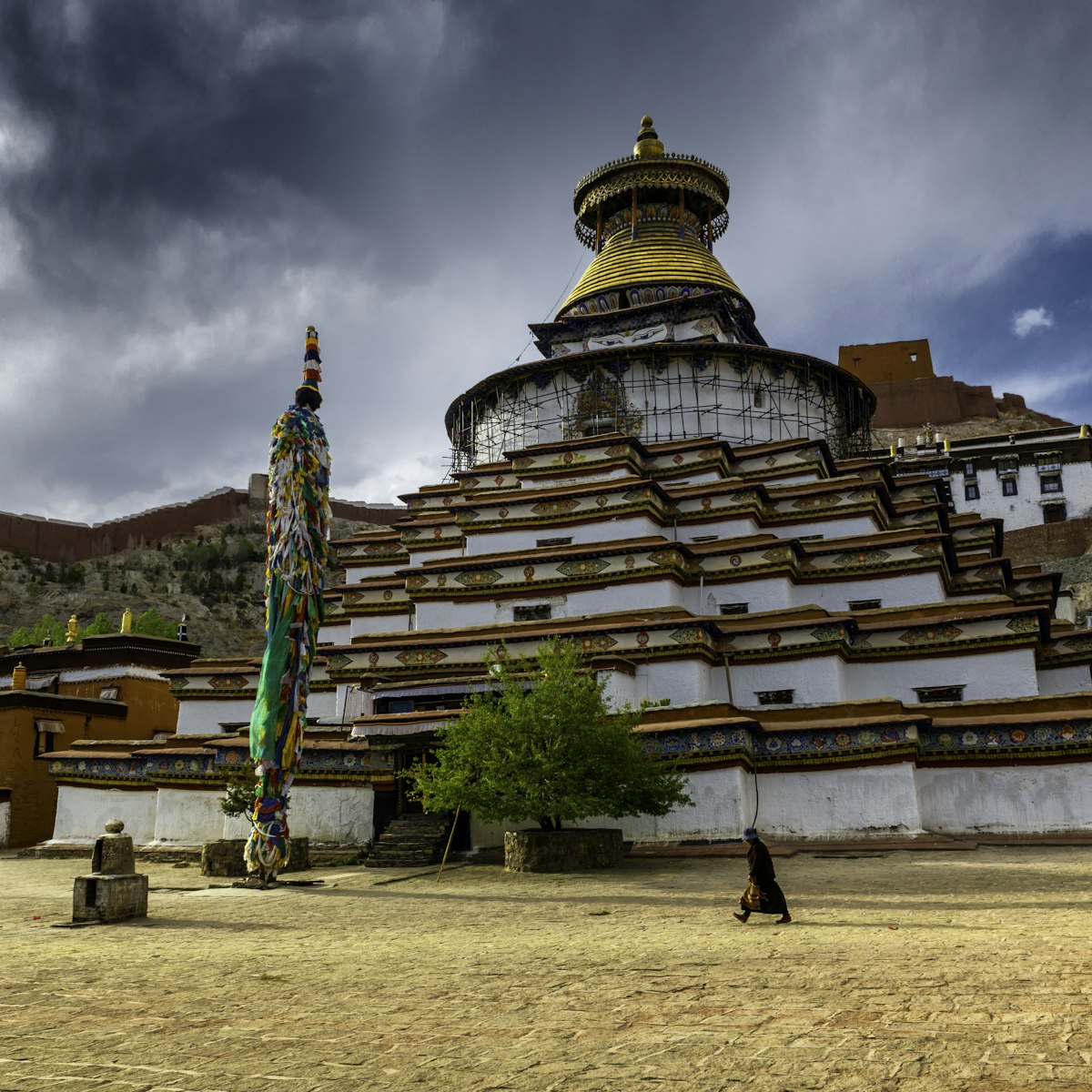
Gyantse Kumbum
Commissioned by a local prince in 1427 and sitting beside Palcho Monastery, Gyantse Kumbum is the town’s foremost attraction. This 32m-high chörten, with…
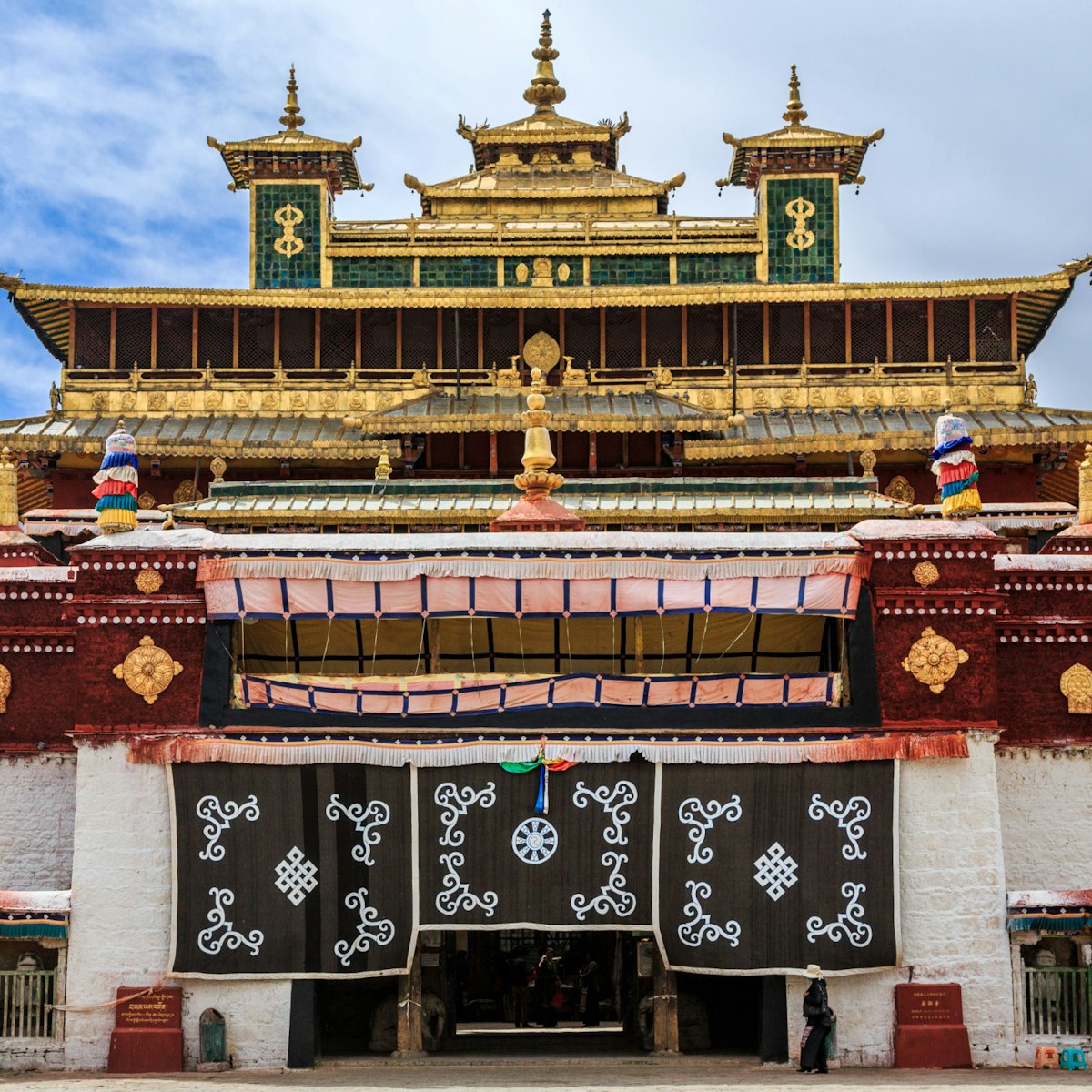
Samye Monastery
About 170km southeast of Lhasa, on the north bank of the Yarlung Tsangpo (Brahmaputra River) is Samye Monastery, the first monastery in Tibet. Founded in…
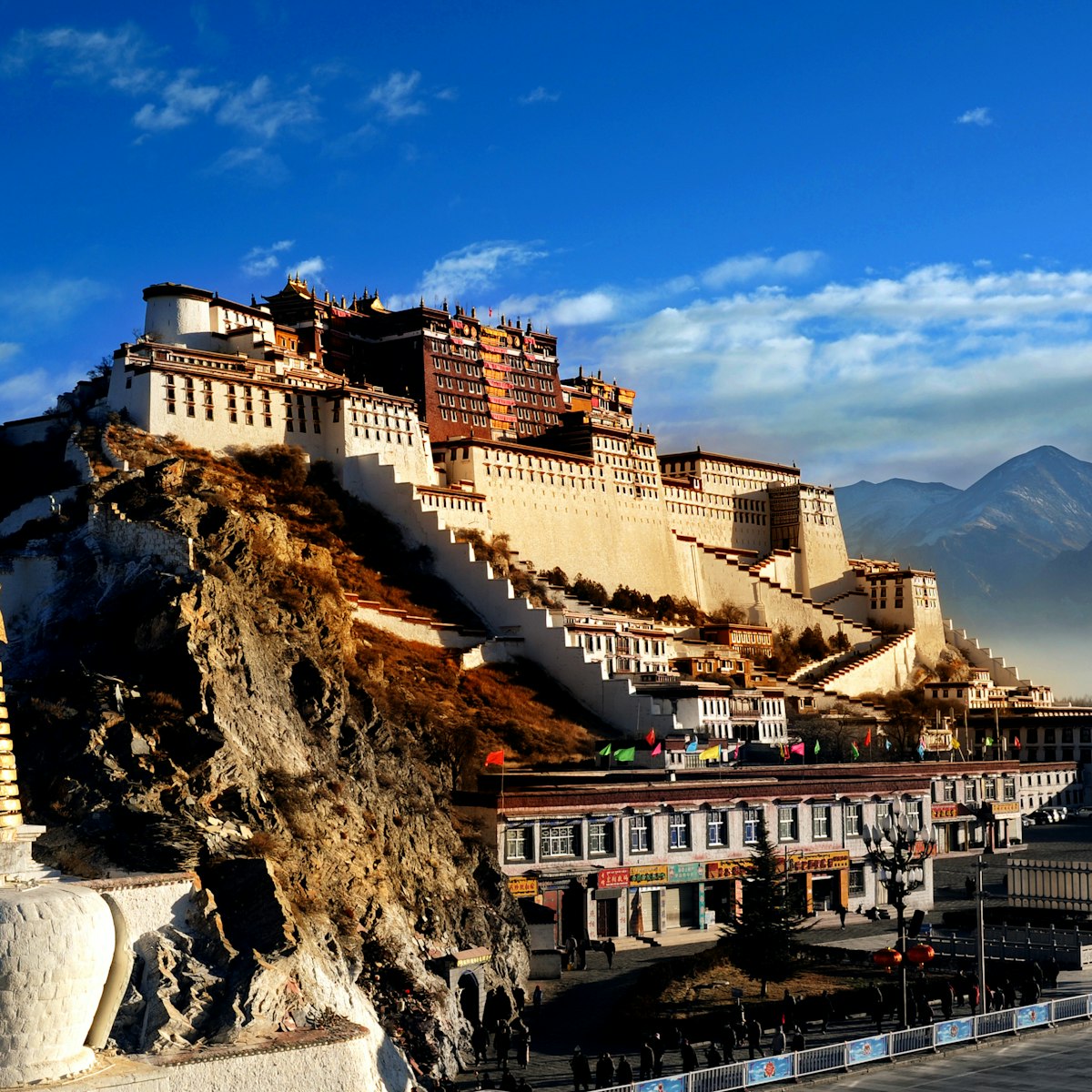
Potala Palace
The magnificent Potala Palace, once the seat of the Tibetan government and the winter residence of the Dalai Lamas, is Lhasa's cardinal landmark. Your…
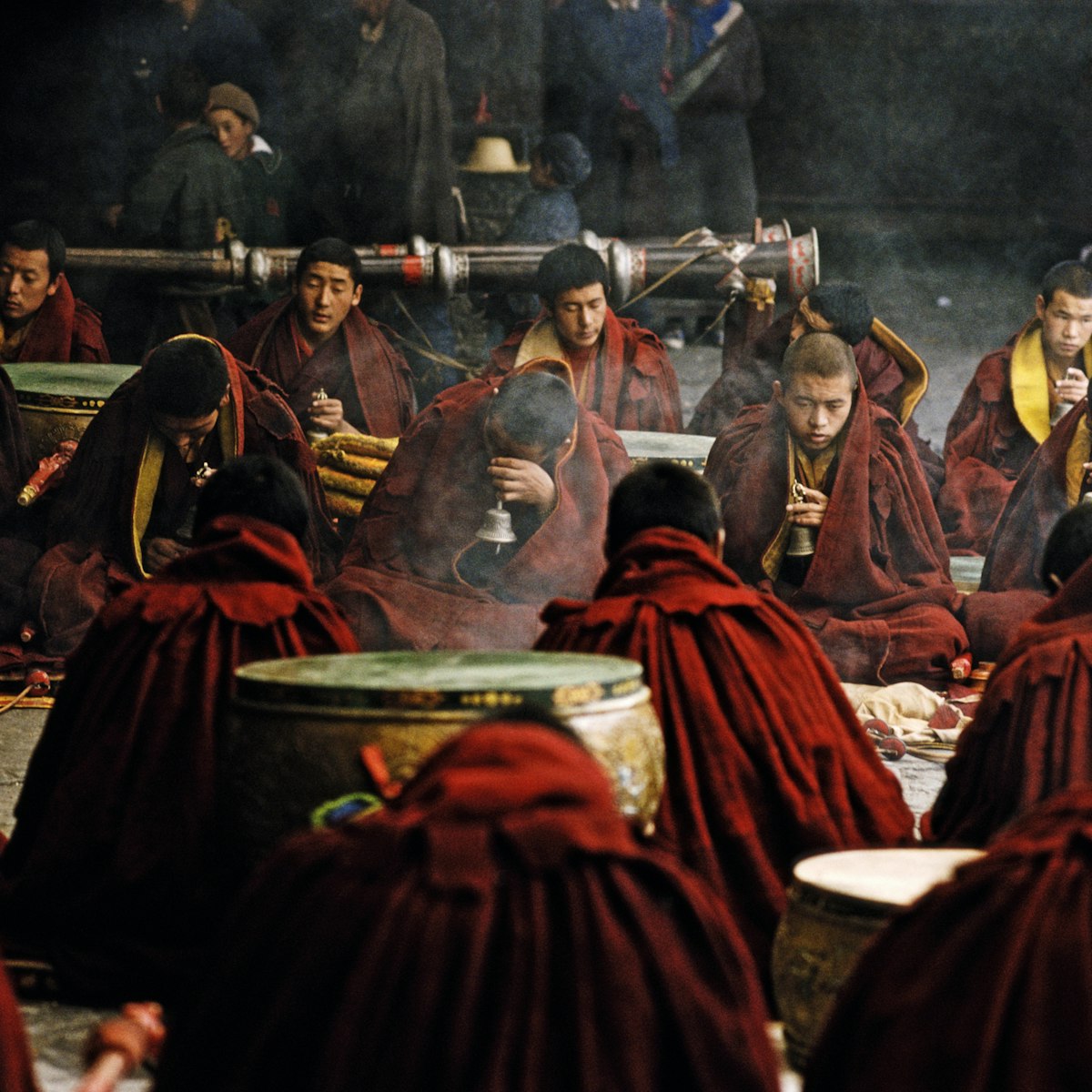
Jokhang Temple
The 1300-year-old Jokhang Temple is the spiritual heart of Tibet: the continuous waves of awestruck pilgrims prostrating themselves outside are a…

Everest Base Camp
Everest Base Camp (5150m) was first used by the 1924 British Everest expedition. Tourists are no longer allowed to visit the climbing expedition base camp…
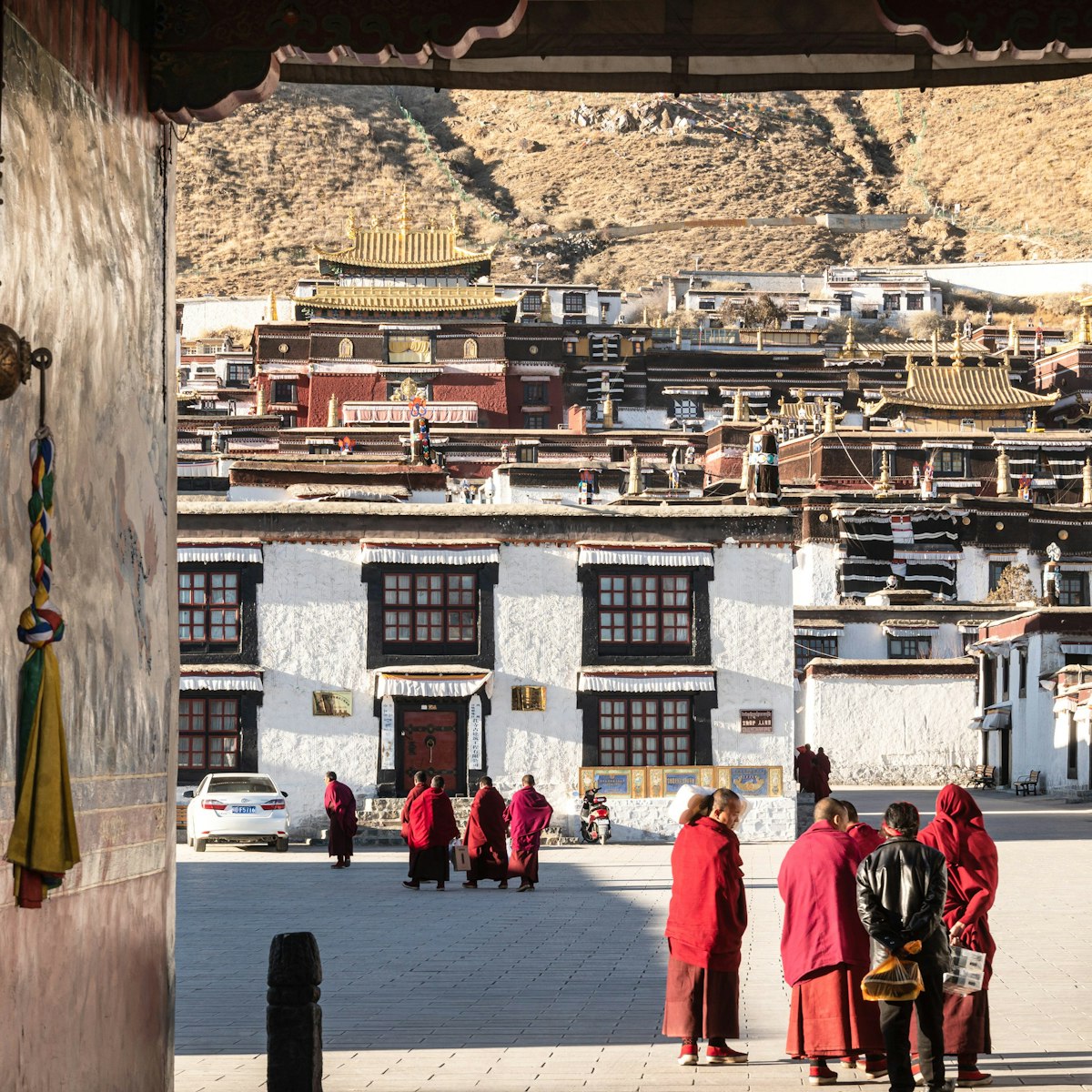
Tashilhunpo Monastery
One of the few monasteries in Tibet to weather the stormy seas of the Cultural Revolution, Tashilhunpo remains relatively unscathed. It is a pleasure to…
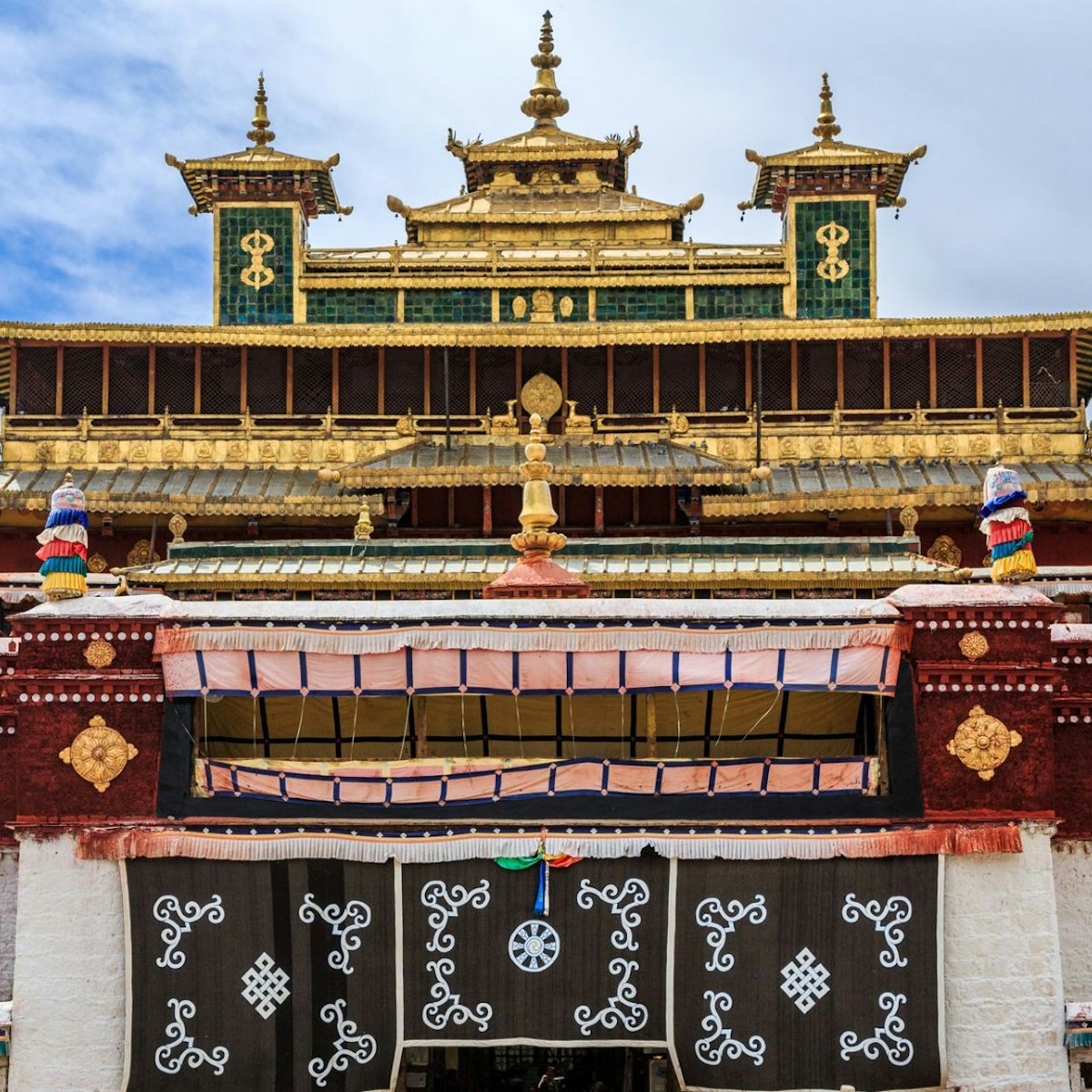
The central building of Samye, the Ütse comprises a unique synthesis of architectural styles. The ground and 1st floors were originally Tibetan in style,…
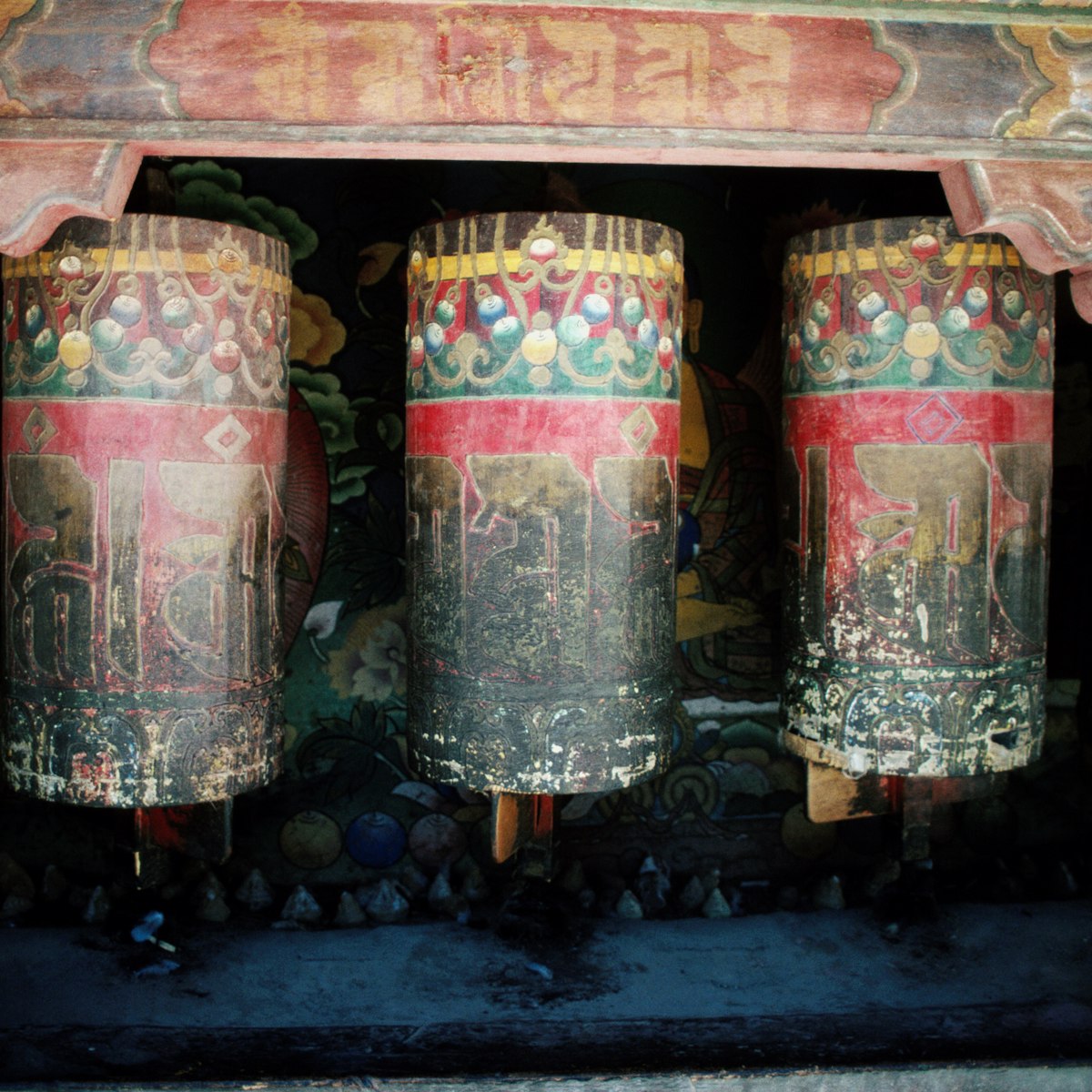
Sakya Monastery
The immense, grey, thick-walled southern monastery is one of Tibet’s most impressive constructed sights, and one of the largest monasteries – home to…
Latest stories from Tibet
Filter by interest:
- All Interests
- Adventure Travel
- Art & Culture
- Beaches, Coasts & Islands
- Food & Drink
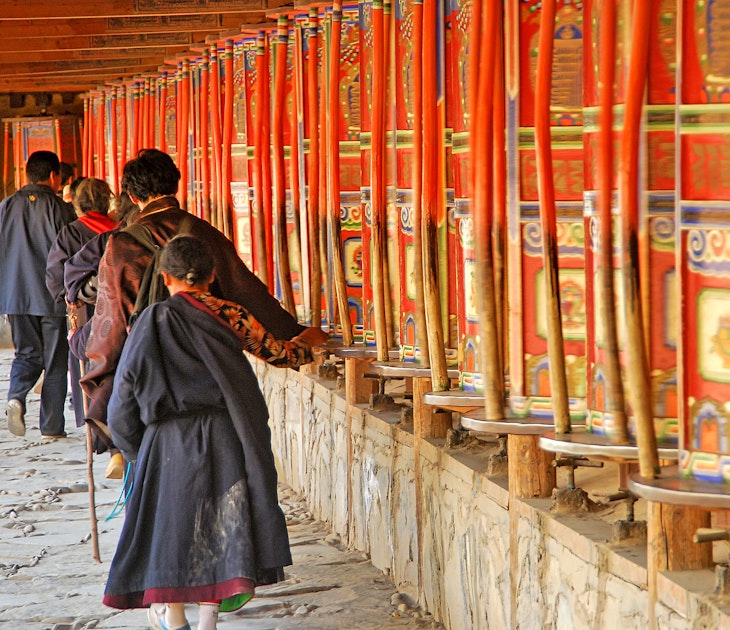
Aug 22, 2019 • 5 min read
Want to visit Tibet but are worried that the obligatory tour-group itineraries are going to stop you seeing the real Tibet? Get out of the tourist rut at these…
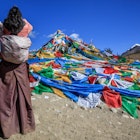
Aug 13, 2019 • 5 min read
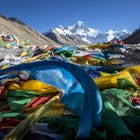
Apr 16, 2019 • 1 min read

Sep 28, 2017 • 5 min read
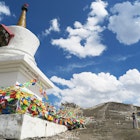
Oct 28, 2014 • 6 min read

Sep 19, 2014 • 6 min read
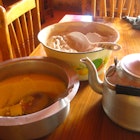
Aug 18, 2010 • 2 min read

Jun 22, 2010 • 3 min read
in partnership with getyourguide
Book popular activities in Tibet
Purchase our award-winning guidebooks.
Get to the heart of Tibet with one of our in-depth, award-winning guidebooks, covering maps, itineraries, and expert guidance.
Tibet and beyond
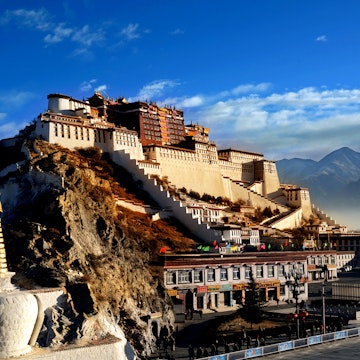
- Destinations
Wild Junket

How to Travel Tibet — My Tibet Travel Guide
Last Updated on January 10, 2022
A detailed Tibet travel guide with all the information on how to travel Tibet, things to do and where to stay in Tibet.
Tibet is called the ‘Roof of the World’ for good reason: With an average elevation exceeding 4,500 metres (14,800 ft), the Tibetan Plateau is sometimes the world’s highest and largest plateau, with an area of 2,500,000 square kilometres (about five times the size of France). Challenging as it may be, here’s my go at how to travel Tibet and get the maximum from this incredible part of the world.
Geography in Tibet is on a humbling scale — dramatic snow-peaked mountains loom over vast plains, zigzagging highways weave their way through high passes draped with colorful prayer flags, while glittering turquoise lakes stand in the shadow of centuries-old glaciers. Home to several of the world’s highest peaks and the famous Everest Base Camp , Tibet has the power to impress even the most hardened traveler.
For those planning a trip to the ‘Roof of the World’, I’ve compiled a detailed Tibet travel guide with information on how to get there, what type of tours to choose, and where to stay in Tibet.

Table of Contents
Why You Should Travel Tibet
How to travel tibet, when to travel tibet, how to get to tibet, how to get around tibet, where to stay in tibet, what to eat in tibet, cost of travel in tibet, safety in tibet, staying healthy in tibet, best places to travel in tibet, check out our regular tibet tours.
But amidst the stunning natural landscapes in Tibet, it’s the people of Tibet that truly moved me. Despite mass modernisation and dilution of their culture under China’s iron fist, Tibet remains a resilient land underpinned by a rich culture and deep faith. 50 years of oppression and religious control have failed to dull the Tibetans’ devotion to their faith.
Today, amidst the kitsch Chinese neon signs, retail stores and fast food chains in Lhasa , it’s still common to see hardcore pilgrims prostrating in koras circumambulating sacred spots around the country.
Magnificent monasteries rich with the aroma of butter tea, prayer halls of chanting monks, and streets lined with prayer wheels all remind us that nobody can take away what is truly Tibetan. The Chinese may have taken away a lot of things from Tibet, but they’ll never take away their identity and faith.

These days, traveling Tibet can be a controversial subject. Many people in the Western world strongly feel that visiting the oppressed nation means that you’re supporting China’s political indoctrination of Tibet. Some people I know would never visit Tibet until it is fully liberalised from the clutches from China. I absolutely understand their point of view and I strongly oppose China’s hard-headed tactics, but visiting Tibet does not mean I’m supporting the regime.
In fact, I think more people should visit so Tibet gets the attention and support from the outside world it deserves. I see travel as the best form of education — only by going there, talking to locals and seeing things from ground level do you truly learn about what’s going on, and can therefore inform others about the state that Tibet is in.

Tourism is highly restricted in Tibet and independent travel is not allowed. Foreign travelers need to prearrange a tour in order to obtain a Tibet Tourism Bureau (TTB) permit; only Chinese and Hongkong travelers are free to enter without a visa. Every company that runs Tibet tours will help you obtain a TTB when you book a tour with them.
Without a TTB permit, you won’t even be able to board a flight or train to Tibet. Besides citizens of Singapore, Brunei and Japan, all visitors require a valid Chinese visa in addition to a Tibet permit. Make sure to get your Chinese visa at least a month before your trip, as your tour operator will need it to get the TTB permit. When applying for your Chinese visa, don’t mention Tibet and don’t list your occupation as ‘journalist’.
I’m glad I chose to run my first WildJunket Tour to Tibet. It’s safe to say everyone in the group enjoyed the trip tremendously and appreciated the great job our local guide and driver did. If you are looking to travel Tibet, we offer regular departures for Tibet tours in 2021.

Tibet can be visited all year round — but the best time to visit is in spring and summer (from April to October) when Tibet’s weather is not too harsh and most areas of Tibet are accessible. This also depends largely on your Tibet itinerary as certain parts can only be visited in summer (e.g. Mount Kailash is covered in snow throughout the year except summer.)
Most Tibetan festivals take place in spring and summer too, including the month-long Saga Dawa Festival (mainly to celebrate the birth of Buddha, enlightenment, and Nirvana) which coincided with my trip, the week-long Shoton festival (Tibetan opera performance and Buddha Thangka unfolding ceremony) and Nagqu horse racing festival. Tibet travel is definitely at its best in spring and summer.
Winter is low season for travel in Tibet, as temperatures can get quite extreme at such high altitudes. I wouldn’t recommend visiting Everest Base Camp then as temperatures can drop to way below 0 degrees Celsius.

Flights to Tibet are quite expensive, and a lot of people suffer from altitude sickness when flying straight into Lhasa. You will have to fly via other cities in China or Kathmandu (the only international transit point) to get to Lhasa regardless of where you’re coming from.
Return flights to Lhasa from Singapore are around US$500 and from Beijing for US$600. I managed to score a pretty cheap flight from Lhasa to Singapore (single way) for US$180 with taxes included.
Another way of getting into Tibet is on the Qinghai-Tibet Railway . This is the highest rail travel in the world, with more than 960 km (600 miles) at an elevation of more than 4,000 m (13,123 ft) and almost half of the tracks built on permafrost. The rail journey starts in Beijing, the Chinese capital, taking a total of 40 hours to get to Lhasa.
But the landscapes only begin to impress from Xining onwards, whizzing past high-altitude lakes, vast plains and mountain passes. Train tickets are not cheap, at around US$280 for a soft sleeper and $200 for a hard sleeper (prices can change depending on season) each way.
Search for Flights to Lhasa

Foreign visitors are not allowed to take public transport in Tibet. As mentioned, you need to arrange a tour in order to enter Tibet and move around the region. Tours always include transportation that will bring you around Tibet.
However, travelers are free to explore Lhasa’s markets, squares and old town on their own. There are plenty of things to do in Lhasa , and you can easily spend a week here exploring the temples, palaces and narrow alleys. You only need to be accompanied by a tour guide when visiting tourist attractions (any monastery and temple). Taxis are easily available in Lhasa and a one-way journey anyway in the city costs only 10 yuan (US$1.50).
We traveled around on a comfortable small bus with enough capacity for 14 people. It wasn’t as big and conspicuous as the ugly big blue buses that Chinese tourists traveled on, and it was good enough to cover long distances and on the hundreds of switchbacks on the Friendship Highway.

Accommodation is included in most Tibet tours. On my Tibet tour , we stayed at comfortable 4-star hotels that offered surprisingly luxurious accommodation right in the heart of Lhasa and Shigatse.
Only one night was spent camping at Everest Base Camp , and even then we stayed in a clean, comfortable big tented camp (for 5 to 8 people in each tent). They provided cushy mattresses and clean quilts. It was rather cold at night, so thankfully the local tour operator provided sleeping bags (with a cleaning fee of US$10).
It is allowed to explore Lhasa on your own and you can easily book hotels in Lhasa online. Prices are pretty affordable — $50 can get you a comfortable three-star hotel in the historical centre.
Here are the Lhasa hotels I recommend:
St Regis Resort Lhasa — The best place to stay in Lhasa, with ultra luxurious and spacious rooms for those who want to splurge after roughing out in rural Tibet. It’s a walk away from town so you’ll need to get a taxi everywhere. Book here.
Lhasa Gang-Gyan Hotel — A comfortable 4-star hotel with high standards of accommodation and an excellent location, just a few minutes’ walk from Barkhor Square. The breakfast spread was impressive. Hotel staff don’t speak English though.
House of Shambala — A boutique hotel brimming with traditional Tibetan flair. We ate at its fantastic restaurant twice and loved it. Rooms are decorated in true authentic Tibetan fashion. Check for rates here.
Tashi Choeta Boutique Hotel — A simple three-star hotel that’s great for the budget traveler. It’s located in the historical quarters, with a charming lounge area in its central courtyard. The hotel’s interior is decorated in traditional Tibetan style, and the service is excellent. Book your hotel here.
Lhasa Gang Gyan Hotel
Inside the tented guesthouse at everest base camp.
Don’t come to Tibet expecting gourmet meals; traditional Tibetan fare is quite simple and basic. Tibetans used to subsist on tsampa (barley flour) and butter tea, but now many Chinese dishes have been introduced to their culinary diet. There’s no shortage of Chinese fare around, but if you won’t find anything beyond that outside of Lhasa.
Most teahouses serve typical dishes like yak momo (steamed dumplings with yak meat), Tibetan noodles in broth, and stir-fried vegetables with rice. Chinese dishes that are usually on the menu include chili chicken, cashew chicken, double fried pork meat, and yak meat with vegetables. They’re pretty good and authentic in my opinion, but can be oily and spicy for some western tastebuds. Only in Lhasa will you find international restaurants that serve pizzas as well as Nepali and Indian thali sets.
Best Restaurants in Tibet
House of Shambala — As I mentioned above, I ate dinner once with the group and we loved it so much that we returned to have our last dinner here. The choice of momos was impressive and the platters of pakhora and other Tibetan-Nepali snacks were excellent. The atmosphere there was great and service was good. Read the Tripadvisor reviews.
Tibetan Family Kitchen — This cosy home-style diner makes you feel like you’re eating in someone’s home. Make your way there through a narrow alleyway, up the stairs through an apartment building and you’ll find yourself in a local home. You not only get to eat home-cooked Tibetan food but you can also try your hand at cooking them. Read the Tripadvisor reviews.
Po Ba Tsang Restaurant — A modern restaurant serving Tibetan and Chinese dishes that are huge in portions and great in flavor. There’s live folklore music for entertainment and also hotpot available for those who want a true culinary experience. Read the Tripadvisor reviews here.

Traveling Tibet isn’t cheap as you need to go on a tour to travel here. It’s especially pricey if you want to spend more than a week here and explore more remote regions. For a week-long tour, expect to pay at least US$900 for all your accommodation, guide and visa.
Because of the stiff competition, tour prices you find online are usually around the same. My WildJunket Tibet Tour was reasonably priced, considering the quality of accommodation, the comfort of our transportation and the great service from our guide and driver. Daily breakfasts were included but not other meals. Our guide usually brought us to affordable places with meals costing around US$5-10 per person.

Tibet has been plagued by civil unrest and anti-government protests since the 1960s when China invaded the nation. More than 140 people are known to have set themselves on fire inside Tibet to call for the Dalai Lama’s return to Tibet, for the Panchen Lama to be freed, and for human rights and freedom in Tibet go be restored. Self-immolation protests peaked in 2012 when more than 80 took place.
Although many monks and nuns have set themselves alight, most self-immolation protesters were normal Tibetans, some were as young as 15 years old. The Chinese government responded to the protests with a surge in activity by security forces, plenty of propaganda campaigns against the protesters and punishments for protester’s families and communities.
During my visit (in May 2017), it was common to find police checkpoints all over Lhasa, with the old town and the Potala Palace in particular heavily guarded by Chinese Police. Security posts were also set up all over Tibet and military presence was everywhere. We had to cross several passport checkpoints across Tibet and plenty of permits and paperwork were involved.
Besides the heavy security, there was no hint of instability or violence.

The capital city Lhasa itself stands at 3,550m above sea level, and Everest Base Camp looms at 5,088m. At such dizzying heights, it can be easy to suffer from AMS (Acute Mountain Sickness) if you don’t take the time to acclimatise to the conditions.
Tibetan people on the other hand are genetically adapted to living at higher altitudes. They have more red blood cells than most of us and that helps them to live with the limited oxygen at high altitudes.
Most people flying into Lhasa suffer from AMS; symptoms include light-headedness, nausea, short of breathe and headaches. Just make sure to get some Diamox (Acetazolamide) before your trip and start the medication at least one day before landing in Lhasa. Give yourself plenty of time to rest and acclimatise in Lhasa before you start exploring.
Tommy suffering from altitude sickness and getting his oxygen fix
- The highlight of our trip was reaching Everest Base Camp , where the highest peak in the world loomed before us. It felt so close that it almost seemed within reach. Sleeping in a tented camp under the starry skies, I couldn’t believe I was literally at the top of the world.
- Our drive to Everest Base Camp on the Friendship Highway was just as spectacular as our destination. The highway climbed up more than 2,000m in altitude via a series of sharp hairpin bends. Scenery along the way featured winding valleys, vast grasslands, meadows and windswept mountain views.
- Watching monks at Sera Monastery debate was such an eye-opening experience. The debates were punctuated with vigorous gestures which made the whole ambience really lively and interesting.
- It was such an honor visiting the legendary Potala Palace, an iconic landmark of Tibet and the most well-known building in the country. This was the fortresslike home of nine Dalai Lamas, but is sadly used as a museum now.
- The scenic route from Shigatse to Lhasa brought us along lime-green barley fields, pristine turquoise lakes, time-warped villages and mountains studded with ochre stupas. It was a full day of driving, but the landscapes were diverse and spectacular. Some of my favourite stops were Gyatse Fort, Yamdrok Lake and Karo-La Glacier.

With this Tibet travel guide, I hope you’ll be able to plan an epic adventure and a trip of a lifetime. If you are interested in joining me on one of my Tibet tours , check out this page for detailed information.
Inspired? Pin it!

Nellie Huang
Nellie Huang is the founder of WildJunket. Originally from Singapore, Nellie has traveled to over 150 countries across 7 continents. She is a book author and Lonely Planet guidebook writer. As an adventure travel blogger, she has a special interest in unusual destinations and deep experiences. Follow her travels on her Facebook and Instagram .
Leave a Comment Cancel Comment
Save my name, email, and website in this browser for the next time I comment.
This site uses Akismet to reduce spam. Learn how your comment data is processed .
The Comments
Astonishing.
Great writing. Thanks for introducing me to Tibet!
Did you have to trek at the Everest Base Camp ? Any tours coming up in 2018?
hi K, you don’t have to trek on the Tibet side. With most tours, you actually get the van all the way to the Everest Base Camp and then do a short hike to the lookout point. I don’t have any Tibet tour coming up in 2018 but you can email me and I’ll put you in touch with my local tour operator.
Your tour sounds interesting. Me and girlfriends are planning to go in October but we are worried of the toilet cleanliness and feeling unwell due to the high altitudes.
Btw do u have any trip planned in Oct?
hey YL, thanks for dropping by! I don’t have any trip to Tibet planned in October but I can help you book a trip if you’re interested. Be sure to bring some Diamox and you should be fine. A few people on my trip didn’t want to take Diamox and suffered quite badly from altitude sickness. It can be rough, you’ll need to be prepared. The toilet cleanliness isn’t something that can be fixed though. Tibet is a spectacular part of the world and there’s nothing quite like it. The devotion of its people, the kindness in their eyes, and the pristine beauty of its nature will make all the challenges of the trip well worth it.
Great blog! Enjoyed reading the info. A pity, there’s no planned trip to tibet in oct, i was also planning for that month. Perhaps u can share the travel operator u work with, would love to work something out.
For the access to tibet, maybe u can advice me on whether flight or train is a better choice from singapore. The train duration seems super long (40+ hrs), the flight seems expensive and difficult to get.
Thank you Mei
Cash'LaTyra Lewisdouglas
Hi, I would like to travel to Tibet with my children ages 2, 10 and 18. Would we be considered a group and how far in advance should I plan leaving from Los Angeles?
Any trip coming up in Aug 2018?
I’m afraid not, but I can book a Tibet trip for you if you like.
Hi, I am interested in going to tibet this august 2018. Can you pass me details of how to organise my trip¿ thanks in advance
Hi Esther, I can connect you with my local partner in Tibet. Just email me! :)
KALYAN GARIMELLA
I am planning for a Honeymoon trip in Tibet this mid of November (2018). I am from India. Let me know if any trips planned and do we require Visa. What’s the budget and how to plan my stay for 5days.
hi Kalyan, I’ll be happy to help you set that up. I will email you. Thanks!
Hi, can you connect me with your partner in tibet? we are going in august.
I would like to go to mount kailash tour
Hi Nellie I am planning to visit Tibet in May 2019. Besides Lhasa, I would like to go Namtso lake and Mt Everest base camp. How many days would this take? Appreciate you can share similar itineraries. Thanks!
We are interested in going to Tibet in 2019. Could you put us in touch with your tour operator? Thank you.
hi Selyn, yes sure, feel free to email me!
I’m interested in a tour to Tibet in late April 2019. Can you please provide me with any information? Thank you.
hi Kenny, please feel free to email me and I’ll connect you with my local tour operator.
Hi Nellie, can you kindly connect me with the local tour operator.
My email address is [email protected]
Bernard Wosk
Hi Nellie, I’m planning a trip to Tibet at the end of May, do you have a trip around that time? If not, can you recommend a tour operator? Thanks, Bernard
I am thinking of taking the train from Xining to Lhasa and then doing a tour from Lhasa to Everest Base Camp. There are any parts of this trip in which the train or car would be riding along the edge of a cliff? I am fine with heights unless I am at the edge so need to prepare myself.
hi Macy, I did almost the same route except that I started the train journey from Beijing. No, the train doesn’t ride along the edge of a cliff. You won’t feel the height. However, the car/bus journey towards Everest Base Camp will bring you on hairpin bends at high altitudes, so be prepared for that. Just try not to sit by the window if it’s gonna scare you. Roads there are surprisingly good (built by the Chinese) so don’t worry about safety.
Hi Nelly I plan to go in may 2019. I’m flying in to lanzhou & plan to take the train to lhasa. will join the ebc tour too if possible. can u advise and gimme contacts of the local tibet tours that can arrange for me? thanks.
hey Sam, yes sure. I’m actually writing an article about visiting the Everest Base Camp as we speak. I’ll email you. :)
Michelle Adams
Hi Thanks for your blog it was very interesting and insightful to read. I do theatre projects in the UK and recently connected with our very small Tibetan community in the UK. I am not really interested in travelling to Tibet with my partner. When is the next time you are travelling there. It would be great to be with someone who knows the country well. Thanks Michelle
hi Michelle, thanks so much for your comment! I’ve received your email as well and will reply you promptly. Cheers!
Hi,i likw to travel to Lhasa,china.Can you please let me know,how to travel from India?
You’ll need to get to Nepal first and from Kathmandu, you can travel overland to Tibet on a tour. Otherwise flying to Lhasa is the fastest way.
Hi, intends to go Lhasa and EBC in April 2019. Appreciate if there’s any tour during that period.
hi SK! I’m setting up an automated booking system for tours to Tibet right now as we speak. It should be up and running this week or the next, so please do check back then! Thank you!
siewchin yong
pian to visit Tibet 2020
I’m about to launch an automated booking system on my site where you can book trips to Tibet throughout 2020.
Riwash Chamlagain
Thanks for your blog I am glad to read this .I like tibet very much it is nice country I do theatre projects in the napel and recently connected with our very small Tibetan community in the nepal. I am not really interested in travelling to Tibet with my partner. When is the next time you are travelling there. It would be great to be with someone who knows the country well. I like tibet very much it is nice country.
You May Also Like
Hiking the tiger’s nest, bhutan, japan with kids: how to plan the perfect japan family trip, review: bluewater sumilon island resort, philippines.

- Top 5 Tibet Tours
- Mt.Everest Adventures
- Cultural & Spiritual Tour
- Tibet Mt.Kailash Tours
- China Tibet Train Tours
- Tibet Trekking Adventures
- Overland Journeys
- Motorbike And Mountain Bike Tours
- Tibet Day Tours
- Tibet Winter tour
- Customise A Tour
- 4 Days Tibet Lhasa Tour Package
- 6 Days Tibet Culture Tour
- 8 Days Lhasa to Kathmandu Overland Tour
- 8 Days Tibet Everest base Camp Group Tour
- 10 Days Easy Acclimatizing Tibet Everest base Camp Tour
- 15 Days Kailash Mansarovar Tour
- Tibet Group Visa & Tibet Permits
- Tibet Travel Permit Online Application
- Tibet Group Visa vs Chinese Visa
- 5 Countries That No Require China Visa to Get Tibet Permit
- Important Tips to Apply the Tibet Group Visa
- How to get to Tibet?
- Tips to avoid high altitude sickness problem in Tibet tour
- Flights to Tibet
- 2024 Tibet Train Ticket Booking
- Hotels and Guesthouses in Tibet
- Meals and Restaurants in Tibet
- How to Plan Tibet Tour
- Health and Safety Guide
- Tibet Travel Maps
- Etiquette & Taboo in Tibet
- Tibet Attractions
- Tibet Travel Packing List
- Tibet Trekking Guide
- Tibetan Buddhism
- Tibet Weather & Climate
- Tibetan Culture & Arts
- Tibetan History
- Why Tibet Group Tours
- 2024 Tibet Festival Calendar
- Monasteries in Tibet
- Transportation in Tibet
- Clients Feedback
- Video Feedback
- Clients Travel Stories
- Why Travel With Us
- Our Community Projects
- We Are Highly Recommended By
- Our Staff Community
- Tibet Responsible Travel
- Privacy Policy
- +86-13398000993(Lhasa)
- [email protected]

- About Tibet

The Ultimate Tibet Travel guide
Tibet is a unique and enchanting travel destination that offers stunning landscapes, rich cultural heritage, and spiritual experiences. From the majestic Mount Everest to the sacred Potala Palace in Lhasa, there is no shortage of awe-inspiring sights to explore in Tibet.
However, traveling to Tibet requires proper preparation and knowledge due to its unique geographical and cultural diversity. It is important to understand that Tibet is an autonomous region of China and has specific travel regulations in place. Obtaining the necessary permits, such as the Tibet Travel Permit, is essential before entering Tibet.

In addition to permits, it is crucial to acclimatize to the high altitude and take precautions to ensure a safe and enjoyable trip. Altitude sickness can be a concern for travelers, so it is recommended to gradually ascend to higher altitudes and allow time for acclimatization. It is also important to be aware of the weather conditions and pack accordingly, as Tibet experiences extreme temperature variations throughout the year.
Furthermore, understanding and respecting Tibetan culture and customs is essential when visiting this spiritual land. Tibet has a deeply rooted Buddhist tradition, and travelers should be mindful of local customs, dress modestly, and show respect when visiting monasteries and sacred sites.
Traveling to Tibet can be a transformative experience, but it requires proper preparation and knowledge. By being well-informed about regulations, acclimatization measures, and cultural etiquette, travelers can ensure a memorable and respectful journey in this extraordinary destination.
Table of Contents
Challenges to Travel to Tibet
Traveling to Tibet presents unique challenges that travelers should be aware of. One of the main challenges is altitude sickness, which can have a significant impact on travelers. Tibet is known for its high altitude, with many areas exceeding 4,000 meters above sea level. This can lead to symptoms such as headaches, dizziness, and shortness of breath. It is important for travelers to acclimatize properly by spending a few days in lower-altitude areas before ascending to higher altitudes.
Another challenge is the limited infrastructure and resources in remote areas of Tibet. While major cities like Lhasa have modern facilities, more remote areas may have limited access to amenities such as electricity, clean water, and food. Travelers should be prepared for basic living conditions and carry essential supplies like food, water, and medication.
Cultural and religious considerations are also important when traveling to Tibet. Tibet has a rich Buddhist heritage, and it is important to respect the local customs and traditions. Visitors should dress modestly, avoid taking photographs in sensitive areas, and be mindful of religious practices and rituals.
Despite these challenges, traveling to Tibet can be a rewarding and unforgettable experience. The stunning natural landscapes, vibrant culture, and spiritual atmosphere make it a destination like no other. With proper planning, preparation, and respect for the local culture, travelers can navigate the unique challenges and have a memorable journey in Tibet.

Tibet Group tour
How to avoid altitude sickness?
Preparing physically and mentally for a trip, especially if it involves high altitudes , is crucial for a safe and enjoyable experience. Here are a few tips to help with acclimatization to high altitudes:
First, it is important to gradually ascend to higher altitudes. This allows your body to adjust slowly to the decrease in oxygen levels. If possible, spend a few days at intermediate altitudes before reaching your final destination.
Staying hydrated is also essential. Drinking plenty of water helps to prevent altitude sickness and aids in acclimatization. It is recommended to drink at least 3-4 liters of water per day while at high altitudes.
Taking it easy and allowing yourself time to rest is another important aspect of acclimatization. Avoid overexertion and listen to your body. If you start feeling symptoms of altitude sickness, such as headaches, dizziness, or nausea, it is crucial to descend to a lower altitude until you feel better.
In terms of physical preparation, it is advisable to have a good level of fitness before embarking on a trip to high altitudes. Regular cardiovascular exercise, such as hiking or running, can help improve your endurance and oxygen uptake. Additionally, incorporating strength training exercises that target the muscles used in hiking or trekking, such as your legs and core, can be beneficial.
Lastly, mental preparation is just as important as physical preparation. High-altitude trips can be physically challenging and mentally demanding. It is important to have a positive mindset, be mentally prepared for physical exertion, and understand the potential risks and challenges that come with high-altitude travel.
By following these tips and adequately preparing yourself both physically and mentally, you can increase your chances of having a safe and enjoyable trip to high altitudes.

Summer in Tibet
Travel Permits required during Tibet travel
Obtaining necessary permits and documents is of utmost importance when it comes to travel, especially in certain areas or for specific activities. One such example is the Tibet Travel Permit , which is required for foreign tourists to enter Tibet. This permit is issued by the Tibet Tourism Bureau and is necessary in addition to a Chinese visa.
To obtain the Tibet Travel Permit, travelers must be part of an organized tour group and have their itinerary planned by a registered travel agency. They must also provide a copy of their passport and Chinese visa, as well as provide information about their occupation and purpose of visit. It is crucial to obtain this permit before entering Tibet, as failure to do so can result in denial of entry.
In addition to the Tibet Travel Permit, there may be other permits and documents required for specific areas or activities. For example, certain areas or national parks may require special permits for entry or activities such as trekking or wildlife photography. These permits are often issued by local authorities or park management and may require additional documentation such as proof of insurance or specific qualifications.
It is important to research and understand the specific requirements for the area or activity you plan to engage in and ensure that you obtain all necessary permits and documents in advance. Failure to do so can result in penalties, fines, or even legal consequences. Additionally, obtaining the necessary permits and documents not only ensures compliance with local regulations but also helps protect the environment, cultural heritage, and overall safety of the area.

Things to pack for a trip to Tibet
When preparing for a trip to Tibet, it is important to pack the right essentials to ensure a comfortable and enjoyable experience. One of the first things to consider is clothing and gear suitable for varying weather conditions.
Tibet has a high altitude and can experience extreme temperature changes throughout the day. It is recommended to pack layers of clothing that can be easily added or removed as needed. This includes warm jackets, sweaters, long-sleeved shirts, and thermal undergarments. Additionally, it is important to bring sturdy walking shoes or boots for exploring the rugged terrain.
Another crucial aspect of packing for a trip to Tibet is medications and personal items. Travelers should make sure to pack any necessary prescription medications, as well as basic first aid supplies such as band-aids, pain relievers, and altitude sickness medication. It is also advisable to bring personal toiletries, including sunscreen, lip balm, and moisturizer, as the high altitude and strong sun can cause dryness and dehydration.
When packing for a trip to Tibet, it is important to consider the varying weather conditions and pack appropriate clothing and gear. Additionally, bringing necessary medications and personal items will ensure a comfortable and safe journey.
Responsible Tibet travel
When traveling to a new destination, it is important to understand and respect the local customs and traditions. This is especially true when visiting places with rich cultural heritage, such as Tibet. In Tibetan culture, there are certain etiquette and behavior expectations that visitors should be aware of.
Firstly, it is important to dress modestly and respectfully when visiting Tibetan communities. This means avoiding revealing or provocative clothing, and instead opting for more conservative attire. It is also customary to remove your shoes before entering someone’s home or a religious site, so be prepared to do so.
Additionally, showing respect for elders and authority figures is highly valued in Tibetan culture. It is considered polite to greet people with a slight bow or nod of the head and to use formal titles when addressing individuals of higher social status. Taking the time to learn a few basic greetings and phrases in the local language will also be greatly appreciated.

When visiting religious sites in Tibet, it is crucial to be mindful of their significance and purpose. Many of these sites hold deep spiritual meaning for the local community, so it is important to behave respectfully. This includes refraining from loud or disruptive behavior and avoiding any actions that may be considered disrespectful or sacrilegious.
Participating in local customs and practices can also be a meaningful way to show respect for Tibetan culture. For example, joining in traditional dances or ceremonies, or taking part in Buddhist rituals, can be a way to connect with the local community and gain a deeper understanding of their traditions.
By understanding and respecting the local customs and traditions in Tibet, visitors can have a more meaningful and respectful experience, while also contributing to the preservation and appreciation of this unique cultural heritage.
What to expect with transportation and accommodations in Tibet?
When it comes to navigating transportation in Tibet, there are a few options available. One popular choice is to hire a private driver or join a guided tour. This allows you to have a dedicated vehicle and driver who can take you to various destinations in Tibet . It is a convenient option, especially if you are not familiar with the area or prefer to have a local guide. Another option is to use public transportation, such as buses or trains.
Tibet has an extensive network of bus routes that connect major cities and towns, making it a cost-effective option for budget travelers. Trains are also available, with the Qinghai-Tibet Railway being the most popular route.
It offers breathtaking views of the Tibetan plateau and is a unique way to experience the region. However, it is important to note that transportation in Tibet can be challenging due to the high altitude and rugged terrain. It is recommended to plan your itinerary in advance and consider acclimatization time.

In terms of accommodations in Tibet, there are various options to choose from. The most common are hotels and guesthouses, which can be found in major cities and tourist areas. These range from budget accommodations to luxury hotels, depending on your preferences and budget. It is advisable to book in advance, especially during peak travel seasons, as availability may be limited.
If you prefer a more immersive experience, you can also consider staying in traditional Tibetan homes or monasteries. This allows you to get a glimpse of the local culture and way of life. However, these accommodations may have basic facilities and amenities, so it is important to be prepared for a more rustic experience.
Camping is another option for those who enjoy outdoor adventures. There are designated camping areas in national parks and trekking routes, but it is important to obtain the necessary permits and follow responsible camping practices. Overall, Tibet offers a range of accommodation options to suit different preferences and budgets.

Is Tibet safe to travel?
When going on a trip, it’s important to prioritize your safety and health. Here are some tips to help you stay safe and healthy during your travels.
One common issue that travelers may face is altitude sickness, especially when visiting high-altitude destinations. To prevent altitude sickness, it’s recommended to acclimatize slowly by gradually ascending to higher altitudes. Stay hydrated, avoid alcohol and caffeine, and consider taking medication such as acetazolamide as advised by a healthcare professional. If you do experience symptoms like headaches, dizziness, or nausea, rest and descend to a lower altitude until you feel better.
Food and water safety is another important aspect of staying healthy during your trip. Be cautious about where and what you eat. Stick to reputable establishments and avoid street food that may not have been prepared hygienically. Drink bottled water or use water purification methods such as boiling or using water purifying tablets. Additionally, be mindful of the cleanliness of utensils and wash your hands frequently with soap or hand sanitizer.
In general, it’s a good idea to pack a basic first-aid kit with essential items such as band-aids, pain relievers, antiseptic wipes, and any necessary prescription medications. It’s also important to have travel insurance that covers medical emergencies.
Lastly, listen to your body and take breaks when needed. Traveling can be exhausting, so make sure to get enough rest and sleep. Stay active and incorporate exercise into your daily routine to keep your body healthy and fit.
By following these tips and taking necessary precautions, you can have a safe and healthy trip. Remember to consult with a healthcare professional or travel advisor for specific advice based on your destination and individual health needs.

Tibet Group Tour
A successful trip to Tibet requires thorough preparation and research. It is essential to familiarize yourself with the local customs, weather conditions, and any necessary permits or visas. This will help ensure a smooth and enjoyable journey.
Additionally, it is important to embrace the unique experiences and challenges that come with traveling to Tibet. The region offers breathtaking landscapes, rich cultural heritage, and spiritual enlightenment. However, it can also present altitude sickness and limited infrastructure in some areas. By approaching these challenges with an open mind and a positive attitude, travelers can fully appreciate the beauty and significance of their journey.
Finally, it is always advisable to travel responsibly and respectfully. Tibet is a sacred place for many people, and it is important to be mindful of local customs and traditions. This includes dressing modestly, seeking permission before taking photographs of people or religious sites, and respecting the environment.
With careful planning, a spirit of adventure, and a respectful mindset, travelers can have a truly transformative experience in Tibet . So go ahead, embark on your journey to this mystical land, and create memories that will last a lifetime.
- Share This Post:
Recent Posts

Tibetan Spiritual Tours in Tibet

The Best Time to Visit Tibet
A guide to tibet tours, all categories.
- book a Tibet tour
- Buddhism Practice
- Budget Tour
- China-Tibet Train
- Customized Tibet tour
- Historical Sites
- Hot Springs in Tibet
- Photography in Tibet
- Tibet attraction
- Tibet Group Visa
- Tibet Motorcycle Tour
- Tibet Small Group Tours
- Tibet Tours and Tibetan Tour Guide
- Tibet Train
- Tibet Travel FAQs
- Tibet Travel Information
- Tibet Travel News
- Tibet Travel Permit Update
- Tibet Travel Prices Rises
- Tibet Trekking Tour
- Tibet weather and climate
- Tibet Wildlife animals
- Tibet Winter Tour
- Tibetan Cultural Features
- Tibetan Culture and Poeple
- Tibetan Festivals
- What to see in Tibet
Reset Password
- Skip to primary navigation
- Skip to main content
- Skip to primary sidebar
- Skip to footer
TravelAwaits
Our mission is to serve the 50+ traveler who's ready to cross a few items off their bucket list.
9 Things To Know Before Visiting Tibet

- Destinations
- News and Tips
- Travel With Confidence
Monks, monasteries, and mountains. Tibet is one of the most unique places you will ever visit. Known as the “Roof of the World,” the “Third Pole,” or the “Land of Snows,” Tibet is one of the most intriguing and mysterious places in the world. This massive, land is home to Buddhist Monasteries, historical sites, vast snow-capped Himalayan Mountains, hairy yaks, beautiful landscapes, and wonderful people.
Planning a trip to Tibet can be a little daunting, given its remote location and political situation, not to mention the permits you need and the stringent government travel requirements. But with a few tips and hints for planning and traveling in Tibet, you can make the trip to the Roof of the World one of the most amazing journeys of your life.

1. Where Is Tibet?
A lot of people seem to confuse Tibet with Nepal, perhaps because both are Himalayan countries, they share a border and share the summit of Mount Everest. On a map, Tibet is in the heart of Asia between mainland China and India. The vast, high-altitude Tibetan plateau borders Nepal, Bhutan, Burma, mainland China and Xinjiang (East Turkestan).
2. Is Tibet Open To Tourists, And Can I Enter With A Chinese Visa?
Tibet is generally open to foreign travelers except in February and March each year. To enter what China calls the Tibet Autonomous Region, you will need both a Chinese visa and a special Tibet permit. Tibet travel permits are issued by the Chinese government, but only through a certified Tibet travel agency.
3. Can I Travel Independently In Tibet?
Like it or not, the short answer is no, you cannot travel in Tibet on your own (unless you are a Chinese or Hong Kong national). You must be part of a pre-arranged tour and you must travel with a certified Tibet travel agency representative. You will have to book a tour with a Tibetan travel agency, that will then arrange all your travel inside Tibet, including permits, accommodation, entry to attractions, in fact pretty much everything, making it much easier to plan your trip. The good news is that your “organized tour” can actually be a private tour — just you, or you and your choice of traveling companions.

4. Is It Safe To Travel In Tibet?
Tibetans are a friendly people, and major crime is not common. Tibet is a safe place, probably safer than many other countries around the world. A few minor incidents do occur, such as pickpockets and minor thefts, and you can find a few scams, which are generally easy to avoid. But bearing in mind that you will always be accompanied by your guide, there’s not much that can go wrong, even solo female travelers can feel safe in Tibet.
5. Will I Get Altitude Sickness?
With an average elevation of 14,750 feet, altitude sickness is a common complaint when traveling to Tibet, though it normally passes in a day or two. The main symptoms of altitude sickness include headaches, nausea, dizziness, vomiting, lack of appetite, and insomnia. The good news is that there are basic steps you can take to prevent altitude sickness from ruining your trip. I’d recommend resting for a couple of days when you arrive in Lhasa, allowing your body to adapt and also asking your doctor if you are a candidate for Diamox, (the most effective medication for altitude sickness).

6. When Is The Best Time To Visit Tibet?
The main season for travel to Tibet is from April to October when the weather is at its best for trekking, sightseeing, and generally traveling around. Given its location on a high plateau, Tibet experiences low temperatures and frost most of the year. Summer is the only time when temperatures get to around 70 degrees Fahrenheit during the day. As a bonus, oxygen content is higher in the summer, making it easier to acclimatize. Spring and fall are also good times, if you’re looking to beat the summer crowds, but expect chilly nighttime temps. Winter is characterized by freezing temperatures.
It’s important to take into account that entry permits are not given to foreigners from February to March (this is the time of some sensitive anniversaries, particularly the 2008 rebellion that caused all these travel restrictions in the first place). I’d also suggest avoiding Chinese national holidays during the first weeks of May and October when Chinese tourists swarm Tibet.
7. How Can I Get To Tibet?
The most common way to get to Lhasa, Tibet, is by train or airplane. Flights depart daily from several cities in mainland China, as well as from Kathmandu in Nepal. Trains run regularly from several major cities in China. The best way to travel to Tibet, and adjust to the altitude, is to take the train from Xining to Lhasa. It’s a 21-hour-long trip, but it’s a scenic journey on the world’s highest railway.
For those starting in Nepal, you can fly or travel overland with your guide and driver. Traveling overland can put you at a higher risk of getting altitude sickness, so flying tends to be the better option. Bear in mind, if coming from Nepal you will have a different and stricter kind of visa, a “Tibet Group Visa,” that does not allow travel onward into mainland China.

8. What Are The Best Places To Visit In Tibet?
Tibet has so much to see, from its magnificent natural scenery to its mysterious religious culture. You won’t be able to see everything on your first trip, so let me point you in the direction of some of the unmissable places you should have on your itinerary.

Tibet’s capital city of Lhasa is one of the most fascinating cities in the world. This is a city in a time warp, stuck between the modern world and ancient traditions. The city revolves around Barkhor Square, at the center of which is the Jokhang Monastery, Tibet’s most sacred temple. It is here you will see pilgrims murmuring prayers as they complete their journeys of devotion, prostrating themselves in front of the temple or circling around it in a clockwise direction.
There is nothing quite like seeing the golden-roofed Potala Palace, the former residence of the Dalai Lama, rising above the city center. This is the largest and most complete ancient palace building complex in Tibet, containing 13 stories and 1,000 rooms. Building commenced in the 7th century, and reconstruction was undertaken by the 5th Dalai Lama in 1645. This is a holy place for Tibetan Buddhists and attracts thousands of visitors and pilgrims annually.

You should also visit the “Three Great Tibetan Monasteries,” Drepung, Sera, and Ganden, which lie on the outskirts of Lhasa. Drepung is a complex of many temples and prayer halls, while Sera is famous for daily (3 p.m.) traditional debates among the monks. Ganden, at an altitude of 12,000 feet on Wangbori Mountain makes for a great hike (though you can drive). You are quite likely to see vultures, the sacred birds of Tibet, on a visit here.

Yamdrok Lake is a freshwater lake about 60 miles south of Lhasa. The lake is regarded as one of the three holy lakes in Tibet. This beautiful lake is over 44 miles long and looks a little like a coiling scorpion. It’s a main stop along the route from Lhasa and Nepal, and you can usually find local Tibetans waiting here with their yaks and mastiffs, offering tourists an opportunity for a particularly scenic selfie.
Tashilhunpo Monastery, on Mt. Nyima near Shigatse, Tibet’s second-largest city, is definitely worth a visit. Covering an area of 37 acres, the monastery has 57 halls, 3,600 rooms and can hold 2,000 worshipers.

Mt Everest, the highest mountain in the world, straddles the Nepal and Tibet border, and it’s easily accessible from the Tibetan side. Private vehicles are no longer allowed at Everest Base Camp (EBC) on the Tibetan side, instead, there is an eco-bus service. Similarly, camping is no longer permitted at the former base camp, instead, travelers can stay in a tented camp near the Rongbuk Monastery, which at over 17,000 feet above sea level, is the highest monastery in the world. Hikers can choose to trek the route from Tingri to EBC, a distance of 43 miles over four days.

Mount Kailash, in Tibet’s far west, is a sacred mountain, recognized as the “center of the world” by Tibetan Buddhism, Hinduism, Bon, and Jainism followers. The mountain attracts a continuous stream of pilgrims, both Hindus from nearby India, and Buddhists, who come here to perform a Kora , the ritual circumnavigation of the mountain. Pilgrims believe they can erase the sins from a previous life by doing one Kora, avoid the pain of reincarnation by doing additional Koras, and can turn into a Buddha by doing 100 Koras. Aside from any religious significance, Mt. Kailash is worth a visit. Situated at the southern foot of Mt. Kailash, Lake Manasarovar, a sacred freshwater lake, is another pilgrimage destination, revered both in India and Tibet.
9. What Kind Of Food Do They Eat In Tibet?
Tibetan food and drink, like the country’s culture and religion, has its own unique character. The most common dishes reflect what plants and animals are able to survive at an average altitude of 16,000 feet. The daily diet of most Tibetans includes tsampa , butter tea, yak meat, and mutton.
The traditional staple food of Tibet is tsampa, a flour made of roasted highland barley and Tibetans eat it three times a day. Tibetans consume copious amounts of tea, both salted butter tea, and sweet milk tea, they also eat a lot of yak-related meat and dairy products. Yak meat is quite lean, mild, and beef-like and not as weird as it may sound. It’s a common misconception that Tibetans are vegetarians, but yak, beef, mutton, and goat are all consumed. Fish, though, are not popular or common.

Tibet has so much to see and do, from stunning mountain landscapes to fascinating religion, culture, and customs. You could find yourself in a prayer hall full of chanting monks, experiencing an unforgettable mountain trek, or perhaps making the epic Tibet – Nepal overland journey, along some of the world’s wildest roads. The experiences are limitless.
Tibet is an exotic destination, and there are myriad things to discover:
- Visiting Tibet: 9 Fascinating Things To See And Do
- Climbing Mount Everest: What To Know About The Ultimate Bucket List Experience
- 5 Strange Places You Cannot Travel Alone

Born and raised in Sydney, Australia, before moving to Africa at the age of 21, Sarah Kingdom is a mountain climber and guide, traveler, yoga teacher, trail runner, and mother of two. When she is not climbing or traveling she lives on a cattle ranch in central Zambia. She guides and runs trips regularly in India, Nepal, Tibet, Russia, and Ethiopia, taking climbers up Tanzania’s Mount Kilimanjaro numerous times a year.

Borders Of Adventure
Leading Culture and Adventure Travel Blog by Becki Enright. Looking at the world with a different angle to change perceptions of misunderstood places, for the best in travel.
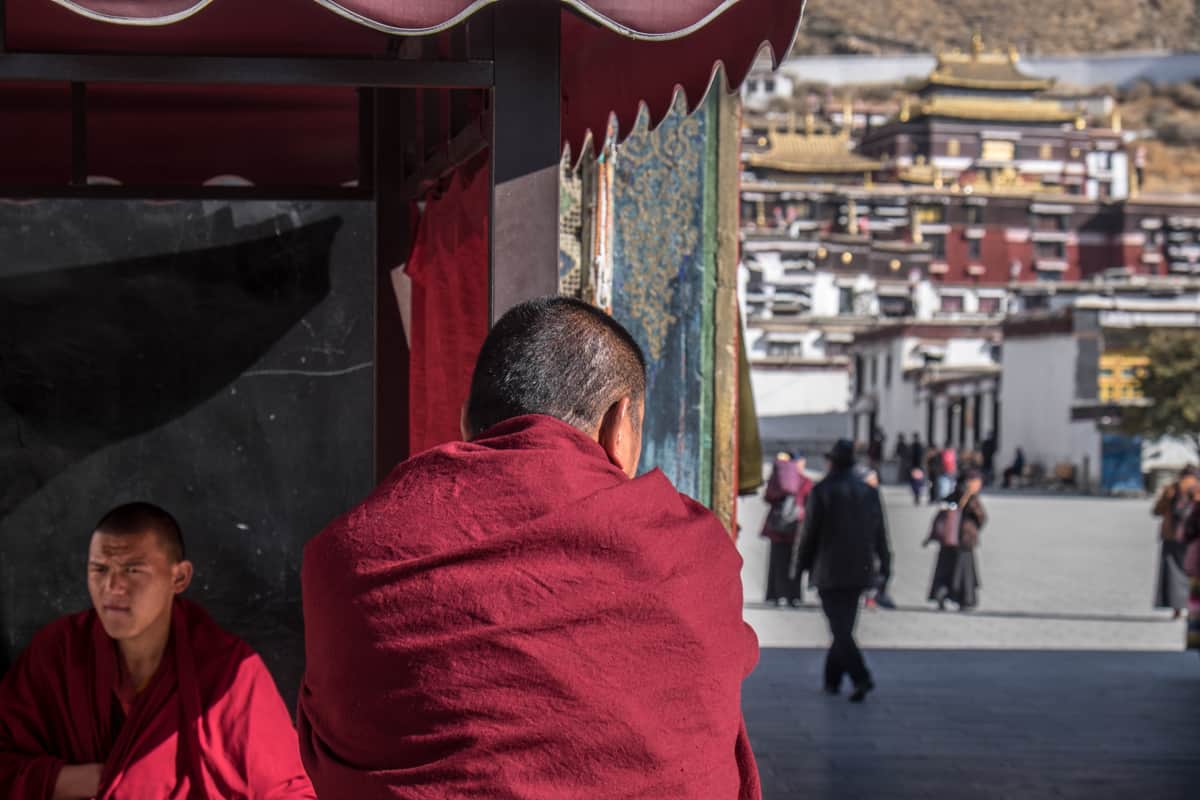
Misunderstood Destinations , Tibet
This is How to Travel Tibet – The Reality of the Roof of the World
Disclaimer: This post contains affiliate links to handpicked partners, including tours, gear and booking sites. If you click through or buy something via one of them, I may receive a small commission. This is at no extra cost to you and allows this site to keep running.
How to travel Tibet and experience its ancient culture. Everything you need to know about how to enter, getting around, and the truth in visiting.
To be able to travel to Tibet is both a privilege and a different kind of experience that requires some degree of more profound observation. What was once closed off to outsiders and one of the most isolated cultures globally is now an Autonomous Region of China. Therefore, it is more tricky to traverse since you can’t travel there independently.
While China heavily manages Tibet tourism, visiting means helping to keep Tibetan culture alive and experiencing those pockets of Tibetan Buddhism so profoundly entrenched in the form of spiritualism you won’t witness anywhere else.
Your visit is about using your freedom to return home to tell the world about it.
You won’t forget your time in Tibet easily, but it is a place where some pre-romanticised ideas shatter, and you leave with more questions and emotions than when you first arrived. It’s a mix of fascinating otherworldly spiritualism in mountainside monasteries and palaces and nunneries and temples. It’s the sadness at seeing a long history eroded that conflicts with such remarkable beauty.
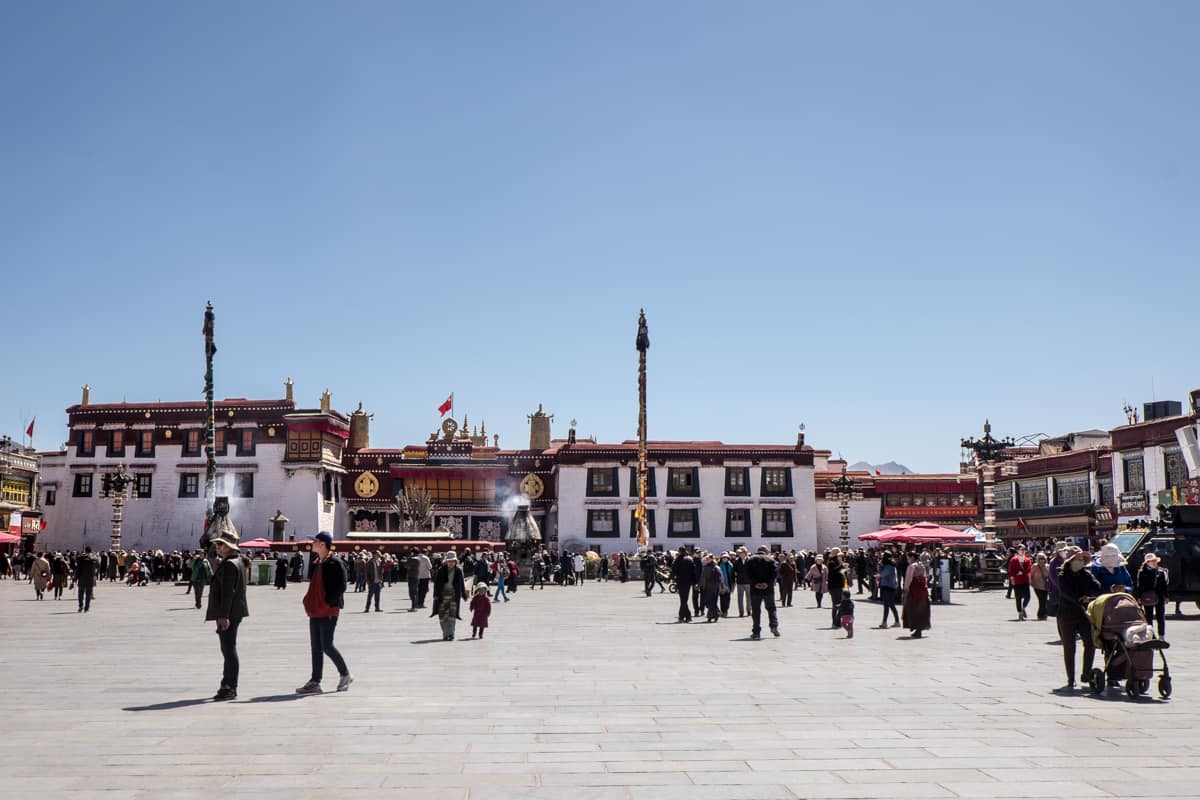
Tibet Today
Why you should travel to tibet, the reality of tibet travel, getting a group visa for tibet, travel tibet from china, travel tibet from nepal, getting around tibet, the best time to visit tibet, how much does it cost to travel to tibet, is tibet safe to travel, responsible travel in tibet, rombuk and everest base camp tibet, kyirong border town to nepal, essentials and extras, avoiding altitude sickness in tibet, travel to tibet guide – pin it.
What remains of old and sacred Tibet – left untouched after China’s occupation in 1950 that turned Tibet into what is now known as the Tibet Autonomous Region – is a testament to its mysterious and spiritual history and the retelling of it.
Today, seeing Tibet is about getting lost in an ancient culture that dates back to nearly 1,500 years, set within lake-filled valleys and rocky plateaus. To set foot inside some of the world’s oldest monasteries and temples, flanked by the endless peaks and ridges of the Himalayas that naturally hug Tibet in protection, with mighty Everest watching over.
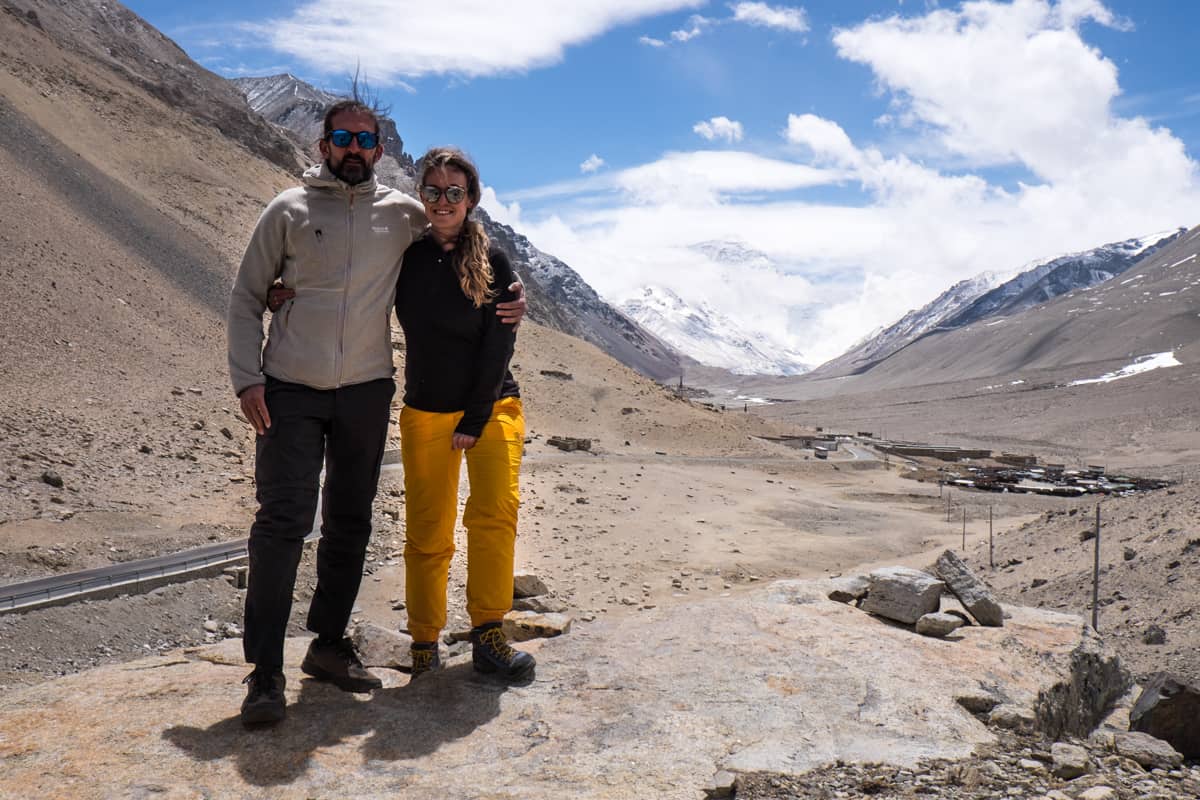
The view of Mount Everest near Everest Base Camp, Tibet
It’s about understanding that while there are plenty of things to see in Tibet, swaths of its original wonder no longer exist. Patches of a far-reaching space we should not take for granted as visitors here when so much has already been lost.
Tibet is best experienced via an overland tour and one covering a lot of ground. On the two-week High Road to Tibet trip with G Adventures , I flew from Kathmandu to Lhasa, spent four days in the Tibetan capital before moving on to Gyantse, Shigatse, Rombuk and Everest Base Camp Tibet for the final highlight. An overnight stay in the border town of Kyirong was the last stop before the long and scenic drive back to Kathmandu.
Choosing exactly how to travel in Tibet and embarking on this particular trip goes hand in hand with travelling responsibly and supporting Tibetans in keeping their culture and traditions alive.
Here’s how to make the most out of your Tibet visit, alongside logistics and how best to experience and support the ancient Tibetan culture and its people.
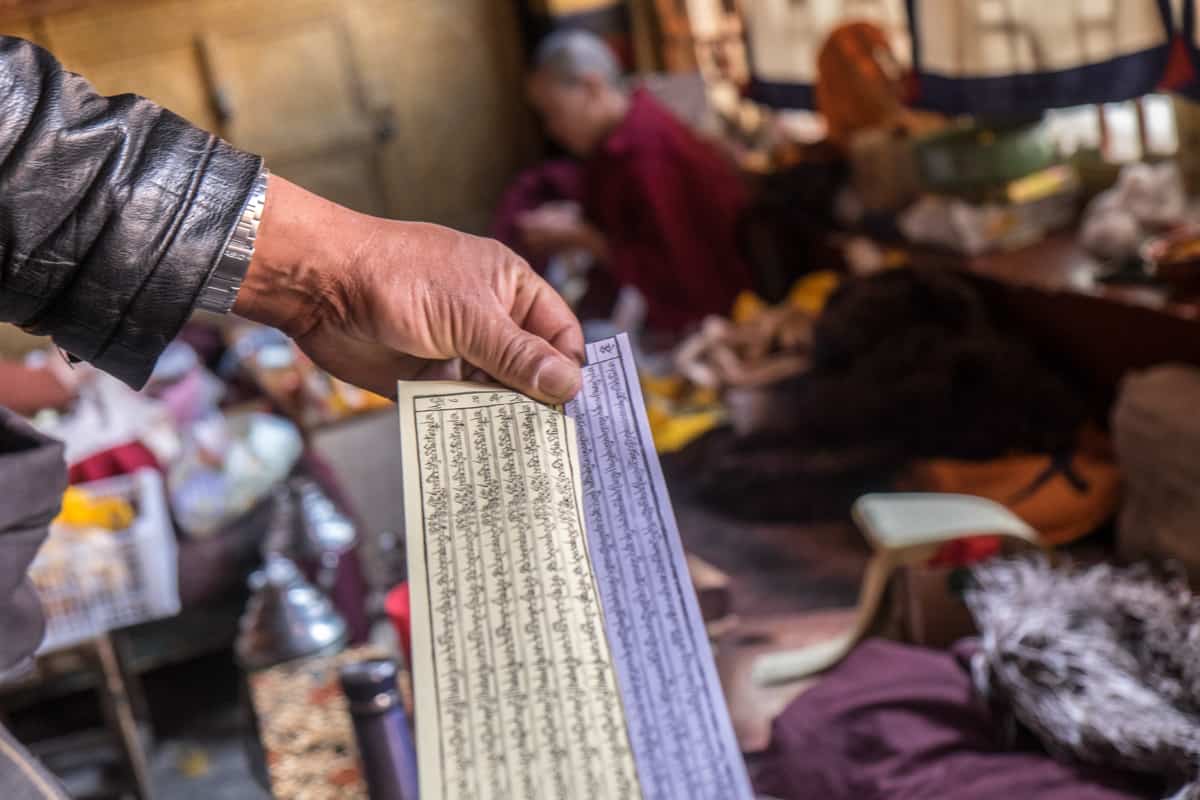
Is it Ethical to Travel Tibet?
The question of whether it is ethical to visit Tibet is a justified one, but without an easy answer and one that you should make from a personal but informed choice.

On the one hand, the Dalai Lama encourages travel there to see the country first-hand and bring those stories home. That’s what I wanted to do. Your presence is a chance for Tibetans to know of the outside world and know that people can witness their beliefs and then return home and tell people about their incredible culture.
On the other hand, your visa money doesn’t go to any form of Tibetan organisation. I struggled with that. Since Tibet is now under Chinese rule, the rights to travel in Tibet and who can enter the country is determined by China. Tibetan religious sites that have been left intact are for tourism dollars, and therefore it’s hard (although possible) to keep all your expenditure in the hands of Tibetan enterprise.
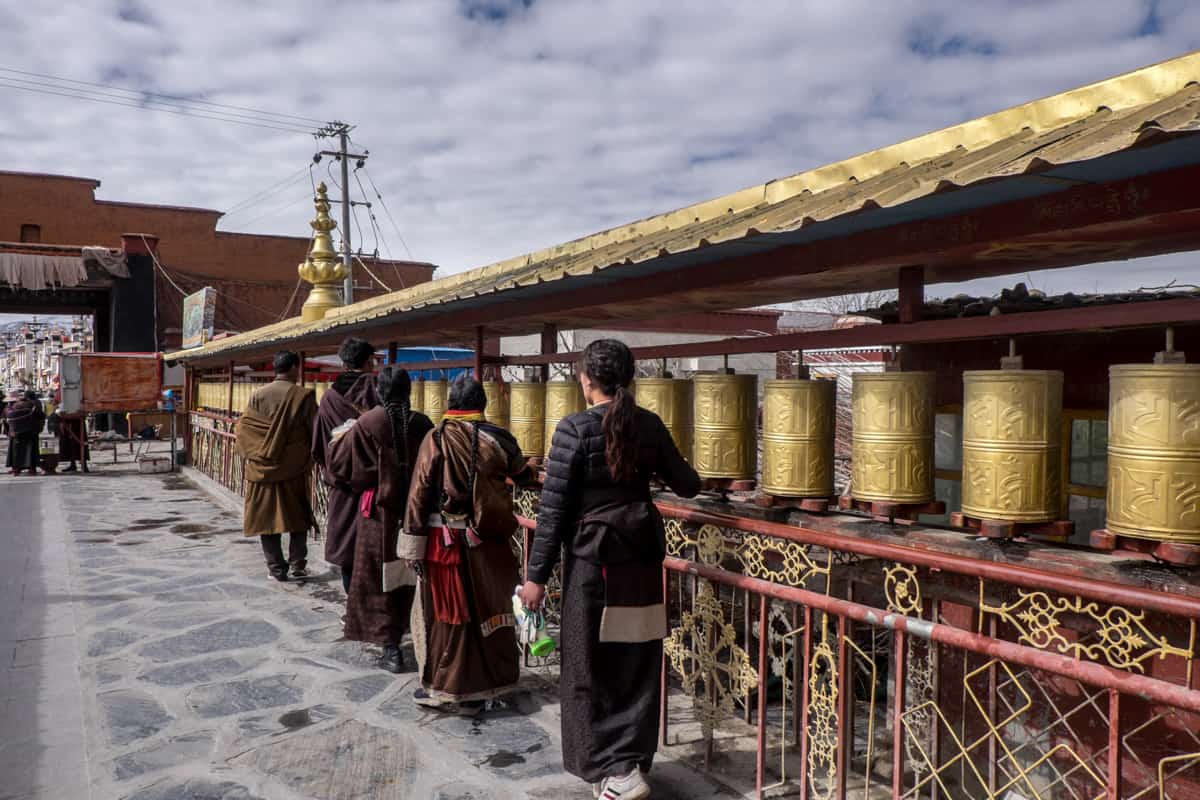
You’ve made your decision to go and experience this destination steeped in intrigue, but what is it really like to go to Tibet?
You will hear from your guides as you make your way through the region that thousands of Tibetan sites were destroyed during the Cultural Revolution after the Tibet Autonomous Region of China was formed 60 years ago. It is patchy information since the history of the country or mention of the Dalai Lama cannot be spoken of in detail or publicly, even if it is evident to you as a visitor. It would be best if you did your background research at home before visiting.
What remains are the Tibet sites considered most important and sacred, which you enjoy throughout your journey across the country.
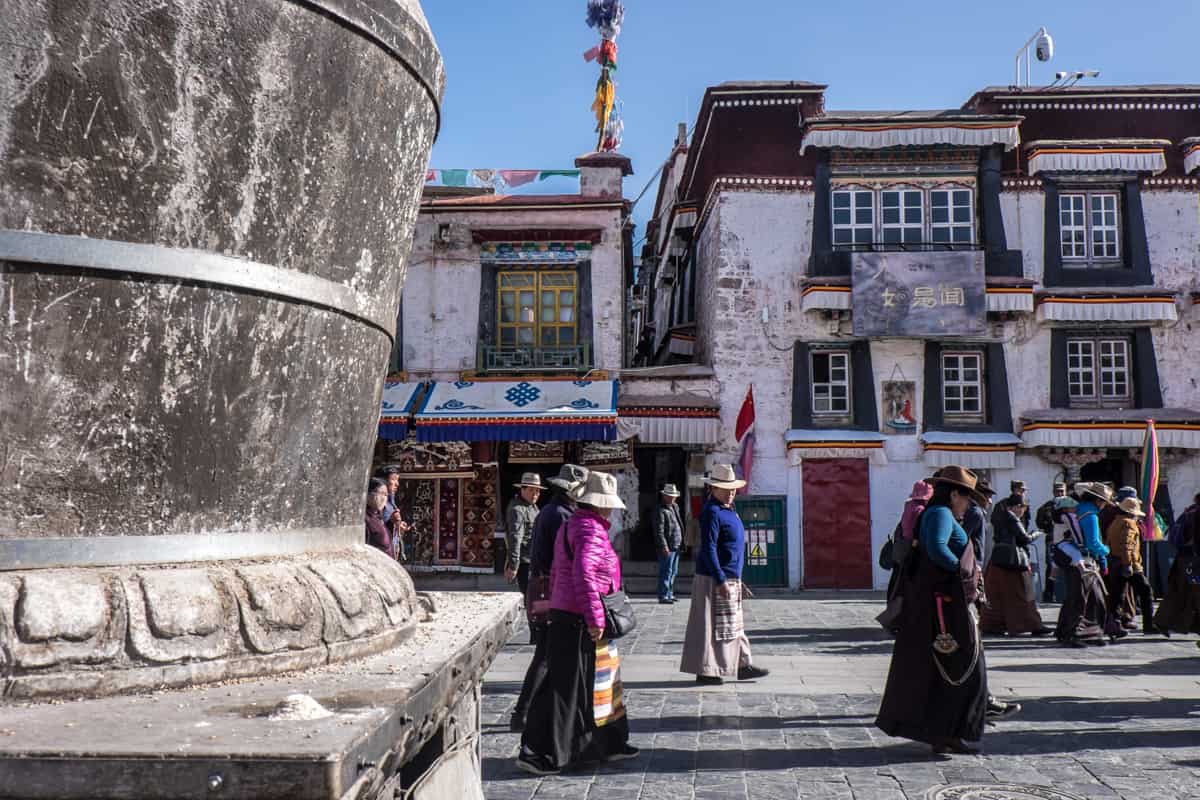
Chinese surveillance and military presence is something you too may notice, including CCTV cameras and plain-clothed guards that often appear close to tourism groups when visiting significant sites. These monitoring systems are not something to be afraid of, and you quickly get used to them as a part of travelling here.
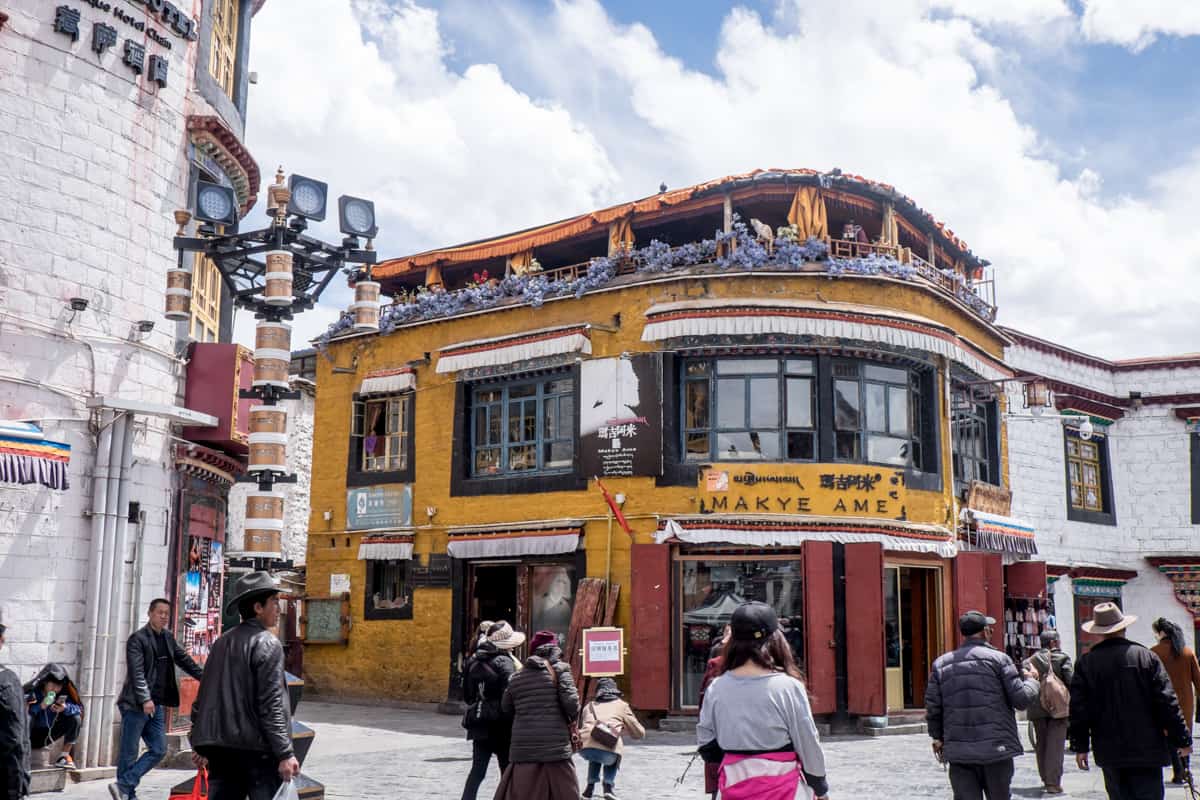
For example, when some excited Tibetan ladies wanted their photo with me, it was a form of interaction that created some level of paranoia. So I kindly shut down the situation more quickly than I would generally. It’s better for everyone and the reality of where you choose to travel and adhering to rules.
The organisation of tourism in Tibet also means that your itinerary is pre-approved and cannot be altered. This means that speed restrictions and police checkpoints along the journey (according to your trip schedule) are a requirement for your group. However, the simple reality is that often your Tibetan guide shows the relevant documents and all passports, which makes the process quicker and easier.
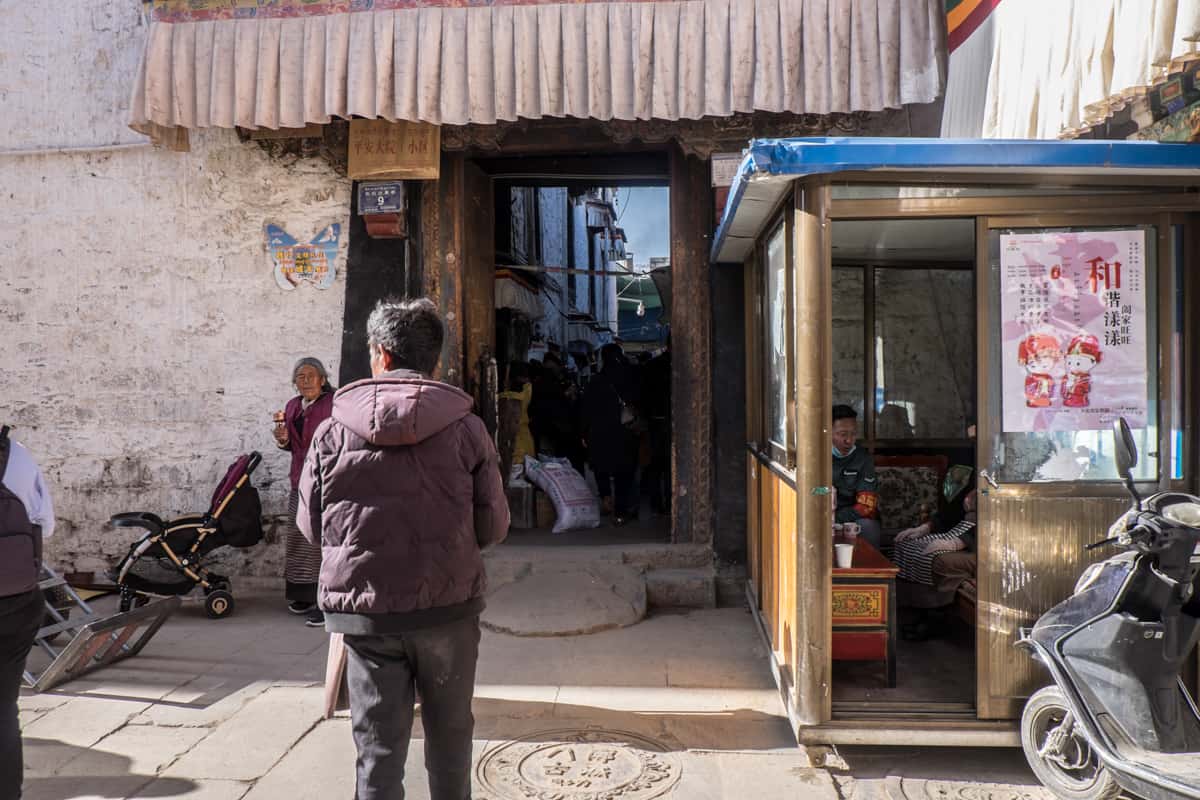
A typical checkpoint in Lhasa, Tibet
It also means adhering to specific rules and regulations at particular sites of enormous significance. The only time you will encounter inner-city police checkpoints is in Lhasa at the Jokhang temple. Given its large-scale importance, the temple has been the leading site of protest, and it’s standard procedure for the square outside of the temple to be guarded and for the army and plain-clothed officers to be present on the Barkhor sacred Kora path.
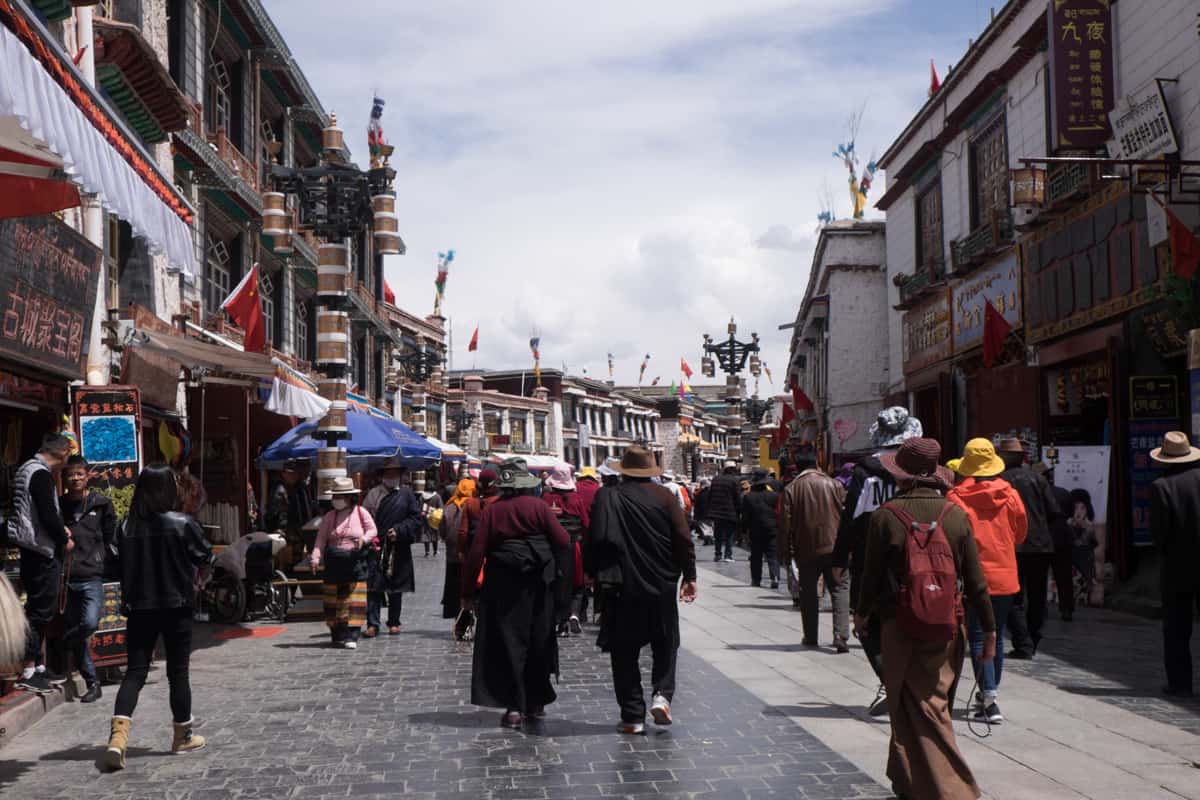
Walking the circular, sacred Kora path in Lhasa
If exploring alone in your free time, you simply show your passport and state where you are staying and your Nationality (the standard questions). We never encountered any issues going through, and we visited more than once to enjoy the incredible atmosphere of the Kora.
You can also only enter Potala Palace in your group and with your local guide, and you need to bring your passport for the restricted 50-minute viewing slot. Why such tight measures? Potala Palace is a pillar of Tibetan culture and remained the Dalai Lama’s primary residence until the 14 th (current) Dalai Lama fled to India in 1959 . The Dalai Lama is a strong point of contention, which you will realise on many levels throughout your trip.
There’s a lot to soak in, where you’ll be spiritually moved and emotionally stirred in equal measures.
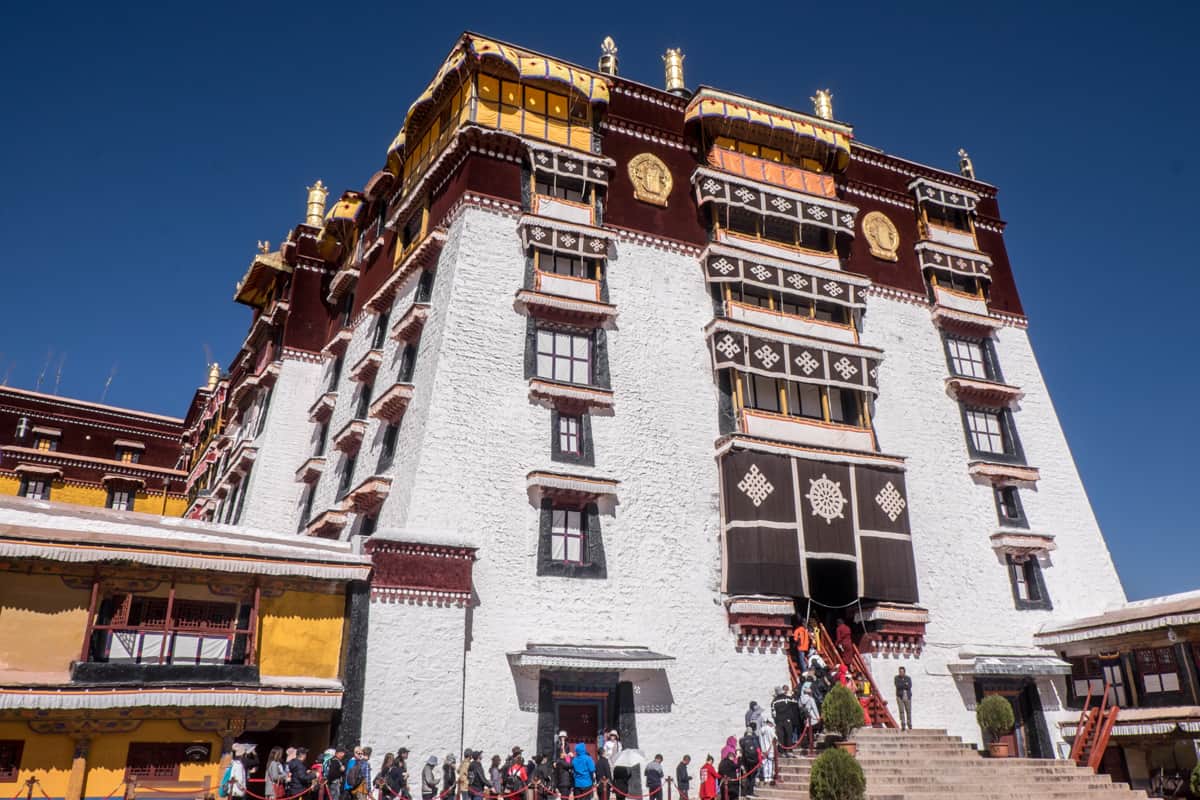
The queue at the entrance to Potata Palace, where visits are restricted to a 50-minute viewing slot
How to Visit Tibet
You cannot travel independently in Tibet and can only do so with a private guide as part of a small group . Therefore a third-party organiser must obtain a group visa for Tibet before entry.
Three days before our scheduled flight to Tibet, our group met in Kathmandu to submit details for the group visa processing.
Each of us had a four-page form to fill out, which is very much like any visa form. It asks for passport details, where else you have travelled on your particular passport in the last few months, points of contact and for a detailed breakdown of your day to day itinerary. Our G Adventures CEO (Chief Experience Officer) helped us with this process, ensuring we all had the exact itinerary and dates listed in a clear format.
Images for Tibet Visa
The images needed for the Tibet visa was tricky since nearly every person in our group had to get their passport photos redone that same evening. We were all briefed via trip notes beforehand regarding not having ears covered, needing a white background, no obvious make-up or any piercings. Even if there was a little hair covering a part of an ear, the photo had to be retaken. So much so that the women in the group were clipping every strand of their hair back.
Again, we did this as a group, ensuring we had a photographer at the passport store in Kathmandu who was briefed about our specific image request.
Application of Visa
Our Nepali CEO took our forms, photos and passports to the relevant agency and embassy for processing. It was an agonising wait to know if we could get into Tibet or not (with an itinerary in Nepal for two days to fill the time). It was a horrible feeling not having our passports.
It was a gut-wrenching wait at the airport with just over one hour until our flight from Kathmandu to Lhasa, waiting for the group visa to turn up via a China embassy worker who delivers the paper via motorcycle. Our cheers were the signal that the adventure was just beginning.
Browse dates and book a Tibet trip here.
How to Get to Tibet – Arrival and Getting Around
There are three ways to travel Tibet – via a flight to and from Lhasa or by overland via train or private vehicle.
Those who join groups in China fly mainly from Beijing or other cities on the Lhasa flight circuit. Taking a train to Tibet is doable only from China via one of the following cities – Beijing, Chengdu, Guangzhou, Shanghai, Chongqing, Lanzhou and Xining- and is subject to your particular itinerary and booking.
I chose to travel to Tibet from Nepal, soaring over the Himalayas via a flight from Kathmandu to Lhasa. This flight route also allowed for the grand adventure of being able to overland in Tibet and travel back to Kathmandu in a loop that took around ten days.
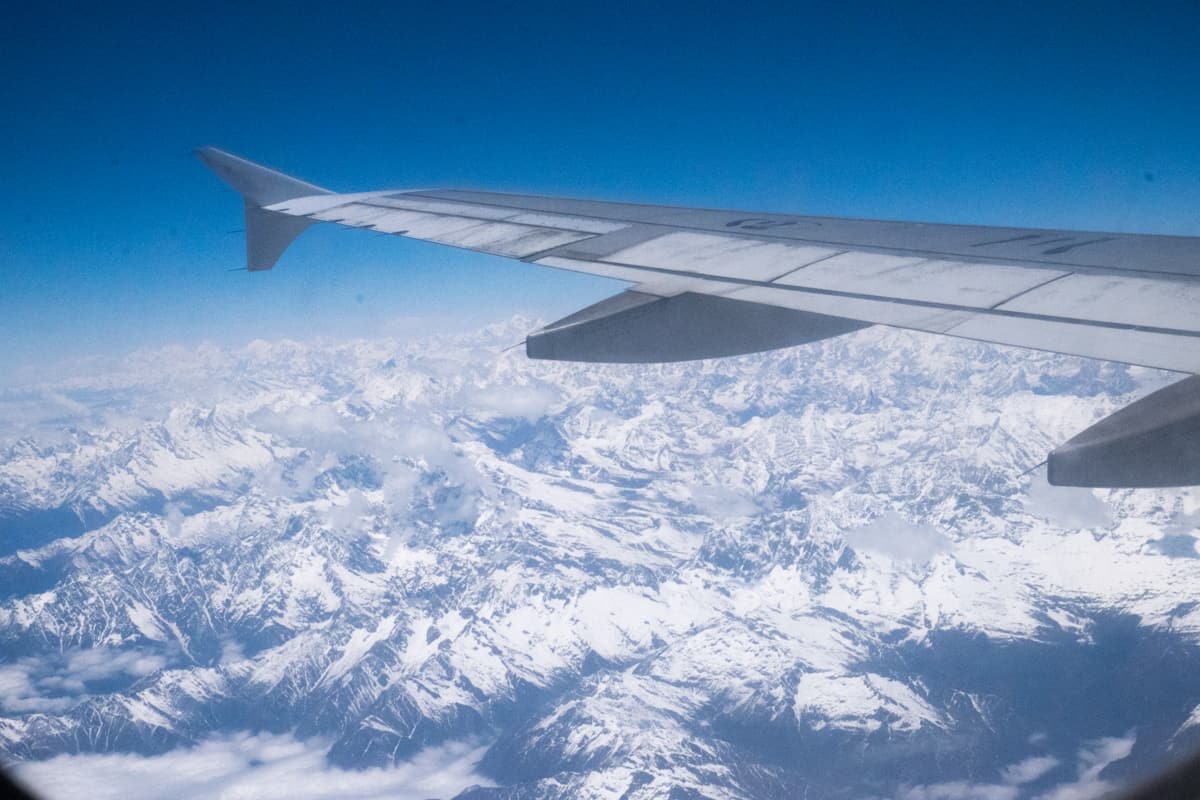
I picked this particular tour because of its Nepal start and endpoint, as I did not want to travel from China for my ethical reasons about where I spend my money. Nepal is also a country close to my heart, where I encourage people to visit and contribute to the local economy.
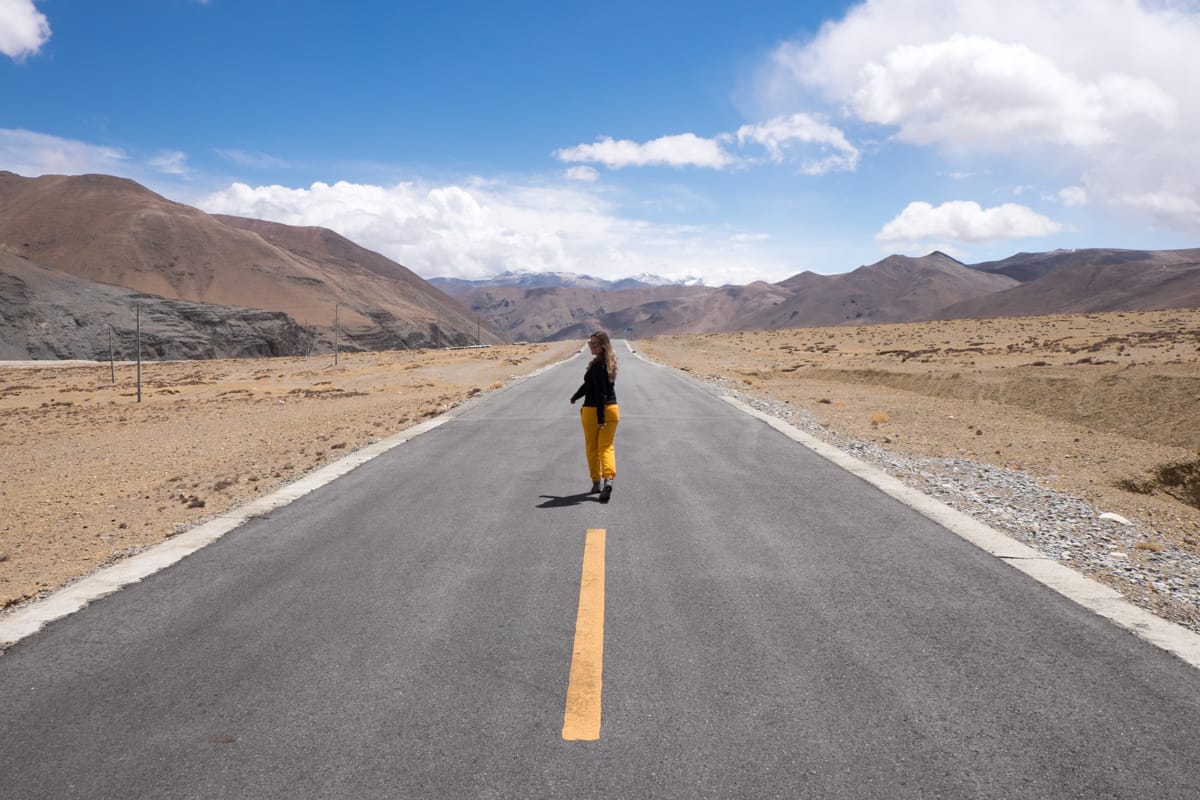
As per the group visa and organisation rules, you can only travel around Tibet with an organised guide and private vehicle and driver.
Solo travel and the use of public transport are not permitted for foreign travellers. We rode the local bus in Lhasa for a few stops, but we were with our guide.
This private guide and vehicle also apply since you must arrive at designated police checkpoints in your route by certain dates and specific times. At times you will be asked to get out and present your passport one by one in your group before continuing with the next leg of the journey.
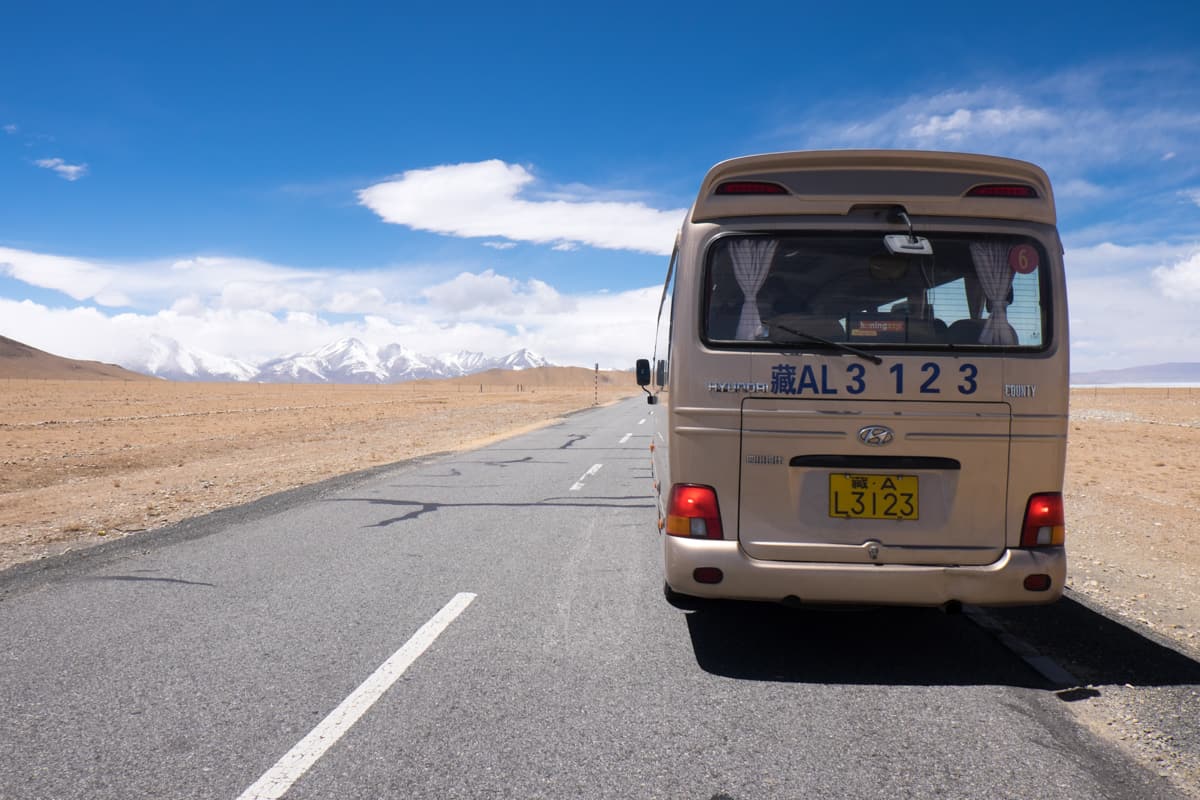
The season typically starts in mid-April and runs until October, covering the spring, summer and autumn months in Tibet. The height of summer can be stifling, which is why it’s best to try and get on one of the first tours in April or the last remaining in October .
Tibet isn’t closed for tourism because of the weather, more so for the New Year’s Losar Festival in late February or early March and is closed during political dates such as the anniversary of Chinese occupation at the end of March.
One thing that can’t be changed is Tibet’s incredible scenery. The dominant background of the Himalayan strip of peaks is one of the best things about this trip.
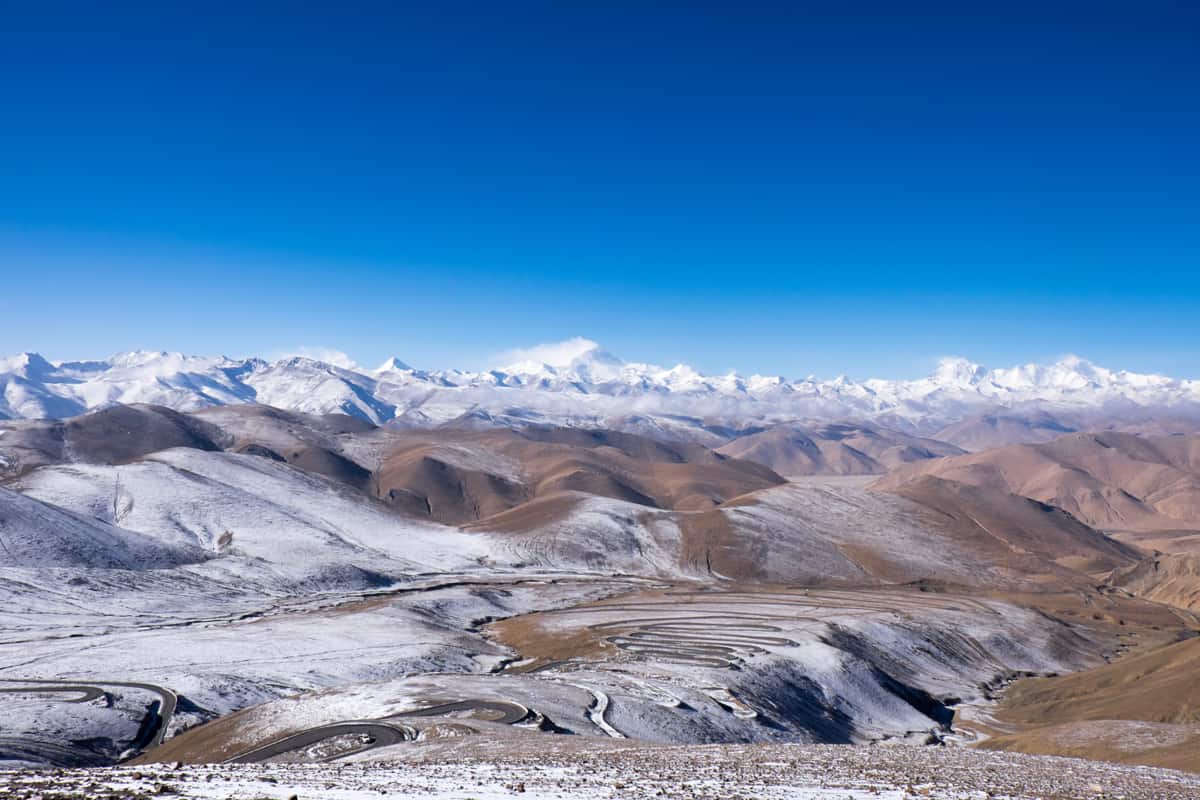
With all these elements in mind, regarding group travel and a group visa, a private guide and vehicle, alongside organised activity, visiting Tibet isn’t a budget experience.
However, with prices ranging from €2,200 – €2,800 (dependent on what time of the year you go), Tibet is a once in a lifetime opportunity.
The cost also encompasses all elements of facilitation from visa organisation, the flight and point-to-point travel.
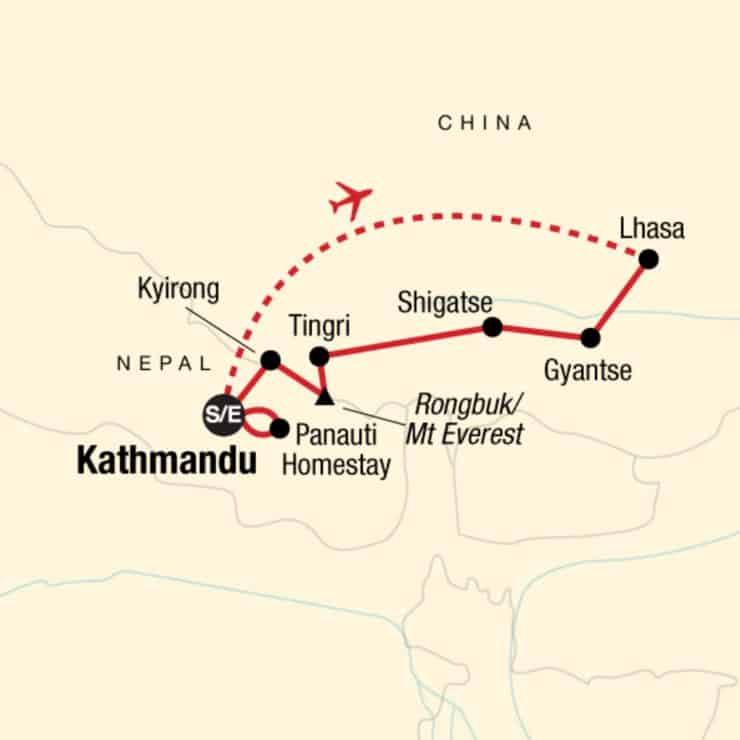
The extra costs aside from the tour cost itself were:
- Cost of the Nepal visa ($30 for 15 days, $40 for multiple entries if staying for more days before or after your trip)
- American and Brazilian: 195 USD per person
- Canadian and Romanian: 150 USD per person
- Israeli: 104 USD per person
- All other nationalities: 114 USD per person
- Food and drink costs (Approximately €400 for two weeks)
- Money for extras such as souvenirs and some entry prices for extra excursions or activities
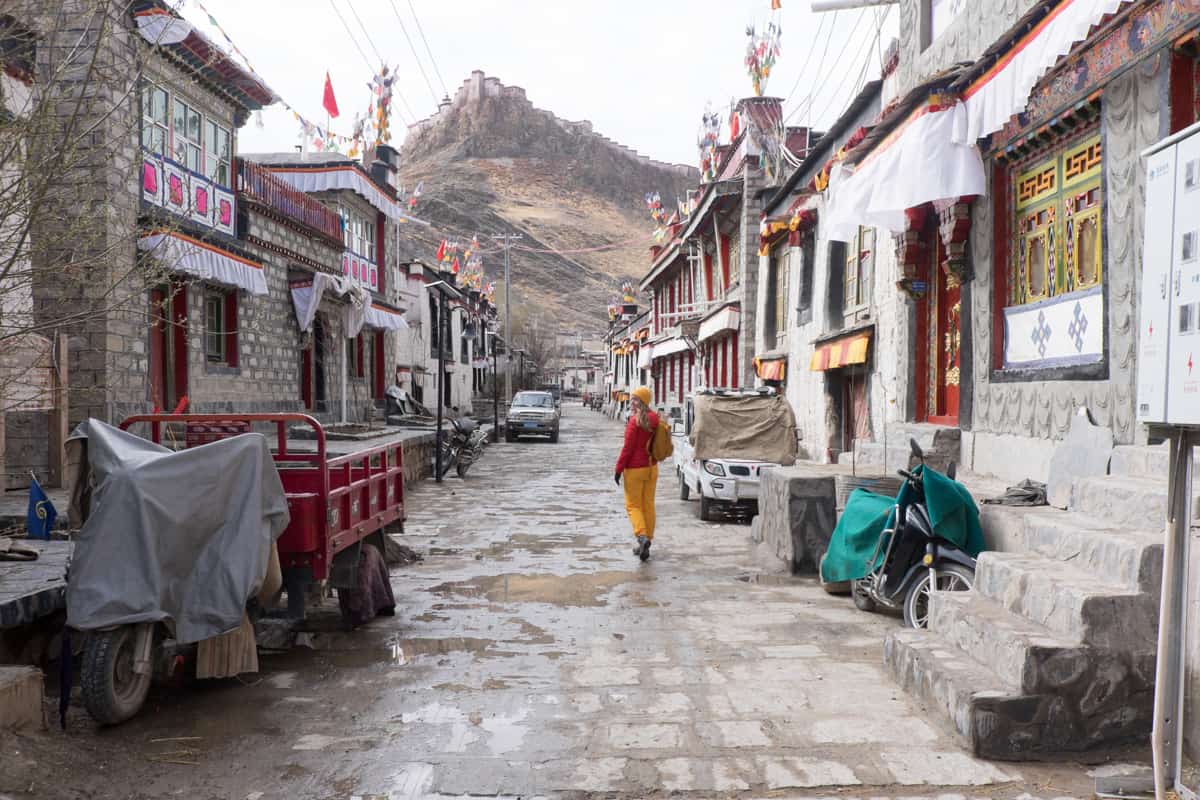
A traditional Tibetan village street in Gyantse
Safety in Tibet is a common question and a precursor to the decision to travel here. While you may hear about acts of political demonstration in the media, this is not something you are ever likely to see since the country is closed during critical political dates and anniversaries.
However, it pays to be aware of where you are and what could get you and Tibetans into trouble. This means:
Not taking or carrying any form of Tibet guidebook, related literature or any political materials into the country . The scanners at Lhasa airport scan laboriously for books.
Not carrying or having in your possession any images of the Dalai Lama while in Tibet. Possession of Dalai Lama pictures is illegal here, with severe consequences for Tibetans.
Respecting that your Tibetan guides cannot engage in any kind of political discussion, whether about the Chinese occupation of Tibet or the Dalai Lama’s current situation. They will tell you who people are in the pictures, cultural references and historical references about Tibetan Buddhism, but do not further push them.
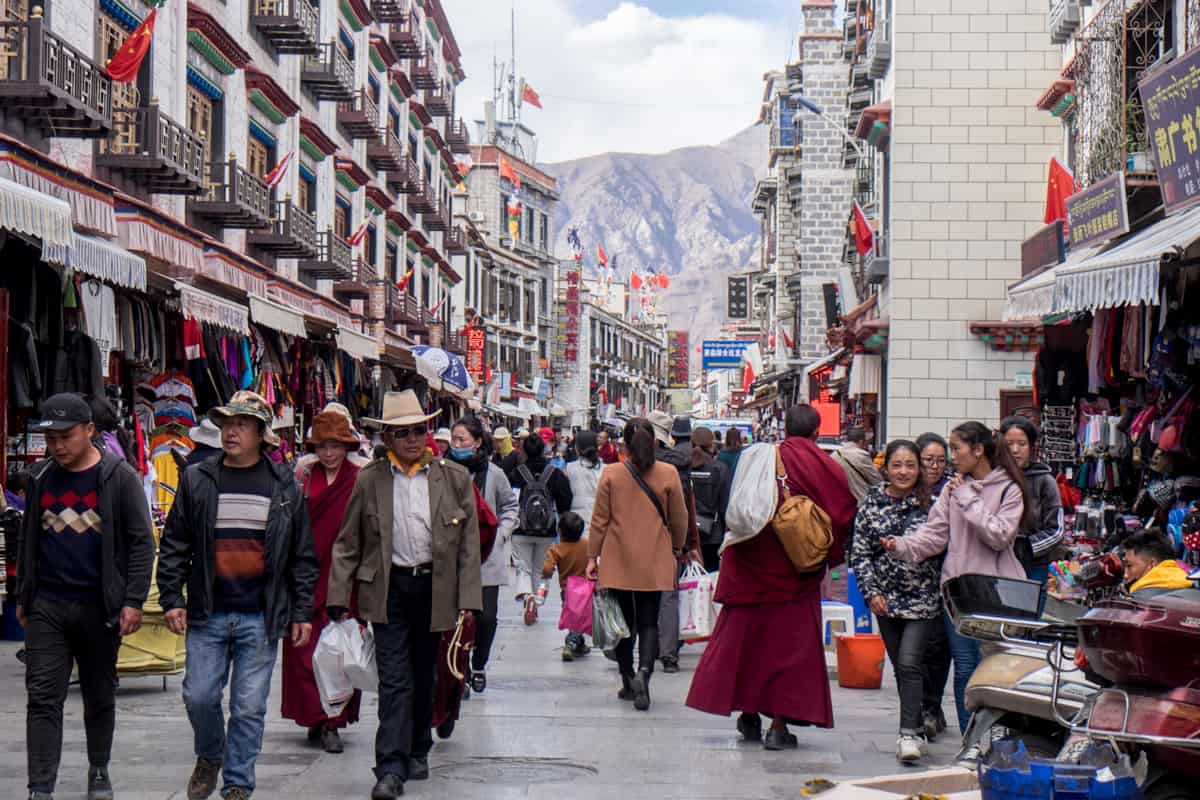
The bustling, busy streets of Lhasa
D o not engage in any kind of political discussion with any Tibetans you meet. All tourism movement is monitored, even if you think at any given moment that it is not, and such debate has far worse consequences for Tibetans.
Do not take any photos of police, army or other military personnel or set-up. If you see anything while taking pictures of sites, buildings, and street views, lower your camera, wait, or move on.
Keep to your itinerary and times. The guide has to ensure the group (and vehicle) reports at designated police checkpoints on the set days of your city departure and new city arrival and by a specified time.
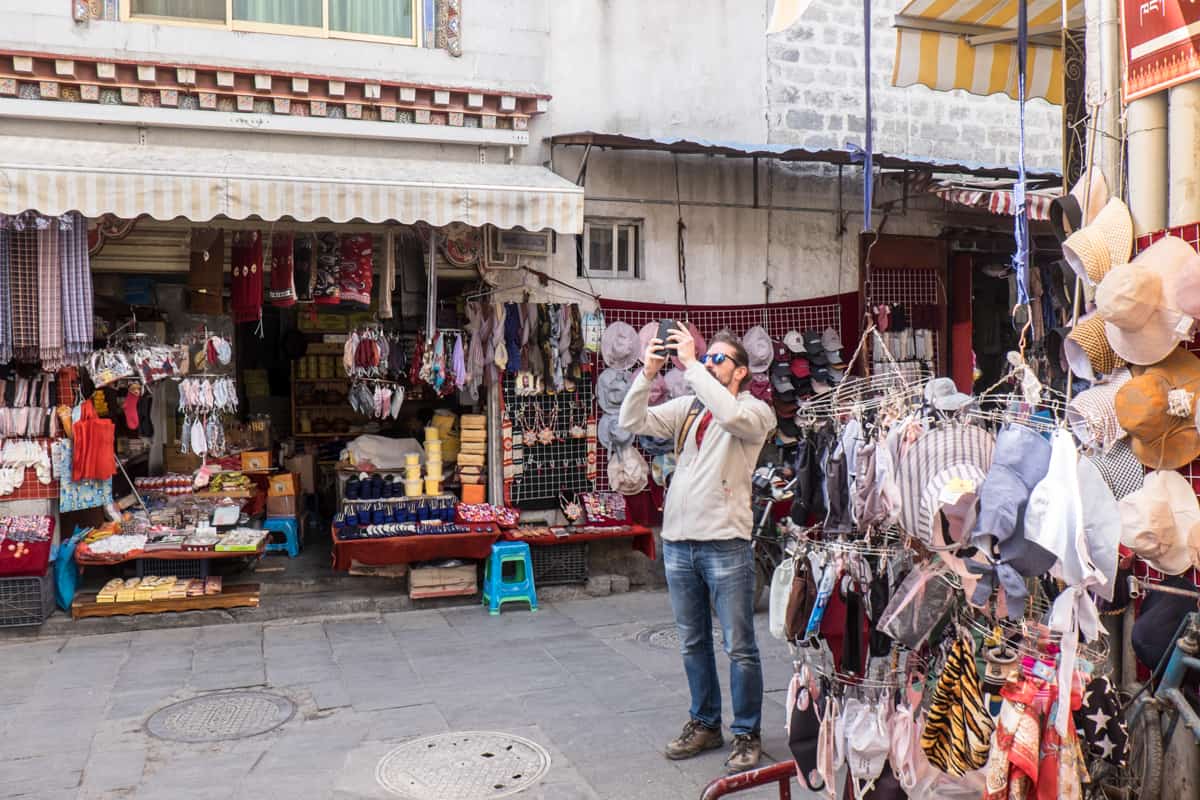
One of the main things I liked about this particular Tibet tour is that (where possible) we stayed in Tibetan owned accommodations, ate at Tibetan owned restaurants and were informed of where to shop at Tibetan owned stores and souvenir stalls.
It’s hard to distinguish what is in between the labyrinth of superficial Chinese town structures, so having someone point you in the right direction was a welcome gesture.
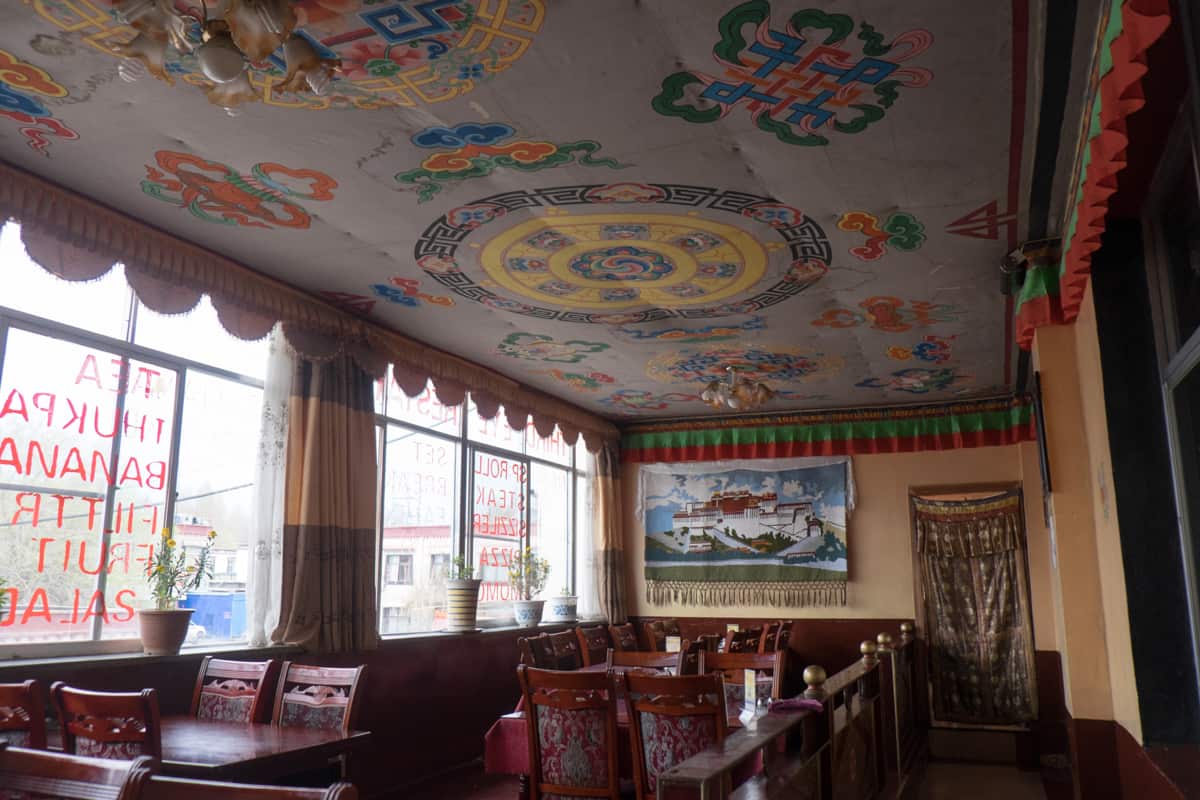
One of the few Tibetan owned restaurants.
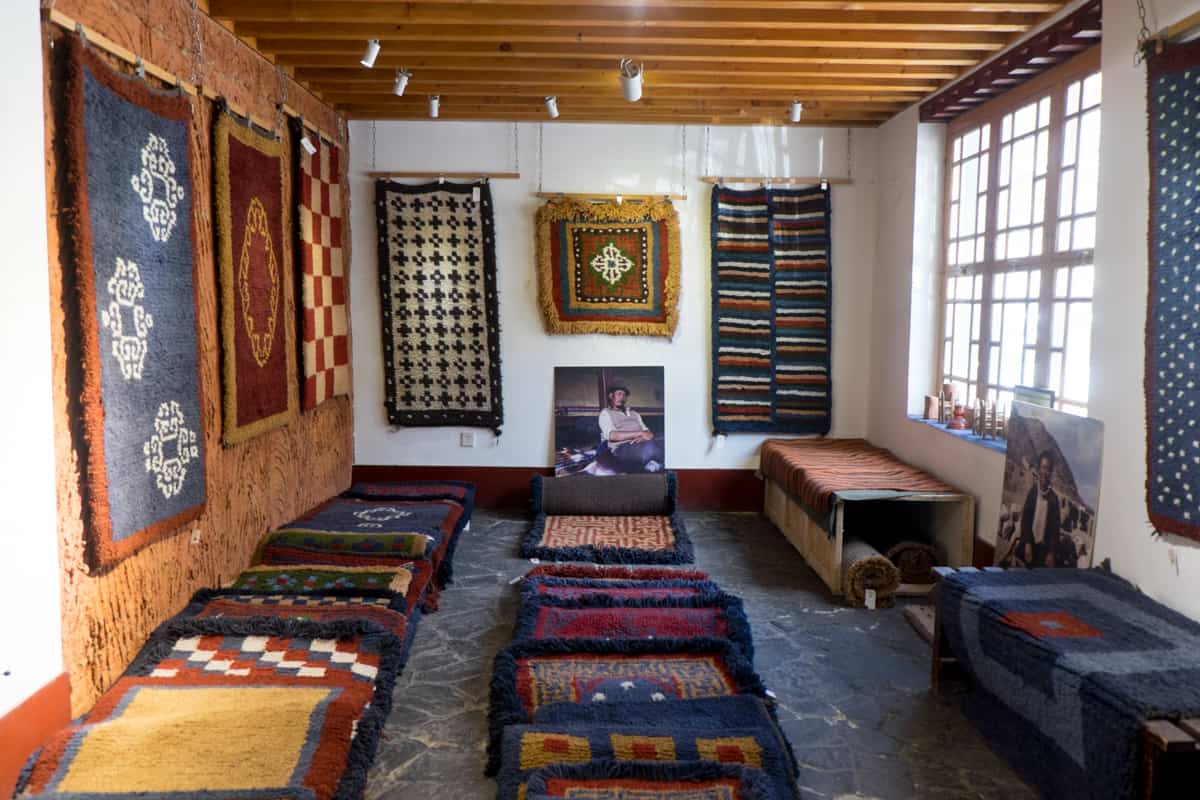
A Tibetan owned shop in Lhasa
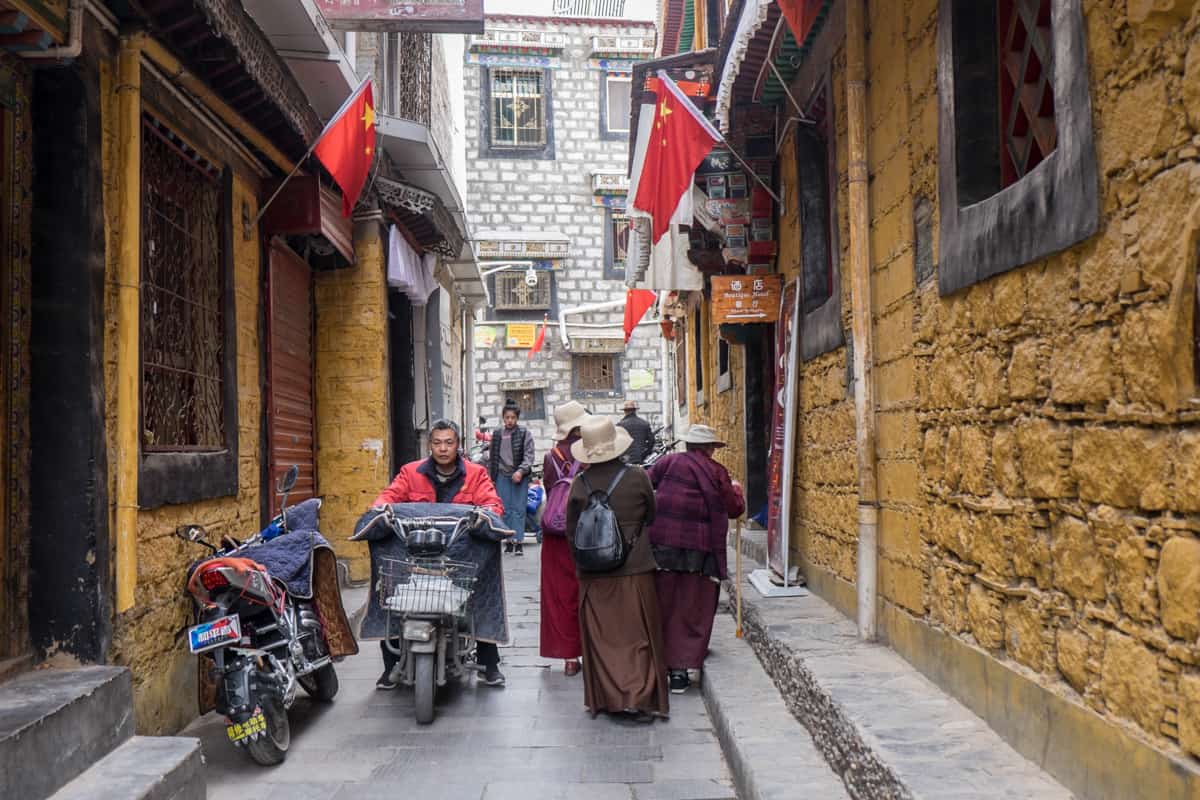
Tibet street scenes, where buildings display Chinese flags
In a destination where Chinese control affects all aspects and layers of daily life, where your tourism money goes, and what and whom it supports, is especially important.
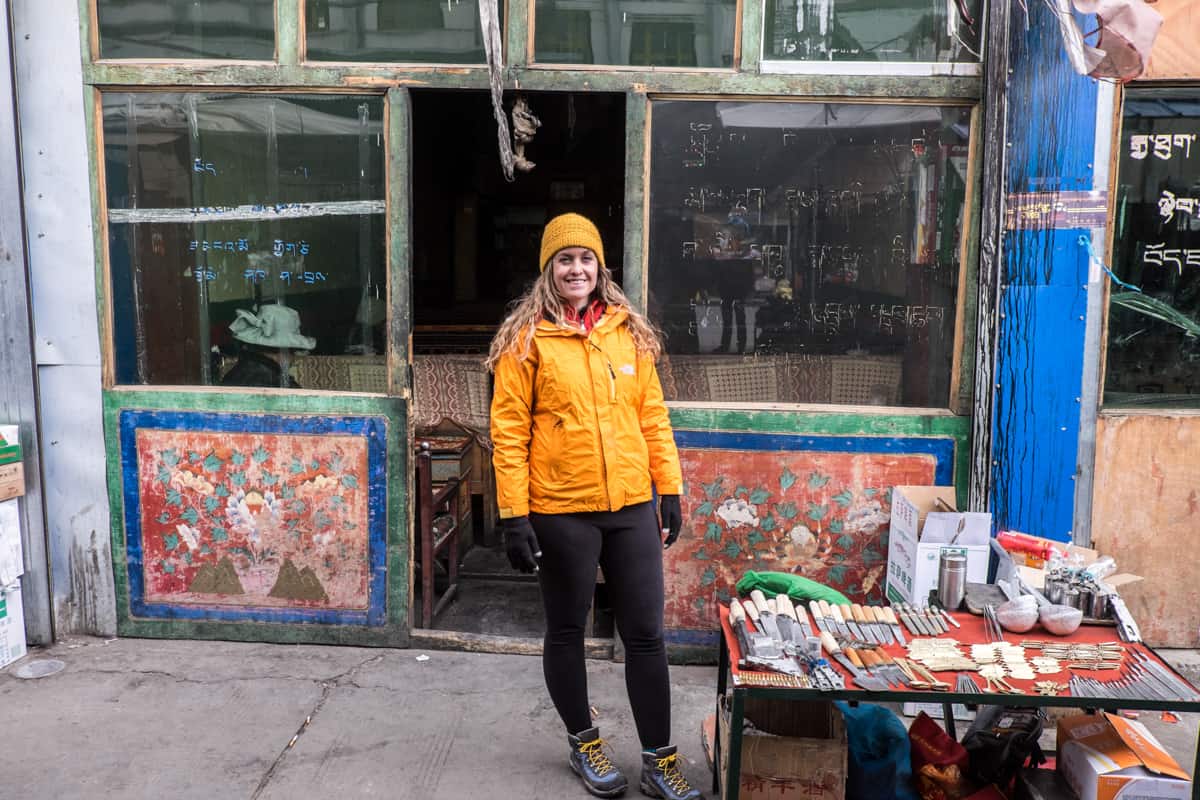
Outside a Tibetan teahouse in Gyantse
The nature of an overland trip in Tibet means many roadside stops for viewpoints and toilet stops. Therefore, forms of tourism enterprise have sprung up in key spots, and while buying food and souvenirs is fine, don’t engage in the practice of photography with the Tibetan Mastiff dogs. Chained and poorly treated, this tourism gimmick is far removed from any level of positive animal welfare and participating in it encourages its continuation.
Where to Visit in Tibet?
Due to strict control by the Chinese government, your trip is organised and scheduled, especially since the driver, guide and the group need to be at police checkpoints along the journey by a specific time. However, with approximately ten days on the ground, you get to cover a lot of Tibet and see the country’s major highlights and differences across cities and landscapes. You also have plenty of free time for extra exploration in each city.
Elevation 3658m
A focal point and centrepiece for Tibetan Buddhists and pilgrims who come here from through Tibet and further afield, Lhasa is more than just the new capital of the Tibetan Autonomous Region.
Johkang Temple (the oldest part was built in the 600s and enlarged over the centuries) and the circular Barkhor Street surrounding it is the most sacred area and the beating heart of Tibetan Buddhism of Tibet. Barkhor is one of the primary pilgrim circuits, where Tibetans come to walk in prayer clockwise around the Kora (sacred) path. It is believed that every Tibetan should visit and pray and at Johkang at least once in their lifetime.
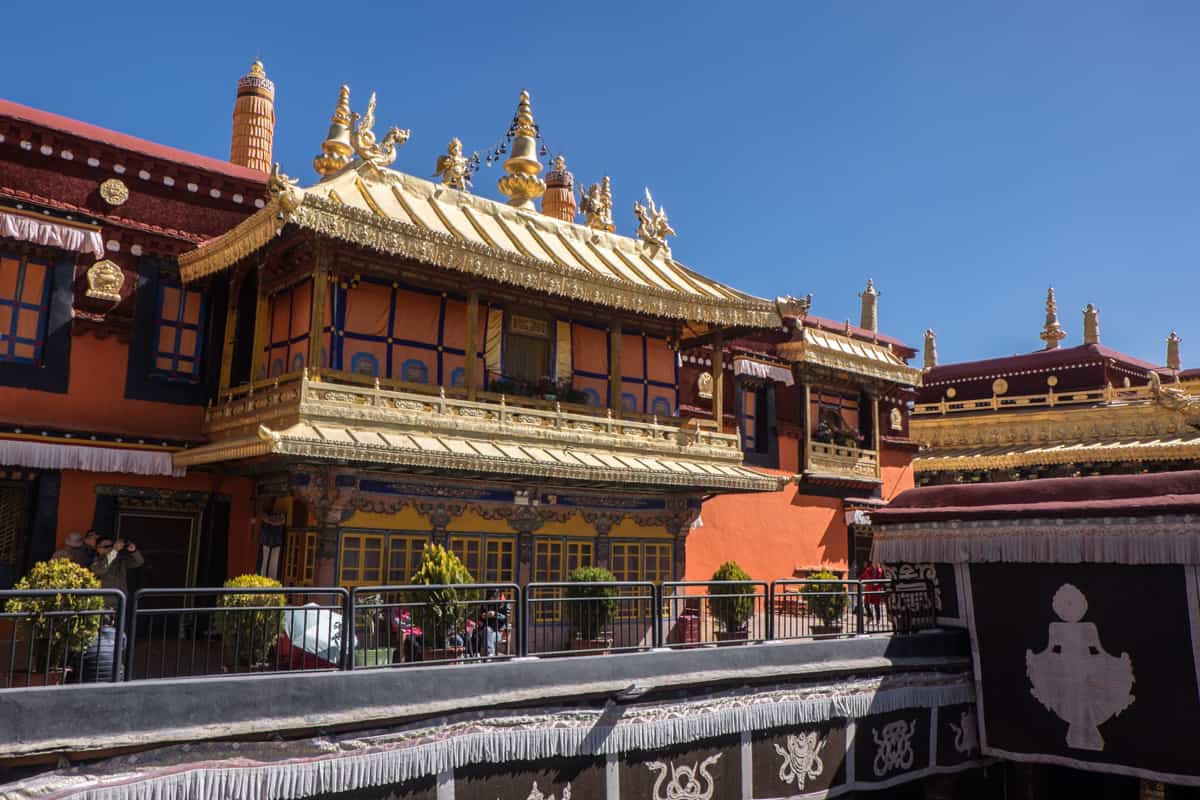
Inside the Jokhang Temple in Lhasa
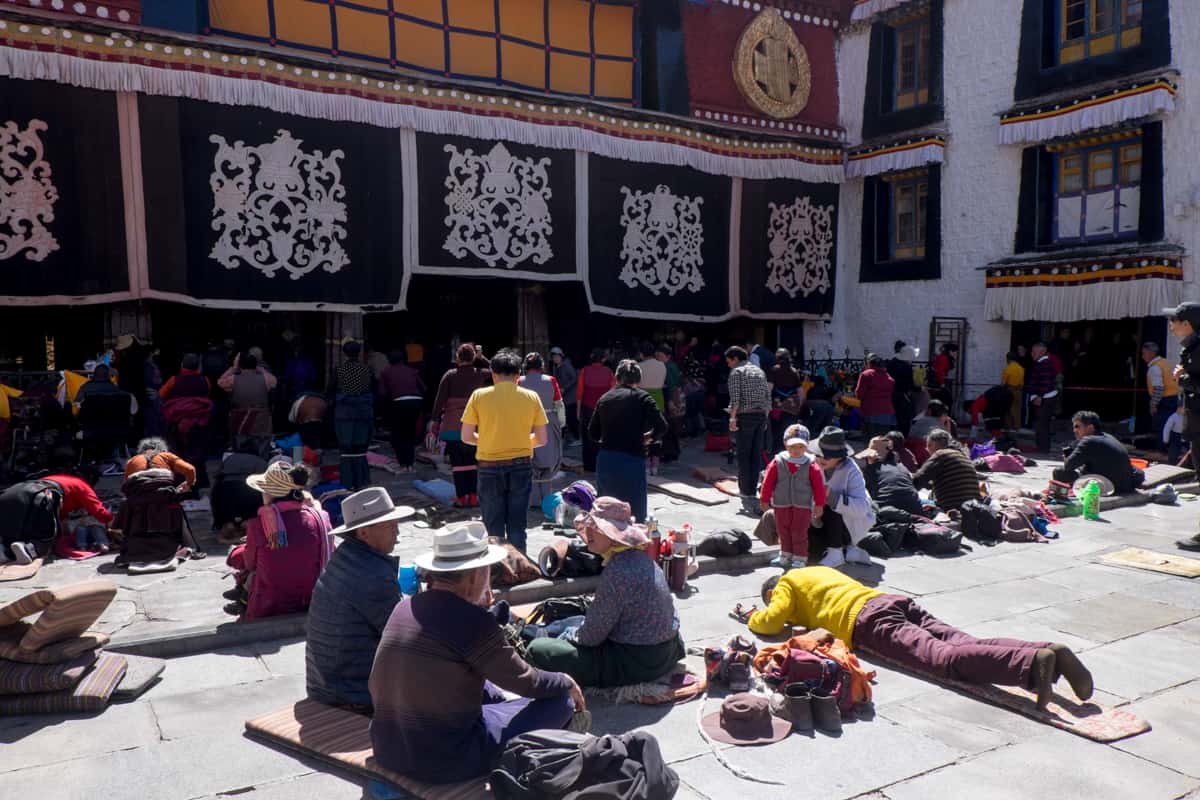
Praying Tibetans on the floor outside the main entrance of the Jokhang Temple
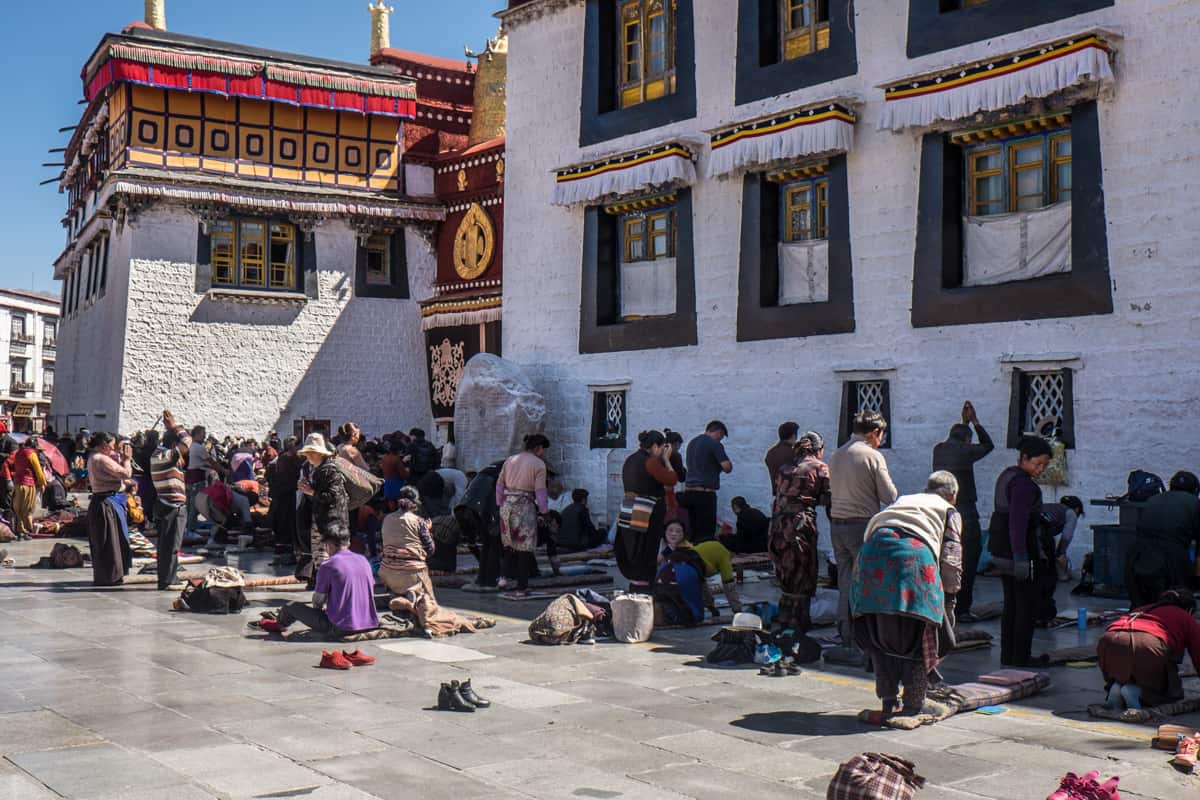
The Sera Monastery is one of the last remaining three core monasteries in the country (together with Drepung Monastery and Ganden Monastery) and one of the two great monasteries of the Gelugpa order. It is better known as the place to see the monks debating – a mesmerising hum of fast-paced chatter and hand-clapping echoes that every visitor should experience. While the number of monks has been reduced significantly (by the hundreds), you can still encounter a grand sense of spiritualism here.
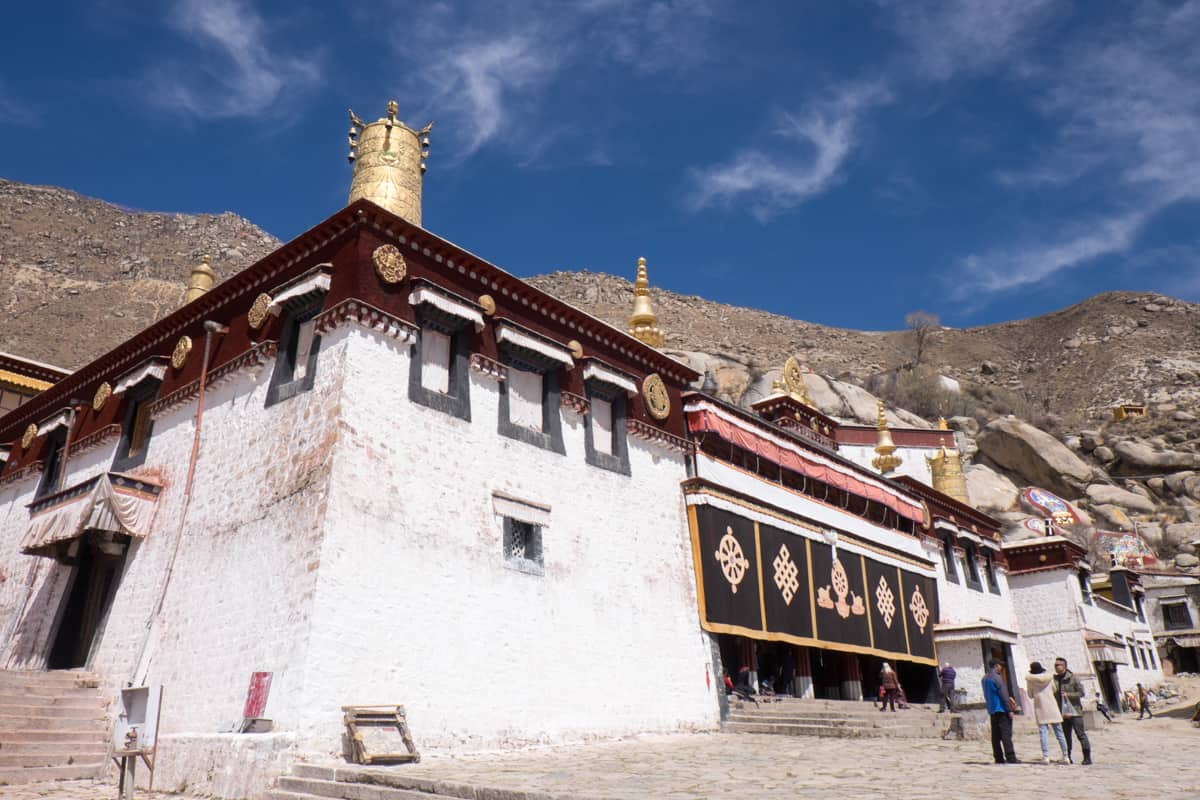
Sera Monastery in Lhasa
Potala Palace is Tibet’s icon – the looming, 1000 roomed structure that sits on the hillside presiding over the capital is now a UNESCO World Heritage Site and museum. It’s a symbol of power, the old administrative centre and the seat of government of spiritual Tibet, built during the reign of the 5 th Dalai Lama in 1645.
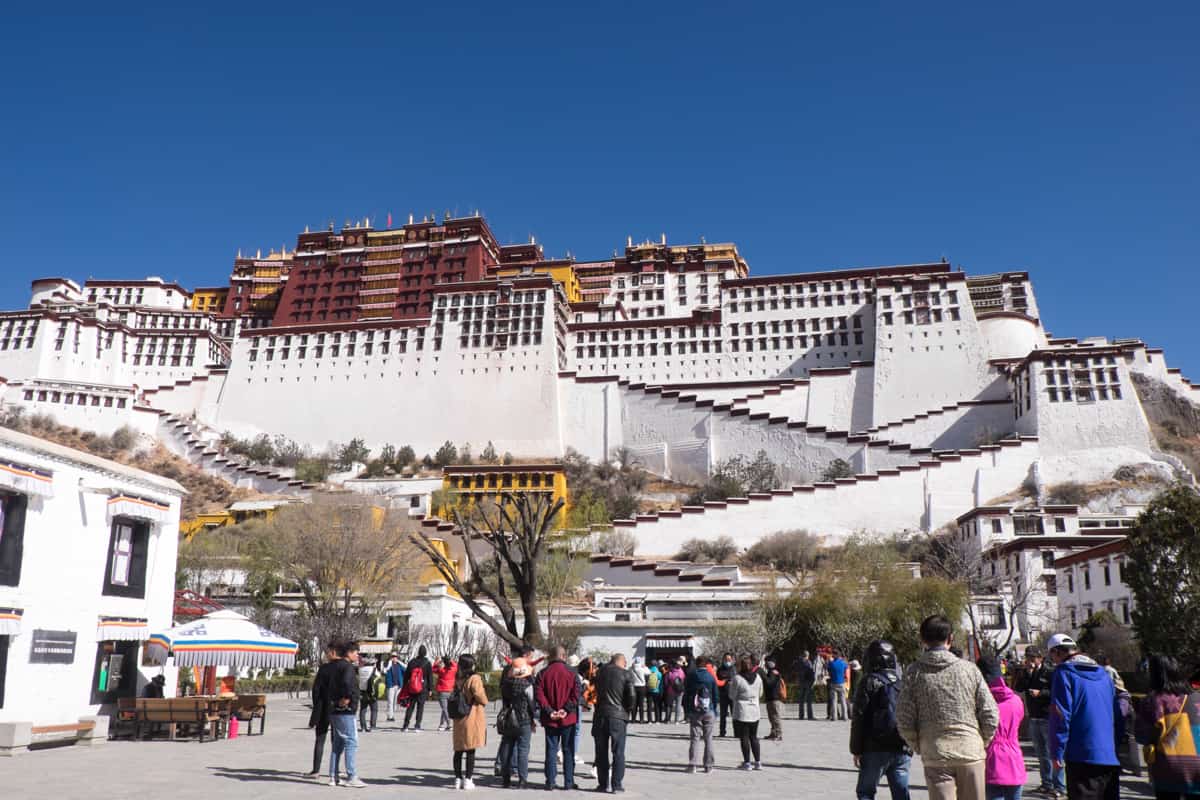
The 1000-roomed Potala Palace in Lhasa, Tibet
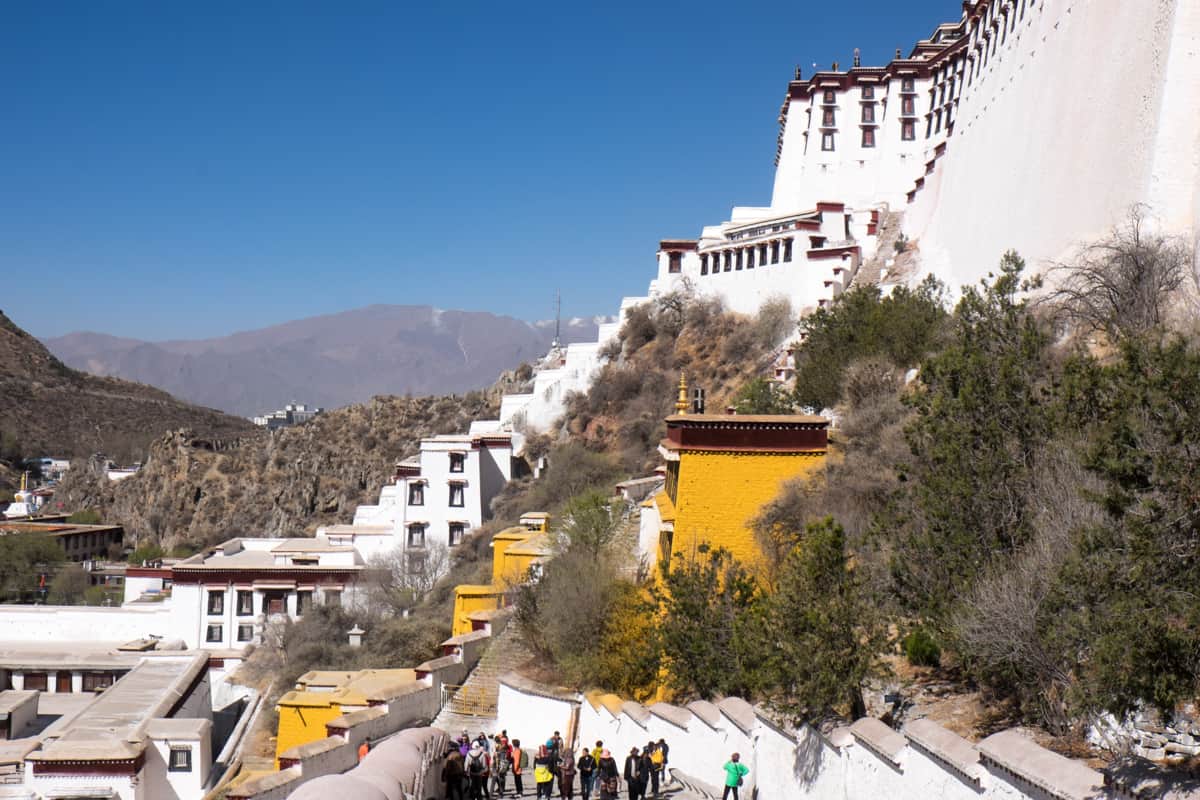
Norbulingka (Summer Palace of the Dalai Lama) was founded by the 7 th Dalai Lama in 1755 and is where the 14 th Dalai Lama made his escape in 1959. It’s known for having the most extensive human-made garden in Tibet, and so its grounds are great for visiting also.
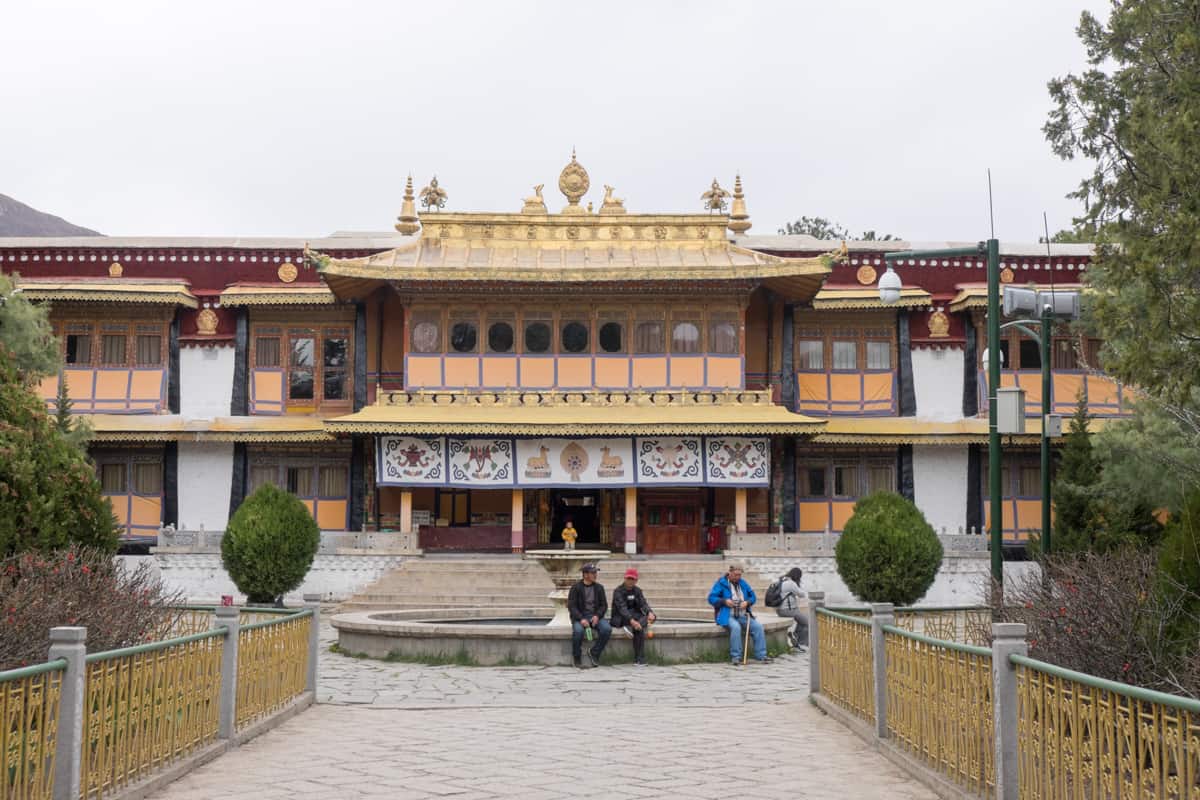
Norbulingka Summer Palace in Lhasa
We were also encouraged to visit Ani Tsamlchung Nunnery to support the nuns. Although the monks get paid a form of salary now, the Chinese government does not support the nuns. Therefore, the $6 ticket cost helps to maintain the nunnery, as does the funds made from supporting their handicraft store and teahouse, the latter of which is a truly local experience.
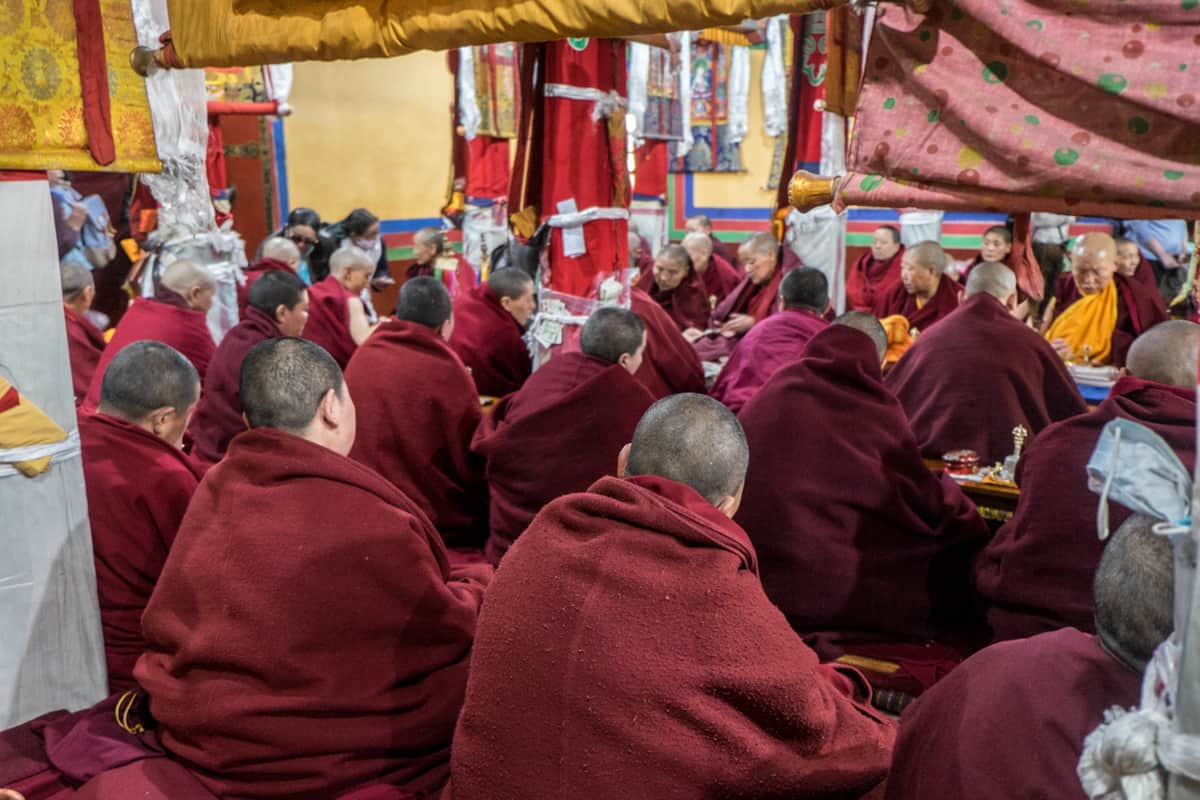
Tibetan Nuns in morning chant at Ani Tsankhung Nunnery in Lhasa
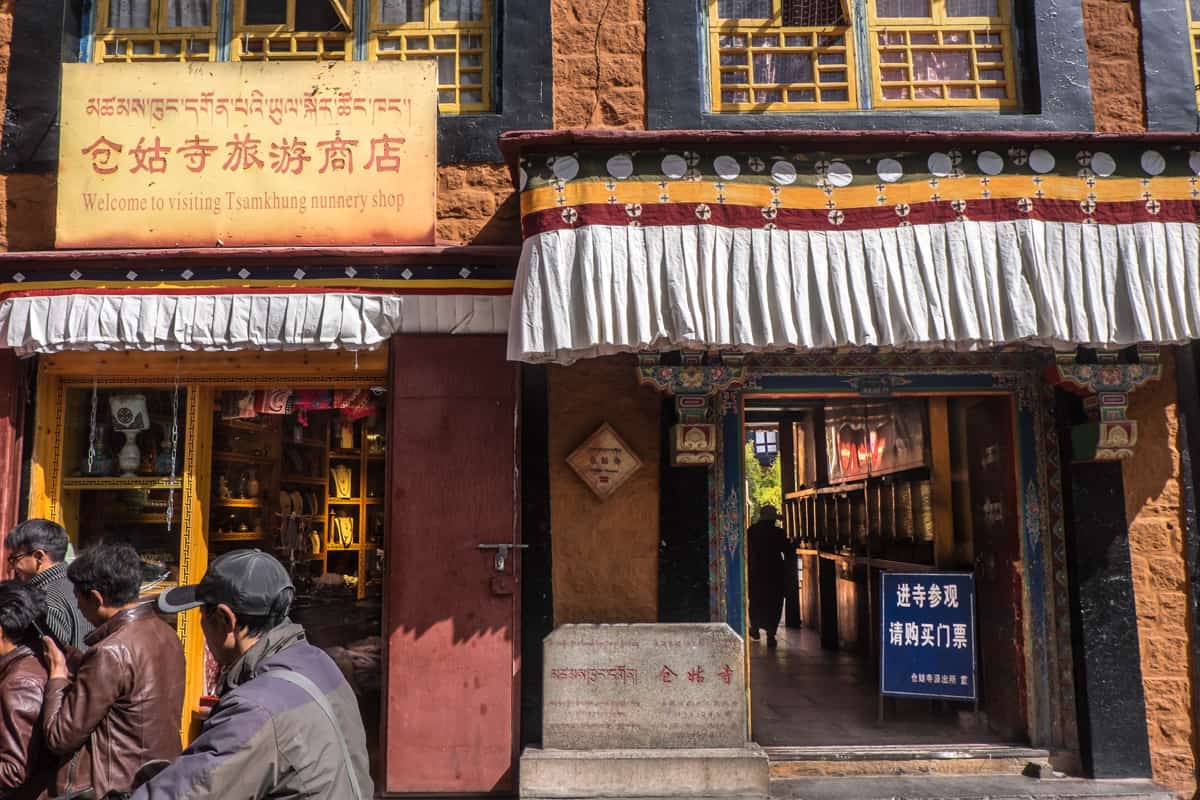
Elevation 4000m
Gyantse used to be Tibet’s third-largest town. While its administrative status has diminished, it remains one of the last cities not wholly overtaken by Chinese influence and mass structure.
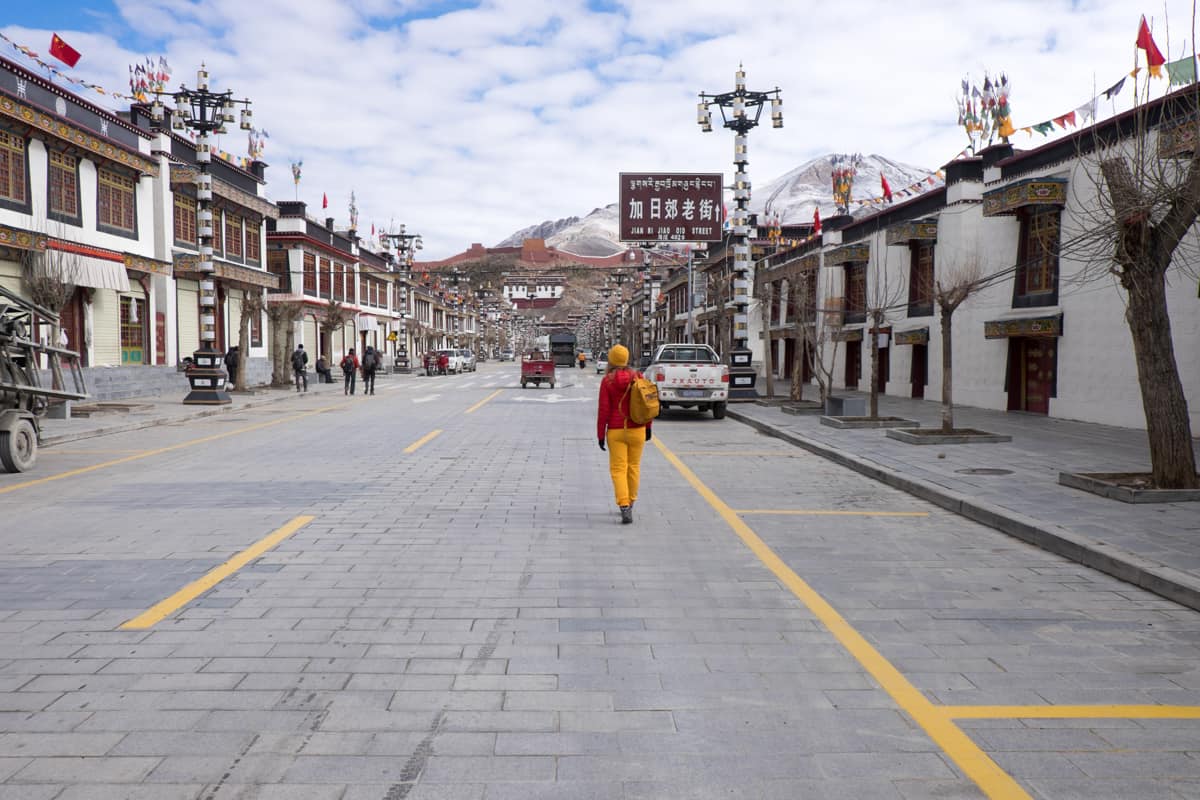
Gyantse, Tibet
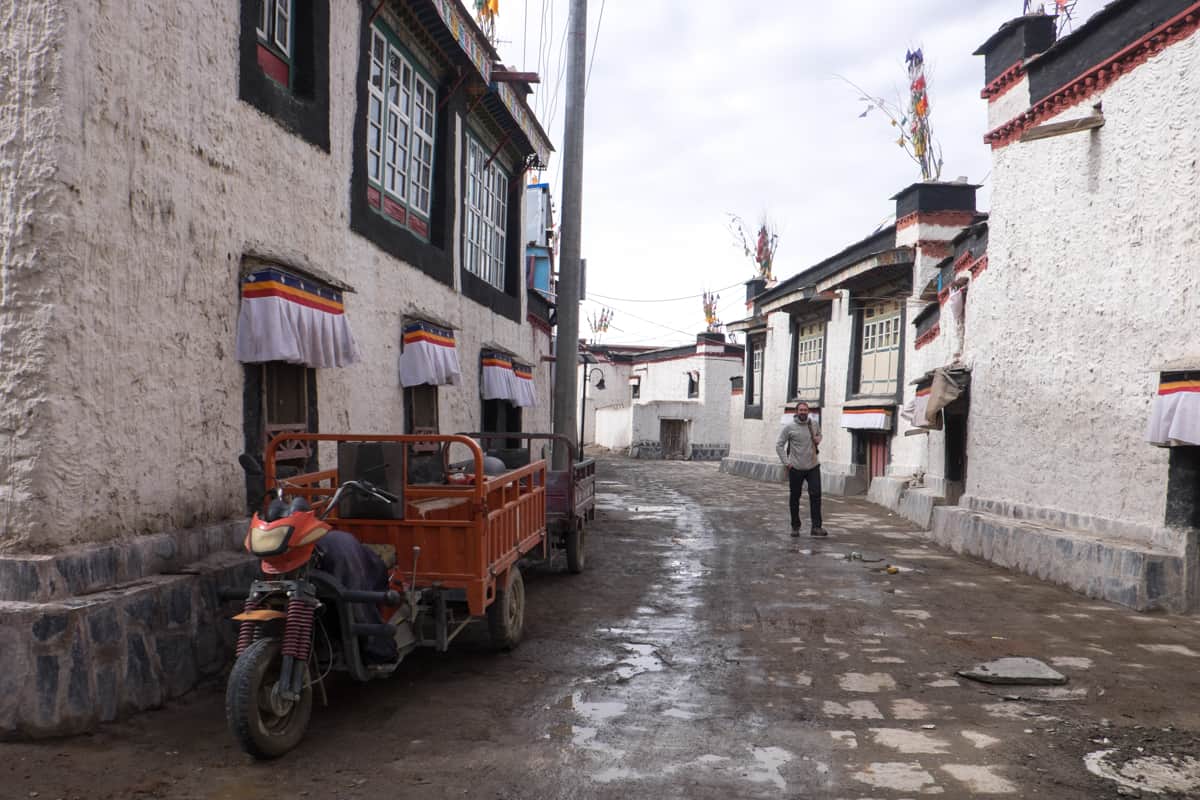
Gyantse village streets
It takes 9 hours to get here from Lhasa, with spectacular viewpoints to make a stop, including the Kambalaat High Pass at 4794m where you can view Mt. Nojin Kangatan (7191m) and drive part of the parameter of Lake Yamdork.
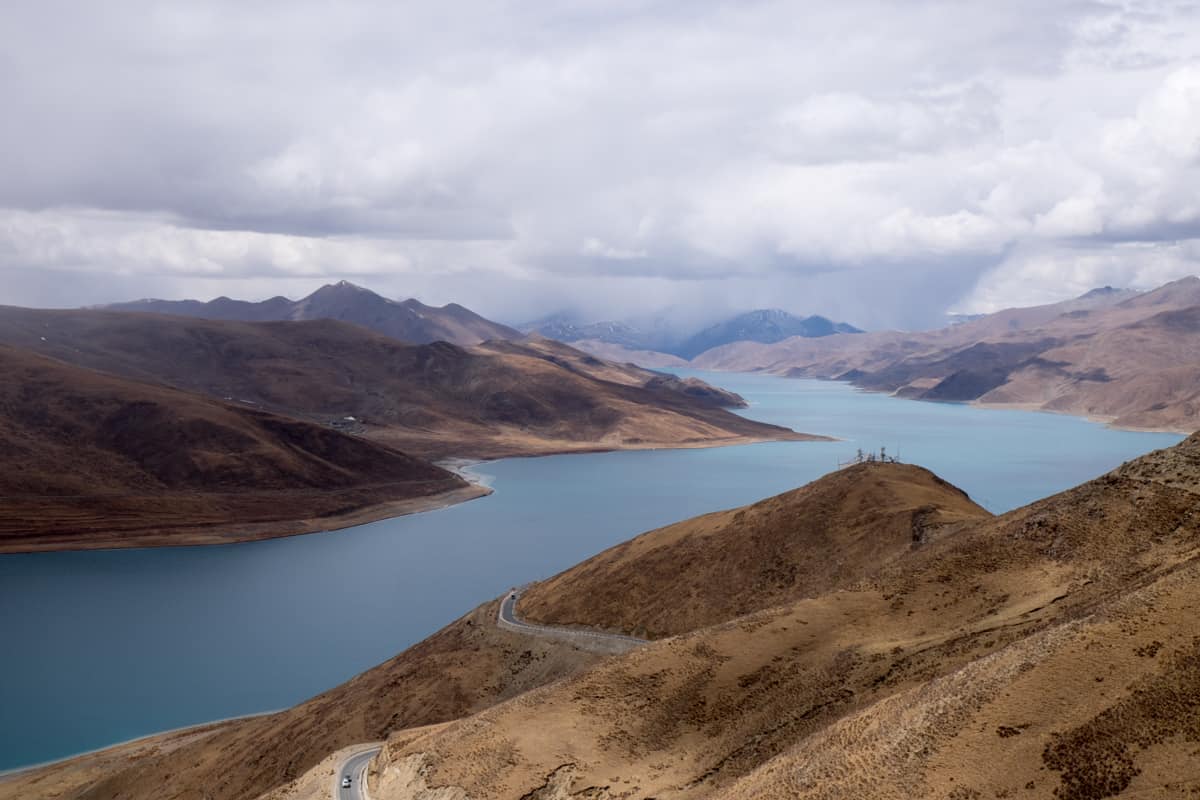
Views over Lake Yamdork, Tibet
Here we visited the Palcho Monastery , which you breathlessly climb for 20 minutes for a broad panoramic view of the surrounding village, fortress and mountain ranges. This moment of calm looking out over such a surreal canvas is a time to reflect on where you are.
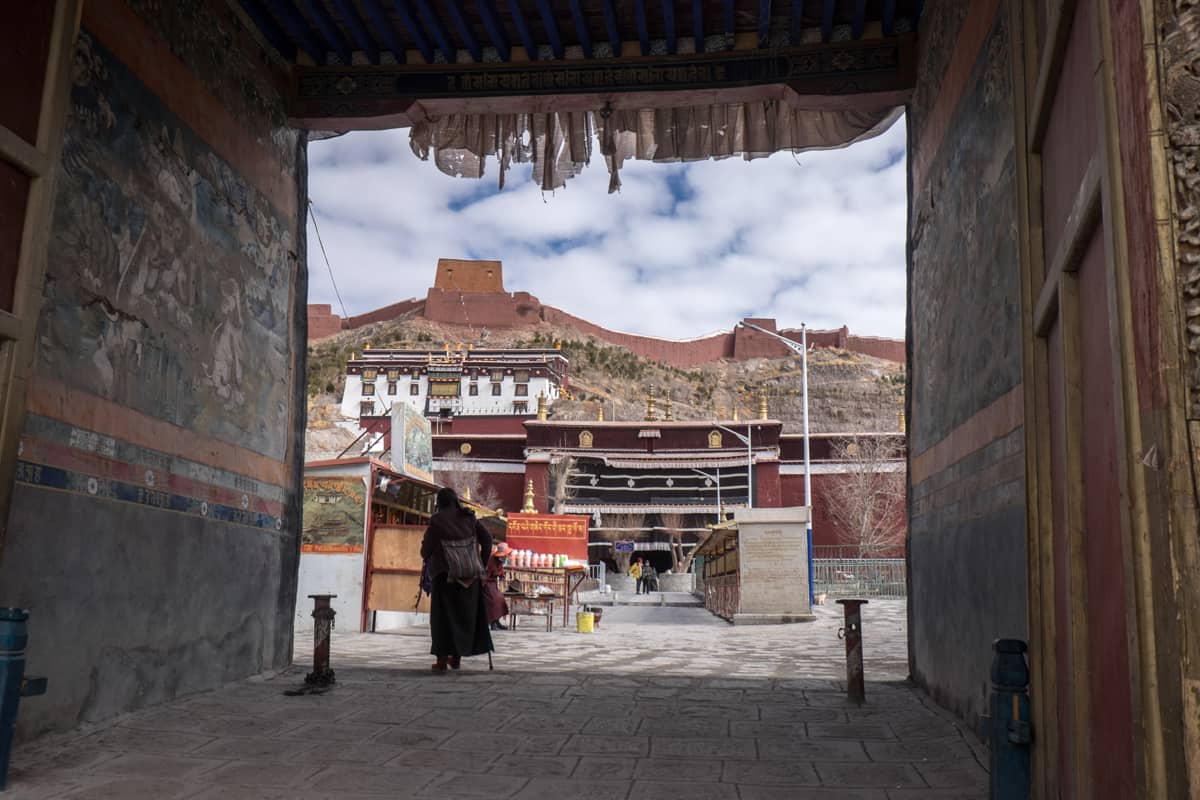
Entrance to the Palcho Monastery in Gyantse
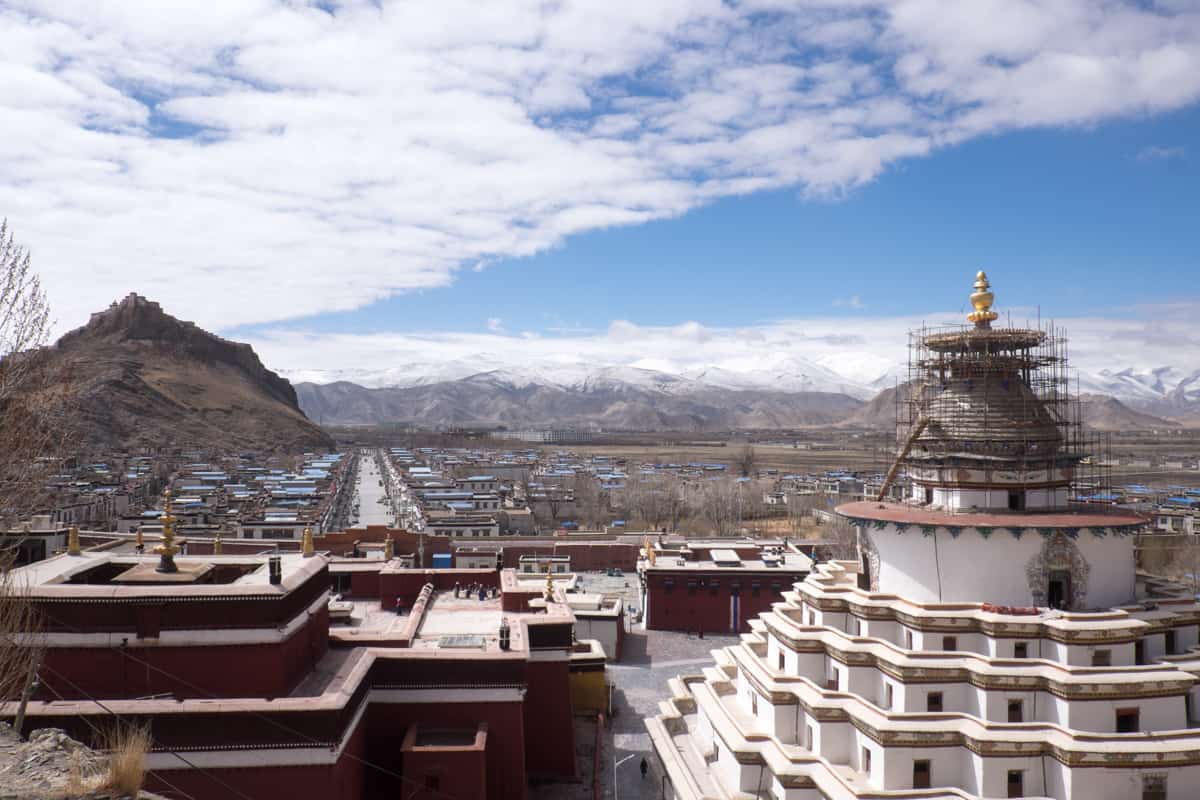
The sweeping views from the top of the Palcho Monastery
Elevation 4,300m
Tibet’s second-largest city of Shigatse is a two-hour drive from Gyantse.
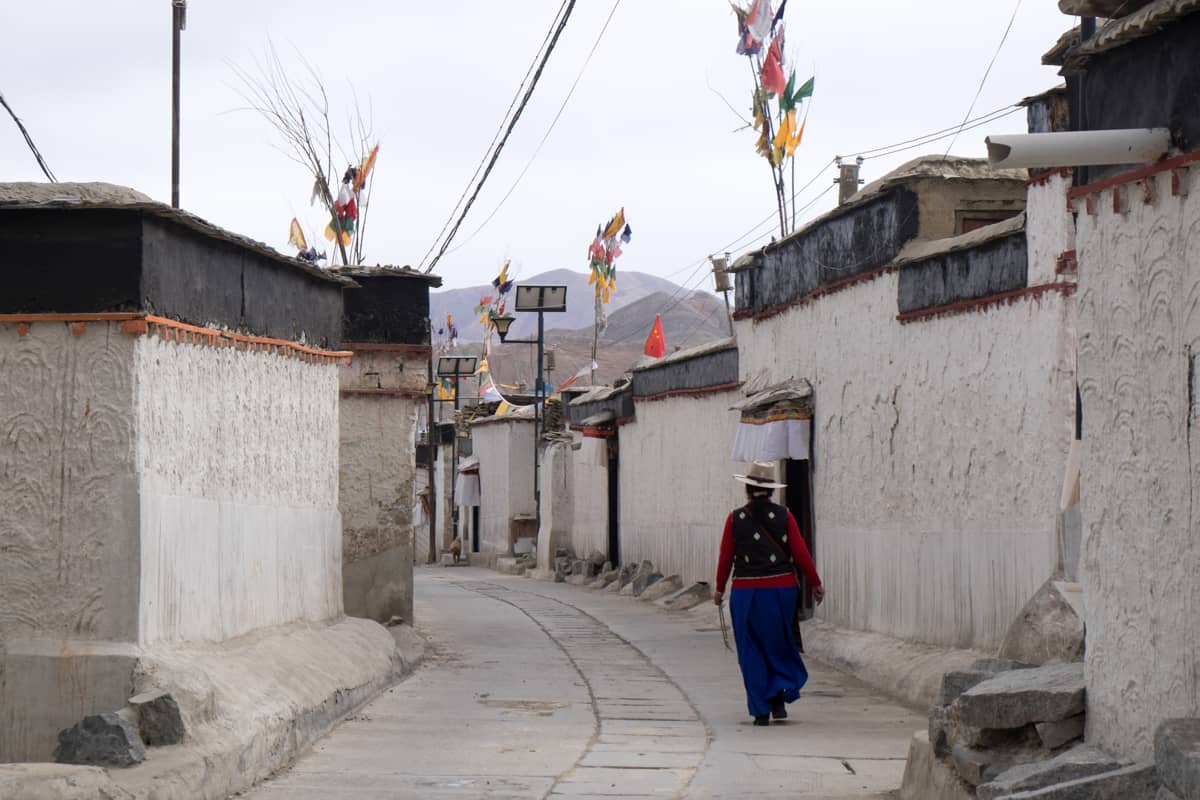
A Tibetan woman in a traditional village in Shigatse
Better known as the Panchen Lama’s traditional seat (the second highest order of the Dalai Lama), Shigatse is on the map because its home to Tibet’s best-preserved Monastery Tashilompo Monastery where once, 4700 monks lived.
It’s considered by pilgrims to be the second Potala Palace and is visited daily by hundreds of people here to see the 26m high Buddha made from 278kgs of gold.
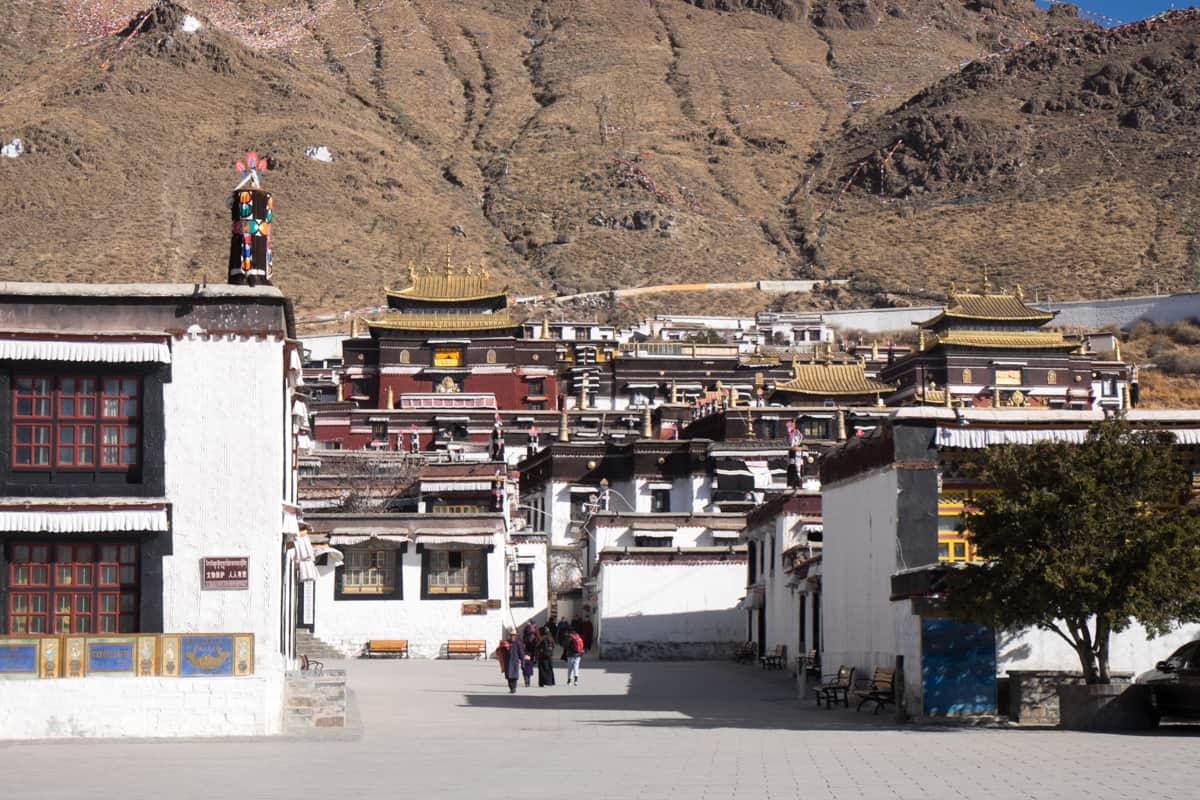
The Tashi Lhunpo Monastery in Shigatse Tibet
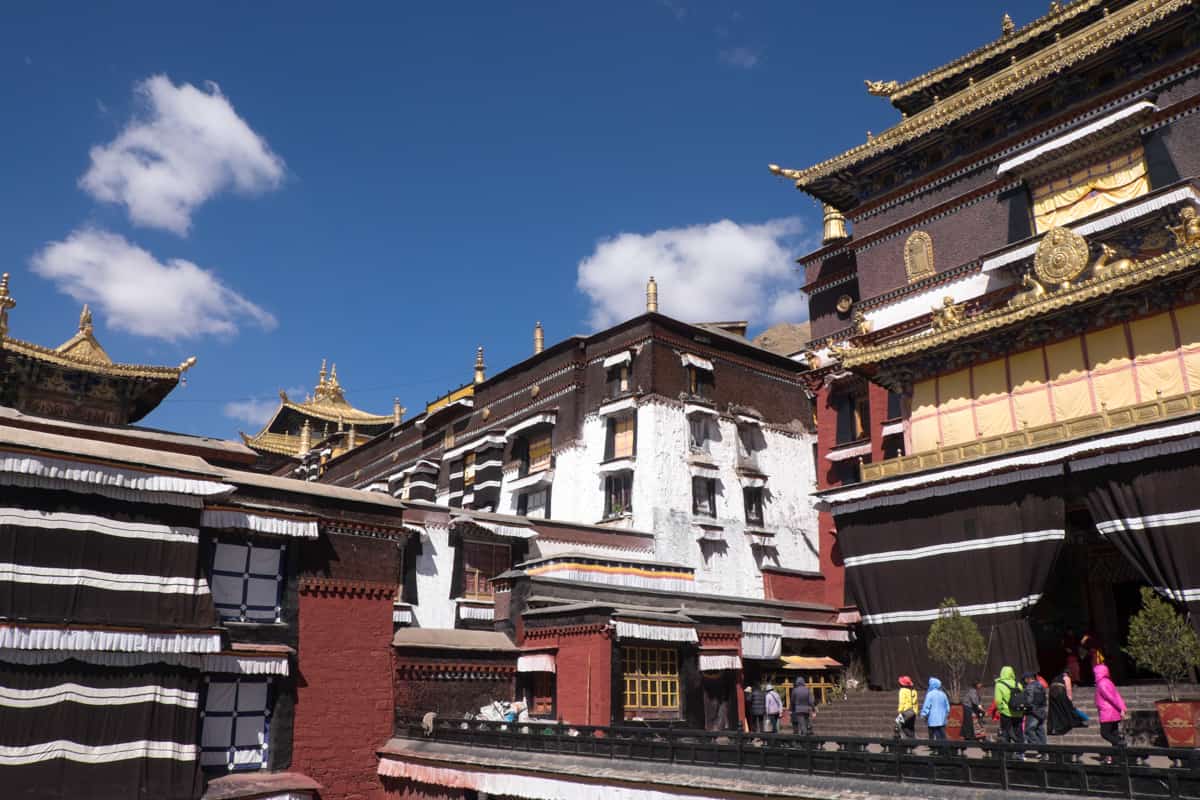
A short drive from Shigatse, our time in neighbouring Shegar was a sleepover point at 4,300m, ready for the nine-hour drive to Everest Base camp the following day.
Elevation 4980m
On the way to the Everest Base Camp area, you get to visit the Gyatso Pass at 5248m – the highest pint you will be on the trip. Another accolade to rack up here is to say you’ve used the highest toilets on earth.
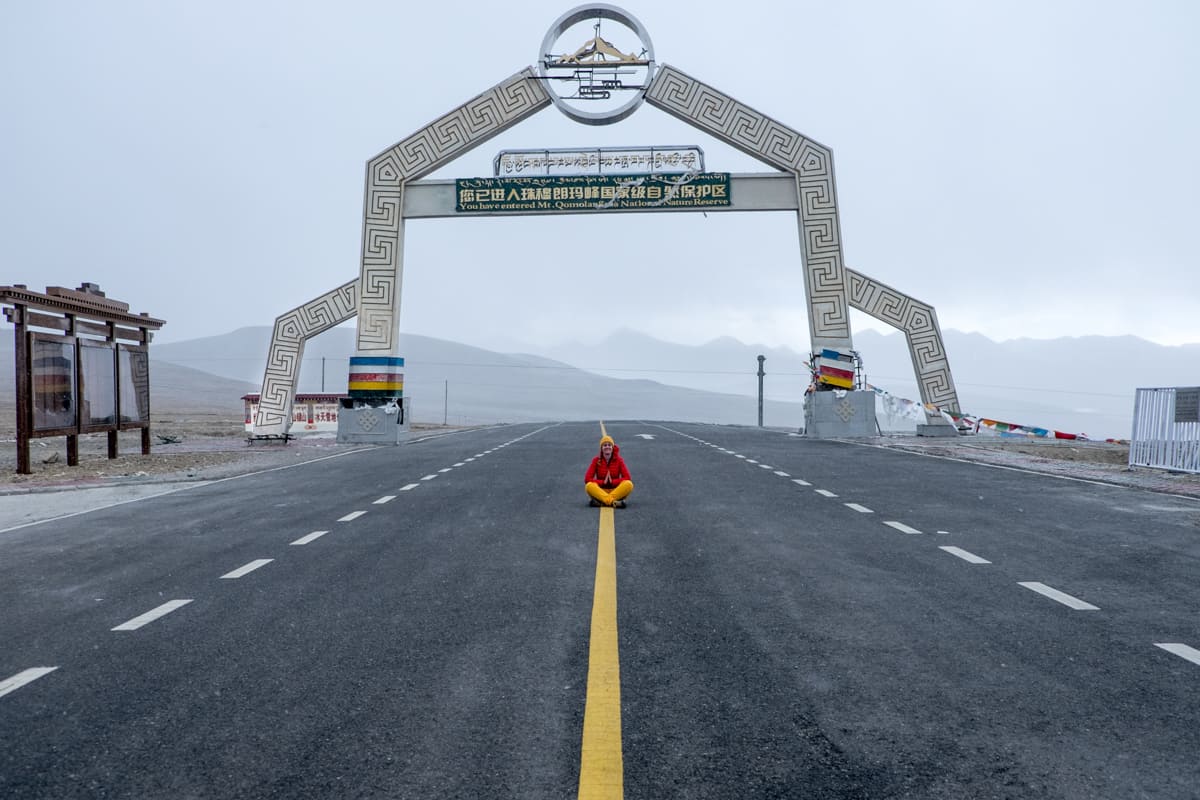
The Gyatso Pass – the highest road in Tibet
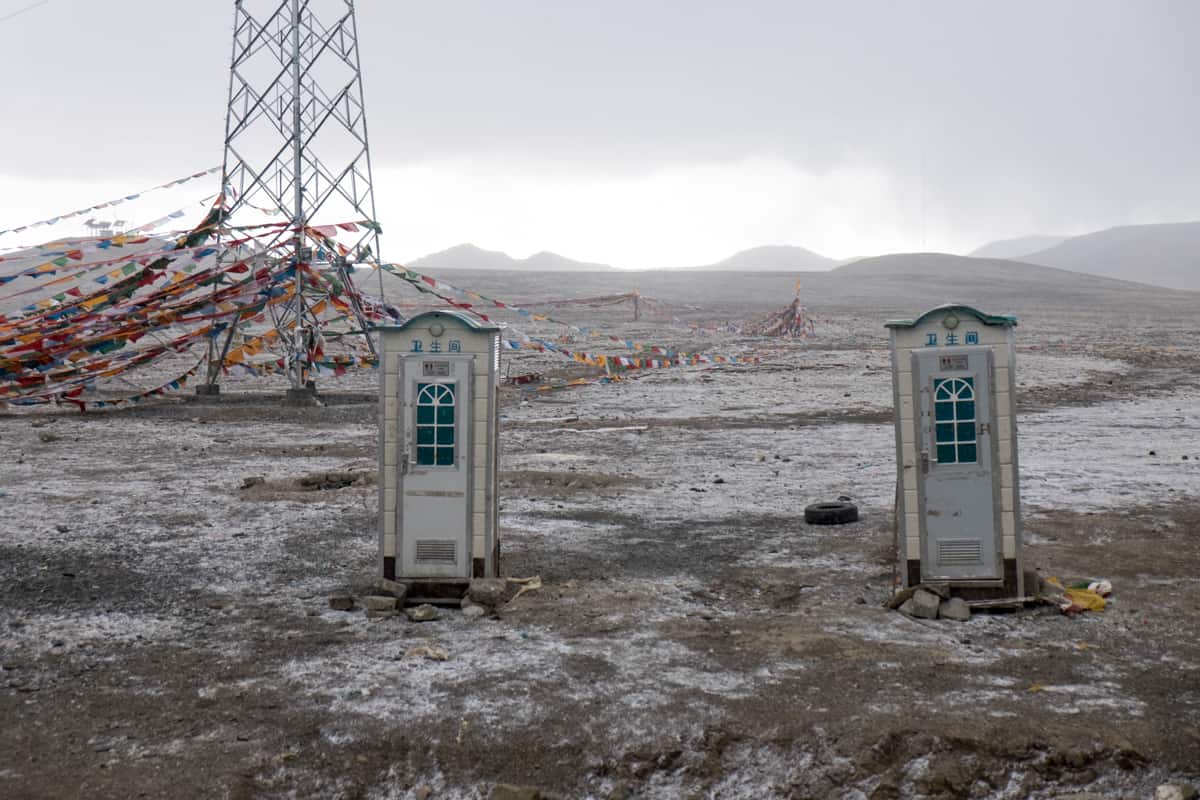
The toilets on the Gyatso pass in Tibet are the highest toilets on earth!
The drive to the Rombuk Monastery was an endless stream of white-capped mountain scenery, with everybody in the vehicle full of excitement with every glimpse of Everest as we rounded corners and valley walls.
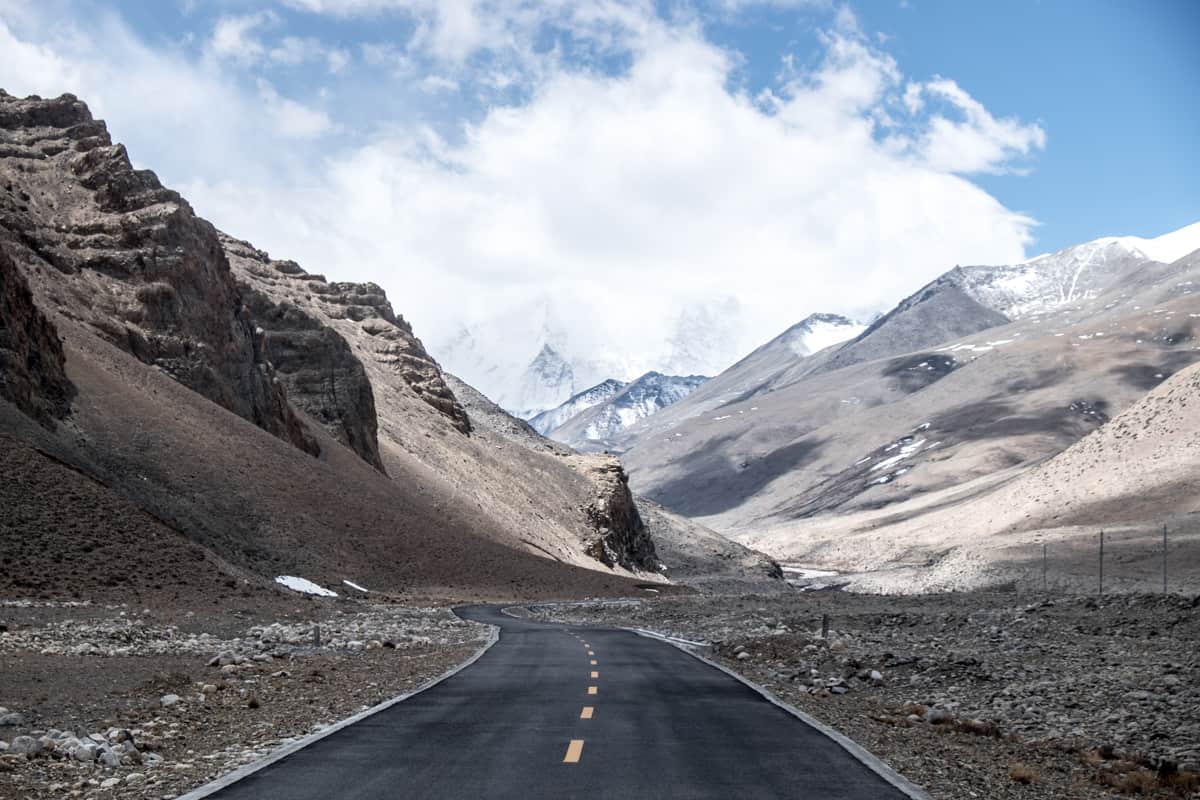
View of Mount Everest in Tibet
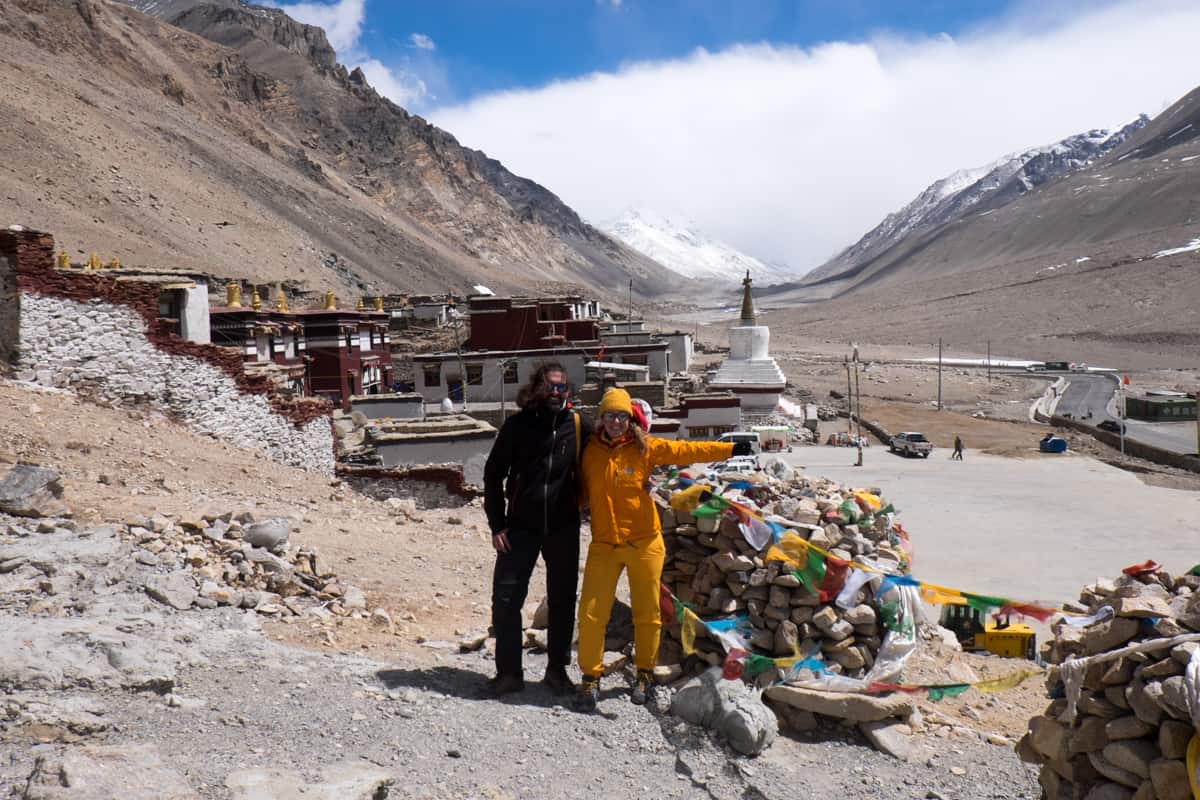
Rombuk Monastary view to Tibet Everest Base Camp
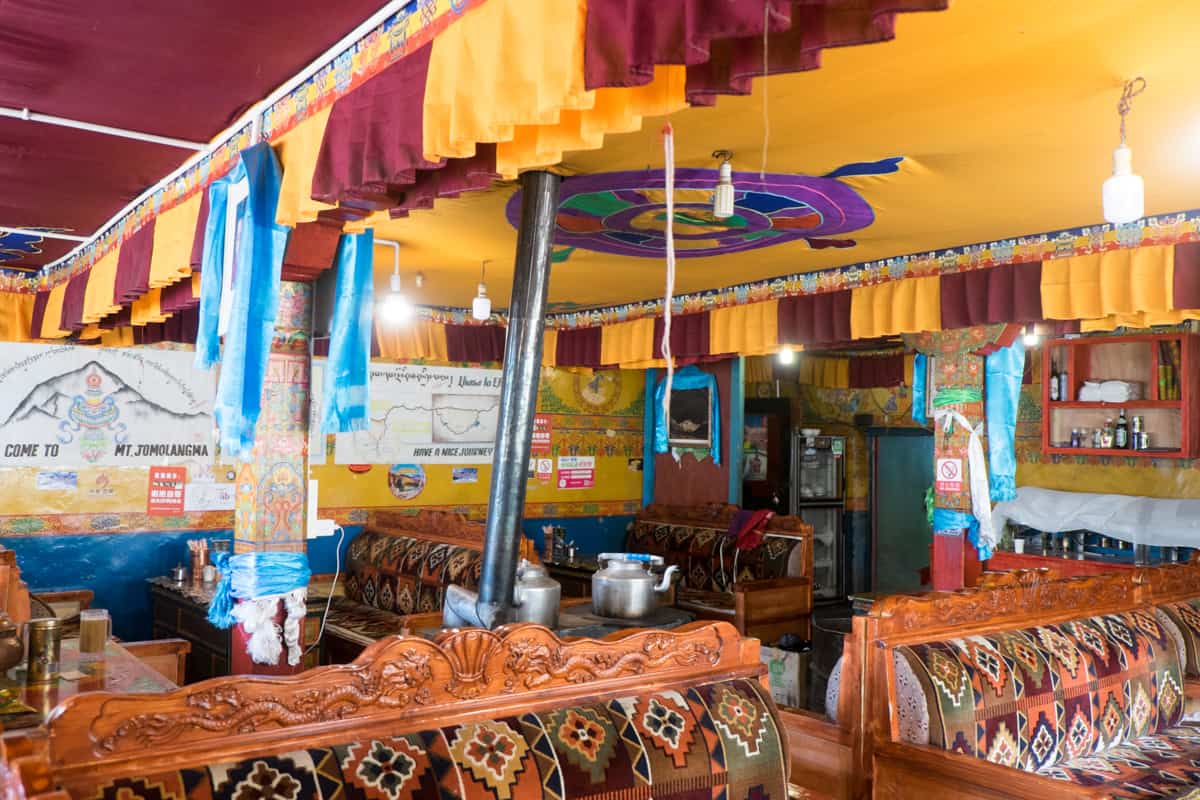
Inside Rombuk Monastary at Tibet Everest Base Camp
The Monastery stay is basic but comfortable, with a chance to walk to the Base Camp checkpoint and climb a small view for an elevated viewpoint. On the other side of Everest is where my first mountain adventure completing the Everest Base Camp Trek, began in Nepal seven years ago. Everest Base Camp on the Tibet side might have been moved back by 7km, but nothing beats the view we had of the world’s highest mountain.
READ MORE: Everest Base Camp Trek, Nepal – Reaching the Top of the World
Overnight it had snowed, so we were able to take another walk towards Everest as it stood glowing with a golden morning halo.
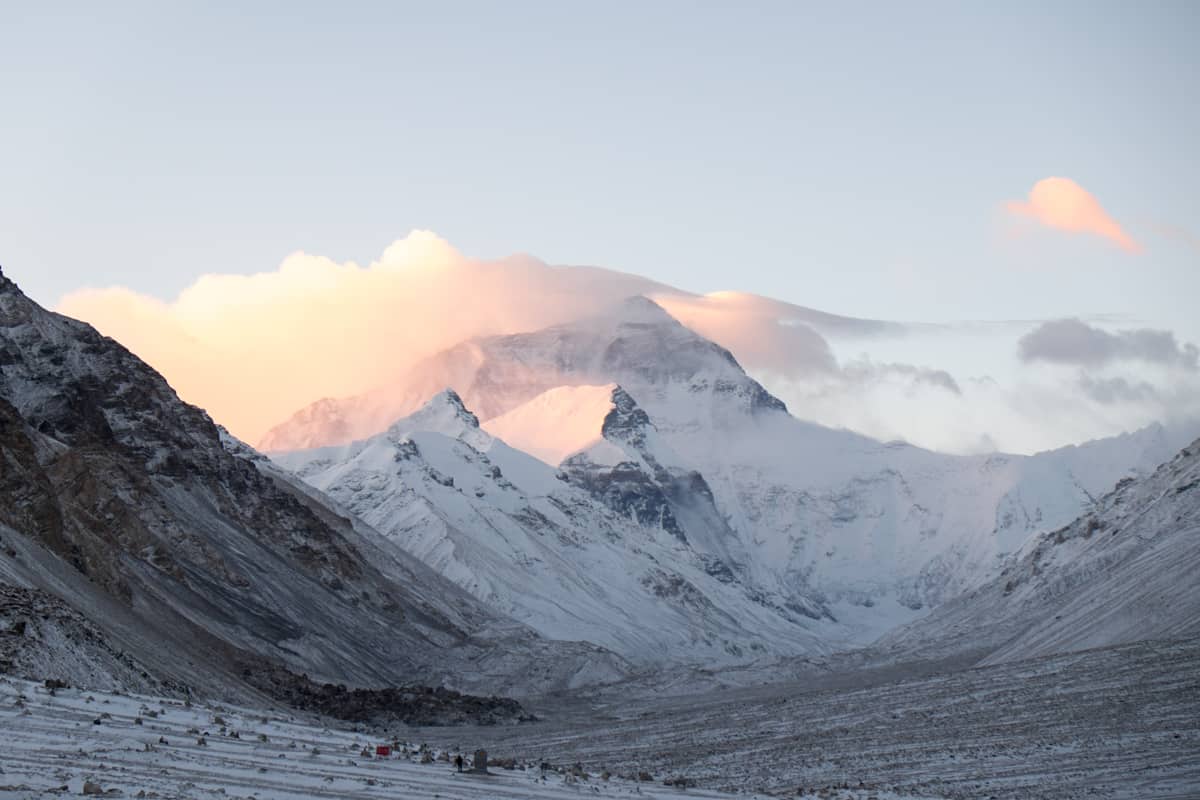
Leaving Mount Everest behind, we took back to the road for a 9-hour drive to the Nepal-Tibet border town of Kyirong. While there is not much to see here, it is where we had our last Tibetan dinner and a good night’s rest before the 10-hour drive back to Kathmandu.
What to Pack for Tibet
- Layers including merino wool thermals , t-shirts, fleece, windproof or tri-climate jacket and a waterproof jacket. I layered as swapped and changed. One minute it’s sunny, and you work up a sweat walking around. The next, you will be jumping out of the car to snap away at the valley ridges and mountain scenes where it’s cold, windy, raining or even snowing. Every day is a surprise.
- You will need modest clothing covering shoulders and knees for when you enter monasteries, temples and other religious areas. Casual long-sleeve travel tops are acceptable, or best tops with cardigans or light-sport jackets.
- Jeans and hiking trousers ( Mammut are my go-to brand for fit and comfort). Wear your most comfy pants for long journeys, my favourite being my roomy, yellow climbing pants.
- Gloves and a hat for those cold, windy and sometimes snowy conditions at high heights
- Trekking shoes (better when walking outside in more adverse weather conditions and walking at Everest Base camp) and sneakers / comfortable walking shoes for general city wandering. My top picks are the Asolo hikers and the tougher Salewa MTN Trainer Mid GTX range. I have Vivobarefoot for everyday walking .
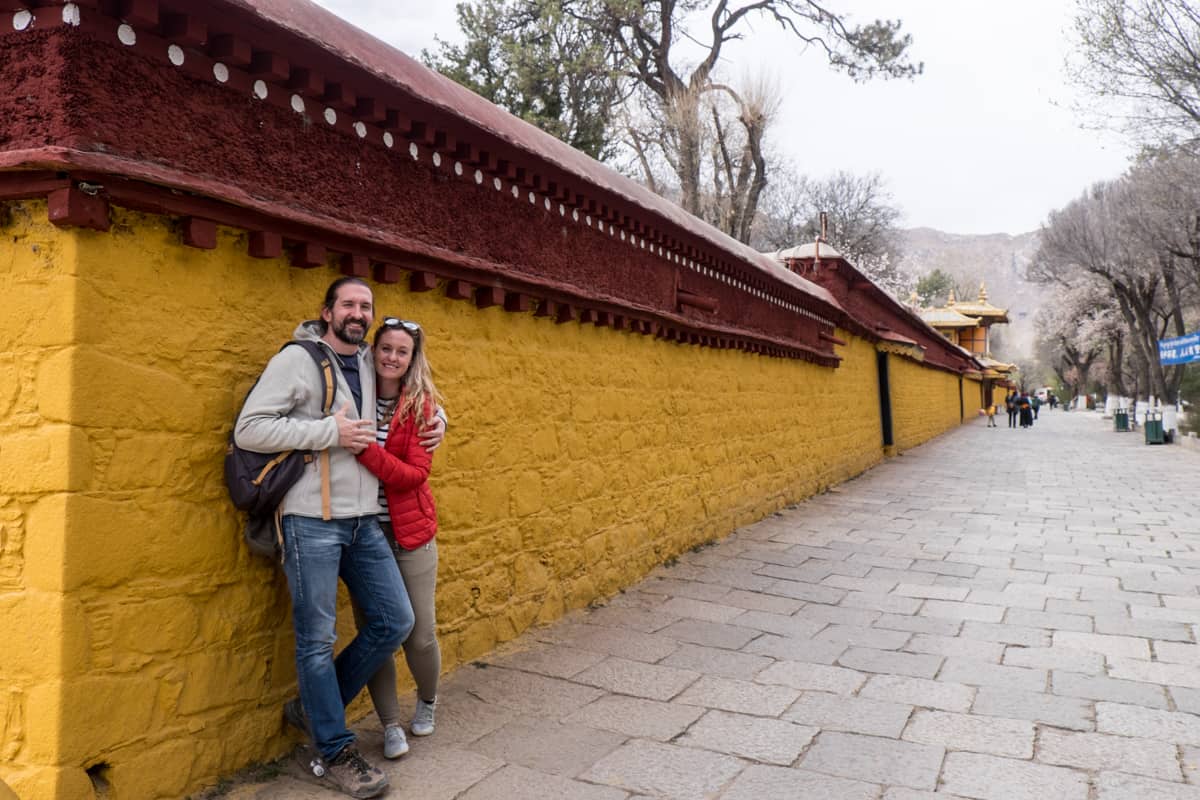
- Sunglasses and sunscreen. Particularly in the morning to mid-afternoon in Lhasa, the sun was extreme. A sun hat is recommended for those more sensitive to the heat.
- Silk sleeping liner for an extra layer at Everest Base Camp and monastery stay and a head torch since the toilet is in a separate building outside of your room. If you have the time to shop around, you can also find these items in Kathmandu before the trip start.
- Toilet paper for roadside ‘nature toilets’ and squats.
- Hand sanitiser (diarrhoea is one of the main health issues for Tibet)
- A Microfibre travel towel is a good, lightweight extra (where you might need a fresh, clean towel or for use at EBC).
- Snacks for sustenance on the road. I usually take a week’s worth of protein and healthy snack bars .
- Painkillers (also to help with early-onset symptoms of altitude). I was able to get stronger 600mg Ibuprofen, only on prescription from my doctor. However, they were vital in curbing the early onset of migraines which would have caused further sickness.
Take crisp, new dollars with you for exchange in Tibet to Chinese Yuan. The ATM didn’t work for everyone. It was also impossible to get a large number of Rupees changed to dollars while in Nepal.
Altitude sickness can occur in some people around the 2,500 m, but everyone is different. For example, I start to feel sick at 4,000m, and it has taken a few trips and treks to work that out.
But the high altitude in Tibet isn’t something to be worried about. The trip is designed to allow enough time in Lhasa to acclimatise and includes many ‘high to low’ drives to cover various altitudes, so your body adjusts. There’s a precise science to the trip itinerary, the route and the designated stops that has you covered without you having to overthink it, but here are some extra t ips for avoiding altitude sickness when in Tibet.
Avoid intense activity when you get to Lhasa. Our trip specifically had four days on the ground to ensure enough time to acclimatise and take things slowly. Stroll, and rest when you feel your body is getting tired. It’s always about listening to your body.
Say hydrated . Drink plenty of water and get plenty of sleep. Dehydration and fatigue are not what you need on this trip when some days involve a lot of sightseeing and long walks around sites. You can pick up dehydration sachets in Kathmandu, which you’ll find in all supermarkets stocked up for those about to go trekking. Or take electrolyte drinks, tablets or salts with you .
Be aware of your body as you slowly climb to a higher altitude . Our G CEO carried a finger pulse monitor, and each day we wrote down our heart rate and oxygen levels. This daily test allowed him to monitor anyone in the groups who could be sick or face any potential issues ahead of time.
You can purchase Diamox tablets in Kathmandu before the trip. However, we managed to find a herbal tablet version in Lhasa that we could begin taking as we were leaving Lhasa to prepare for higher altitudes.

Travel Tibet and Come Back Changed
Tibet is an emotional dive into an ancient Buddhist culture and a journey through the Himalayan plateau’s highlands. A sensorial spectacle on multi-levels that you won’t ever forget.
For further information on the Tibet tour, including the departure dates during the seven-month travel window, see the High Road to Tibet trip overview . I travelled with G Adventures as an ambassador to promote destinations responsibly and where tourism money and practice is used for social good.
Travel Tibet and see it from a different perspective
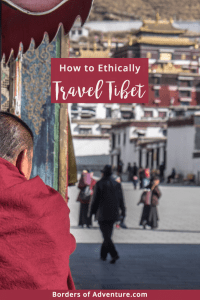
About Becki
Becki Enright is a British Travel Press Award-winning writer whose work focuses on changing perceptions about misunderstood aspects of destinations. Her writing combines storytelling with insight into the social, historical, political and economic factors that shape the country or place in relation to tourism. Becki has appeared live on Sky News and CNN and has contributed to high profile media including National Geographic, Time.com, Guardian online, New York Times, Grazia and Buzzfeed.
Tenzin says
6 January 2021 at 10:43 am
I thoroughly read your whole article about Tibet travel and really mind-blowing! I love the place and the people in Tibet.
31 October 2019 at 7:19 am
Tibet is really an amazing place with wonderful people. The uniquely spiritual place offering fabulous monasteries, breathtaking natural views, stunning high-altitude treks as well as one of the friendliest people. By traveling in Tibet, you will appreciate the visual feast and experience a lifetime cultural encounter.
Deborah says
25 July 2019 at 6:41 pm
This looks amazing. Thank you for this really thorough look into what a trip to Tibet can be and all the details to keep in mind. Great read!
26 July 2019 at 11:41 am
Thank you, Deborah!
25 July 2019 at 11:54 am
I had no idea Tibet was so fiercely policed – it seems crazy to me that you can’t even enter with a ‘Tibet’ guidebook! But I really admire and respect your view point on this, Becki: it would be very simple to just not go as some form of boycott or protest, but I think it’s important to visit to meet people, support their economies and take in the reality for yourself – without bringing your own political agenda on board and trying to place others (i.e. tourguides) in compromising situations.
25 July 2019 at 2:48 pm
It can be a hard choice for many, in choosing to go or not. But my stance, as you picked up, is always to go and witness things for yourself, make your own informed decisions and support the local people. China’s control here does exist with paranoia, and the situation is complex, delicate and emotionally charged. Yet, Tibet is somewhere with such immense beauty and unique spiritualism that it should be experienced. All we can do is tell our stories.
Leave a Reply Cancel reply
Your email address will not be published. Required fields are marked *
- Article Archives
- Work with me
- Privacy Policy


Tibet 2024 Guide & Tips
Your Guide to Travelling to Tibet
What do you imagine when someone mentions Tibet?
Well, we know how the “Roof of the World” looks like in popular imagination. Seclusion. Peaceful yaks. Chanting monks in vermillion and saffron robes. A place that captures your senses. And then leaves you with new discoveries about you and the world itself. In fact, Tibet is much more than that. Yes, you’ll encounter everything found in pictures and videos online. But there are things no smartphone can capture.
An example of how Tibetan civilization honors the gods through temples.
Tibetan masks with various colors hanging on a door in lhasa.
Tibet is unique in its geography, culture, and biology. The history spans thousands of years back to the Neolithic. Throughout the vast times, Tibetans created a stunning civilization . You can’t find Tibet anywhere else on our planet. It’s there and waiting for you. If you have an adventurous spirit, then this is your next destination. Planning a trip consumes time. And some places need more effort than others. Tibet isn’t suitable for a spontaneous, book-a-day-before type of vacation.
- Where is the "Roof of the World"?
- Why visit Tibet?
- What's the best time to go there?
- How to get there?
- Where to stay?
- What are the best tours?
- Where to go and what to see?
- How to get the travel permit?
- How to pack?
In the following paragraphs, you’ll learn all you need to know about Tibet travel.
Just read on further:
Where is Tibet? – The “Roof of The World”
Tibet is a remote region on a plateau north of the Himalayan Mountains. The Tibet Autonomous Region stands in the westernmost part of China. The countries of Bhutan, India, Myanmar, and Nepal are in the South.
Did you know the average altitude is 4300 meters above sea level? For many of us, it’s the highest place we’ll ever visit in our lives.
Tibet and its plateau formed as a result of powerful geological forces. The Indian Subcontinent pushes into Asia. Currently, this creates the Himalayan Mountain Range. The range grows centimeter by centimeter every year.

Why is Tibet worth visiting?
You’ll have a kaleidoscope of memories. The beautiful and haunting monk chants in the monasteries. That hustle and bustle of the Barkhor Street Market. Even just the idea that you step into a truly iconic region in the world.

The curiosity to see the land and its symbols might pull you here. But the locals’ open and warm hearts and their gracious smiles leave impressions for a lifetime. As a fascinating destination, Tibet is one the must-visit list of many travelers.

What is the best time to visit Tibet?
People mostly visit Tibet from March to May and September to October. The days tend to be warmer and sunny. There might be light showers in the afternoon, but generally, there’s not much rainfall.
Lhasa is a great destination all year round. Autumn means beautiful scenery of an endless color variety. Winter helps you avoid the influx of Chinese tourists seen by other seasons. And it doesn’t get as cold as you might imagine.

Springtime is another great time to visit Lhasa. The awakening of nature provides a captivating backdrop for your stay. What about the summertime? Lhasa allows you to escape the hot weather. It’s true that there’s more precipitation, though. Luckily, the rainfall often arrives at night.
But some of the Tibetan highlights do have distinct favorable times to visit. Hiking Mt. Kailash is best from May to July and September to October. Schedule Everest Base Camp trek between May and June. Visiting Ranwu Lake works best from April to May and September to October.

Have any questions about the best visiting times for any other Tibetan sights? Feel free to message us now!
How to get to Tibet?
You may fly into Lhasa from anywhere in the world. Nowadays, even the most distant places aren’t more than three connections away. Any of the major Chinese cities do fine as your last stop before Tibet. Since Tibet is in China, you must pass through customs at any of the major hubs.
Are you already in China? Or have a bit more time? Taking a train from mainland China to Tibet is a special experience. The train from Beijing or Chengdu to Tibet moves on the highest train tracks in the world. This train route crosses through the Qinghai grasslands. The region contains plenty of wildlife.

Accommodation in Tibet
You’ll find a wide range of accommodation options in Lhasa. Depending on your budget, you can opt for a simple guesthouse or more upscale hotels. Keep in mind that the accommodation comfort level outside the major cities is basic. That said, in cities like Lhasa and Shigatse, you could expect the best hotels to easily reach four stars.

Guesthouses

This is a distinct type of accommodation that’s usually family-owned. Everyone in the household contributes to keeping the place running. Often, these guesthouses are called teahouses as well.
So, what could you expect from the experience? Guesthouses typically have multiple beds in one room. There is a public bathroom outside. Some hotels in big cities, like Lhasa and Shigatse, have both standard Western-style rooms and multi-bed guesthouse style provided for the clients.
In Rongbuk Monastery guesthouse, you are able to pick between single beds, one double bed, or multiple beds in one room. Another aspect concerns remote areas. When you trek 2-3 days around Mount Kailash, for example, the guesthouse is a movable plank house. It’s better to take your sleeping bag for hygiene and keeping yourself warm. In most guesthouses, you are able to order some basic food items. For example, some places cook fried rice, chowmein noodles, or Tibetan soup.

Are you planning to do some trekking? Expect plenty of nights spent in a tent. In many cases, the tents are large dome tents for backpacking. But when you do Everest Base Camp, you’ll probably get accustomed to wall tents. Generally, these wall tents have wooden frames. Compared to the dome tents, these structures have more space.
The porters set up the main tent as well. Usually, you’ll enjoy your meals in the main tent. And in the Everest Base Camp, you’ll encounter teashops and snack places set up in this type of tents.

What are the best tours in Tibet?
You can experience Tibet by participating in a variety of tours. In reality, there’s not a single best Tibet tour.
It’s all individual. The best option for you is to check what tours are available.
What’s that one place you couldn’t leave Tibet without seeing it first? Maybe you have a bucket list of Tibetan sights. Check which tours come closest to reaching your dream trip.

But, for starters, you should decide whether you want to partake in a group or private tour. Private tours allow for a more intimate and tailored experience in the region. But they come with an expensive price tag. Group tours allow cutting costs without skipping any important sights.
Small group tours provide the perfect balance. You won’t be in a group so big that you’ll not even learn all the peoples’ names. But you’ll neither pay the steep fees of a private tour.

The next step is to pick the destination(s) and duration of your Tibet tour. There are many options to choose from. Eight days in Everest Base Camp ? Or five days combining Lhasa and Yamdrok Lake ? Some travelers even book more than one tour and spend some time in Lhasa between the tours.
Trekking is very popular in Tibet . The terrain provides plenty of challenges while the surrounding scenery rewards the strenuous activity. There are less hikers in Tibet compared to the neighbouring Nepal. And that’s just great because you’ll have more personal space to admire the dramatic landscapes.

Things to do and places to see
Don’t trust anyone who says they have the complete list of things to do in Tibet. There’s too many to count. And some of the moments and experiences aren’t something you could plan ahead. It’s just the magic that happens when you travel.
But in the following list, you’ll find some of the best things to do in Tibet in our opinion. Check out our blog for further information on the particular sights, activities, and things to do in Tibet.
Some of the best things to do in Tibet include…
Stunning lakes in Tibet
Yes, there are numerous lakes to be visited in Tibet. You could even say that lakes are as sacred to the locals as monasteries and temples. When you walk along the shores of one of these lakes, you’ll know exactly what we mean.

Consider visiting Yamdrok Yumtso. This lake is a stop along the popular drive from Lhasa to Gyantse. The trip allows you to eventually reach Everest Base Camp. There are many wonderful monasteries on the way as well.
The other lake highlights include Namtso in central Tibet and Peiku Tso. The former proves to be spectacular when you are lucky enough to have white peaks in the background. But the latter gets a water reflection of mighty Mt. Shishapangma standing at a dizzying height of 8,013 meters.
The timeless classic: Everest Base Camp
Everest Base Camp (EBC North). This is the legendary destination in Tibet. You could pair EBC with a visit to the Rongbuk Monastery. We recommend doing an overnight stay. You’ll get up close and personal with the world’s tallest mountain. A beautiful experience of a lifetime to be savored!

Unforgettable Jokhang Temple
There are many temples and monasteries to visit in Tibet. You can find this particular sight in the heart of Lhasa City.
It’s a major pilgrimage center for all schools of Buddhism. The place was built in the 7th century. UNESCO designated it as one of the World Heritage Sites.

Monasteries all over Tibet
There are visitors who come to Tibet only for the monasteries. Many stunning buildings await, but there are a few must-visit ones out there as well. Three Great Temples are made up of three monasteries: Ganden, Drepung, and Sera. Visit at least one of these!

And then there’s Rongbuk Monastery. Rongbuk is a very special place because it’s the highest monastery in the world. The place is made up of a working monastery, and then an older one maintained by a solitary Lama. Rongbuk is located near the Everest Base Camp.
Getting the Tibet Travel Permit
You need a special permit to visit Tibet. In most cases, a tour company can process all the permits for you. Still, let’s take a look at some useful tips concerning Tibet permits.
Tibet Permit Tip #1: Getting the permit
Taking a plane to Tibet? Hopping on a train? The particular mode of transport doesn’t matter. You need a Tibet Tourism Bureau (TTB) permit. You can only get this by using a guide along with a travel company for the duration of your trip.
Also, you need private transport for trips outside of Lhasa. Travel in Tibet without the supervision of a licensed guide isn’t possible.

Tibet Permit Tip #2: Extra permits
Tibet permit tip #3: timing for the permit.

Timing is crucial when you plan your itinerary. Keep in mind that your tour company needs 14 days at minimum to arrange the permits and post you the TTB permit. Important reminder: you still require the permit if your flights are only within China.
Tibet Permit Tip #4: Extra permit for Kathmandu, Nepal
You could travel overland from Kathmandu (Nepal) as well. Doing this requires an extra permit. You might find that continuing your journey into China could become difficult after obtaining the extra permit.

What to prepare for Tibet?
Let’s take a quick look at the essential things you need to have for your Tibet trip. You’ll find a longer list of packing suggestions in our blog.
Travel documents
Sort out all your travel documents beforehand. You need to have Chinese Entry Visa. Additionally, you have to get a Tibet Travel Permit (TTP). Only a registered tour operator can help you with the latter.

Proper clothing for Tibet exploration
This is a very important aspect to consider when packing for your Tibet tour. The temperature can make a huge drop in the nighttime. When staying in simple guesthouses or tents, it’s better to prepare accordingly.
Clothing should be layered. Think of an onion when packing your clothes! Even outside the winter, weather can sometimes vary a lot during a single day. Also, the temperatures and the general atmosphere changes when you gain or lose altitude.

Electronics and adaptors

Take an adaptor because you may encounter three different types of plugs in Tibet. Take your camera or a smartphone with a good camera. There are plenty of amazing shots to be taken in this region.
Personal hygiene
Take all the personal hygiene products with you. These include shower gel, shampoo, toothpaste, etc. Definitely take a hand sanitizer gel. This comes handy in places where you don’t have any chance to wash your hands. Also, it’s smart to have some extra toilet paper and wet wipes with you while traveling in Tibet.
The bottom line of travelling to Tibet
Travelling to the “roof of the world” is an incredible experience. You want to plan ahead because it’s not a book-and-go destination. Visitors need an official permit along with a local guide.
In this guide, we outlined all the basics you need to know when planning a trip to Tibet.
Became excited? Tibet is just a click away.
Select the tour and submit your information
*Select your preferred tour from the list and we’ll get back to you with the available departure dates!
Tibet Travel Guide

Courtesy of mamahoohooba | Getty Images

Why Go To Tibet
Tibet is a region in conflict. To the Chinese, Tibet is an autonomous region part of their country, but to Tibetans, they are (and hope to become again someday) an independent country. The details of this clash are subjective, depending on who you ask, but since China's invasion into Tibet in the 1950s, Tibet has never been the same. Since then, assimilation has been heavily resisted, the Dalai Lama – Tibet's spiritual and political leader – has gone into exile (and has remained so for about 50 years) and locals continue to cling tight to a culture that has been systematically fading away for decades. Some Tibetans have gone to extremes to get the world to notice, and people have been listening.
Part of Tibet's draw is no doubt seeped in its political struggles, but the region is so much more than its conflict with China. Beyond the history and the headlines lies a beautiful land rich with culture and natural splendor unlike anywhere else in the globe. Tibet lies on the highest plateau in the world, earning it the nickname "the roof of the world." Here, you'll find the highest everything, including mountains (Everest is here), lakes , roads, railways (the Qinghai-Tibet Railway) and even post offices (found at Mount Everest Base Camp ). This altitude dictates Tibet's day to day, but not as much as its namesake religion. Tibetan Buddhism is the foundation of Tibetan culture, and locals' dedication to their faith is nothing short of inspiring. Observing this spiritual devotion is tantamount to understanding Tibet and its people. So while here, don't interject what you know but seek out what you may not and you'll surely be, as the Buddhists themselves say, enlightened.
Find Flight and Hotel Deals
Navigate forward to interact with the calendar and select a date. Press the question mark key to get the keyboard shortcuts for changing dates.
Navigate backward to interact with the calendar and select a date. Press the question mark key to get the keyboard shortcuts for changing dates.
Best of Tibet
Best hotels in tibet.
- in The St. Regis Lhasa Resort
- in Intercontinental Resort Lhasa Paradise
- in Shangri La Hotel Lhasa

Best Things to Do in Tibet
- # 1 in Jokhang Temple
- # 2 in Barkhor Street
- # 3 in Potala Palace

Popular Tours

8 Days Lhasa to Mt. Everest (EBC in Tibet) Join-in Group Tour with 4-star Hotel
from $ 960.00

8 Days Lhasa to Everest Base Camp Small Group Tour
(216 reviews)
from $ 967.00

7 Days Lhasa to Kathmandu Overland Small Group Tour
(15 reviews)
from $ 1159.00
Tibet Travel Tips
Best months to visit.
The best time to visit Tibet is from June to August. Situated high on a plateau, Tibet experiences low temperatures and frost for the majority of the year. Summer is the only time where temperatures hover in the 70-degree range during the day. Plus, oxygen content is the highest in the summer, making it easier to acclimate to the altitude. Spring and fall are also good times to visit if you're looking to beat the summer crowds, but expect chilly, winter-like nighttime temperatures. On the upside, spring and fall provide better visibility than the summer months if you've come to see Mount Everest . Winter is characterized by freezing temperatures. And roads to the mountains and other remote attractions can be closed off due to the elements. Plus, entry permits are not given to foreign visitors from February to March and sometimes to early April.
Weather in Tibet
Data sourced from the National Climatic Data Center
What You Need to Know
- Prepare for the altitude Because Tibet sits high on a plateau, there is up to 40 percent less oxygen than at sea level. You will likely experience symptoms of altitude sickness for a couple days, including breathlessness and headaches. Because of this, you should save trips to the mountains and other remote areas until after you've acclimated to the altitude.
- You have to visit on a tour Travelers are not allowed to obtain Tibet entry permits independently, only tour operators can do that. When searching for a tour, make sure it covers all the places you want to visit in Tibet. Additional permits are required to travel outside of Lhasa (Tibet's capital city).
- Don't talk politics Tibet and China have a very troubled history with each another, and conflict between the two still go on to this day. The relationship is so bad that Tibetans merely possessing a photo of the Dalai Lama or the Tibetan flag could result in arrest.
- Don't visit during winter While you'll no doubt get the best travel rates during this time, you'll also experience serious drawbacks including lower oxygen content, bitter temperatures and highway closures to remote attractions. Not only that, but Tibet closes its borders to visitors from February to early April.
How to Save Money in Tibet
- Visit during fall or spring Summer is peak tourism season in Tibet, meaning you'll be subject to the highest travel rates. Visiting during shoulder seasons could save you as much as 20 percent off travel rates.
- Bargain When shopping, especially on Barkhor Street , bargain with vendors to get a lower price on goods.
- Stay in Lhasa Since wherever you want to visit in Tibet must be on your tour group's itinerary (under the standard travel permit you are not allowed to travel outside of Lhasa independently), going on a tour that includes other destinations in Tibet will cost extra.
Culture & Customs
The most important thing to know about Tibet's culture is that it's dominated by religion. So much so that the Dalai Lama, who is the head monk of Tibetan Buddhism, is traditionally in charge of Tibet's government. Today, that is no longer the case. The current Dalai Lama (there have been 14 over the course of history) no longer rules Tibet, but instead lives in exile in Dharamsala, India. This has to do with China's incorporation of Tibet. It's important to know that this is a hotly contested issue among the Tibetans and Chinese. And depending on who you ask, you may get different stories.
For Tibetans, their land and culture was taken from them by China. Soon after Mao Zedong and his communist party drove out China's former nationalist party and established the People's Republic of China, Tibet was invaded. Whether or not Tibet was a truly independent country prior is subject to debate, but the invasion by China changed the region's way of life forever. In 1950, troops were sent in by the thousands from China. The army not only defeated the smaller Tibetan army but occupied a large portion of the country, leaving Tibetan leaders, including the current Dalai Lama, with no choice but to agree to their terms. In 1959, Tibetans revolted as a response to China suppressing their culture and religion. Thousands ended up dying in the clash and as a result, the Dalai Lama fled.
Today, Tibetan culture is still suppressed. Schools no longer teach in Tibetan, and while Tibetans are still able to practice their religion, everything remains closely watched (there are security cameras placed on the streets of Lhasa). Merely possessing an image of the Dalai Lama could result in arrest. And one of the reasons Tibet's borders are closed from February to the end of March or beginning of April is due to the anniversary of the 1959 revolt, which falls on March 10th. As a traveler, bringing the Tibetan flag or any kind of material about the Dalai Lama or Tibet's contentious history with China into Tibet is not recommended. Even Tibet guidebooks, including Lonely Planet guidebooks, have been known to be confiscated upon entering the region. Despite the restriction on language in schools, Tibetan is still widely spoken in the region. However, Tibetans don't have their own currency, instead they use the Chinese yuan. Be sure to check the conversion rate before you go , as it often fluctuates.
What to Eat
Tibet is not a foodie destination, but there are still some signature dishes and drinks from the country's cookbook that will certainly enhance your cultural experience. First, it's important to know that Tibet's mountainous terrain yields a very hearty diet. You won't find many vegetables or fruits here, as they have trouble growing in Tibet's dry, wintry environment. Instead, locals feast on meat, dairy, starches and stews. The most important dish in Tibet is momo. Momo are dumplings filled with everything from beef to yak's cheese and are loved by locals. Oftentimes, parties are thrown just to eat momo. Noodles and barley dishes are also a big staple in the Tibetan diet as well and, despite China's influence, you won't see a whole lot of rice here.
Yak is another big part of the Tibetan diet. Tibet is full of yaks, and along with providing photo ops for tourists, they are used to make cheese, butter and meat. Momo can also be stuffed with yak meat, and yak jerky is a popular snack. Another very popular snack is tsampa. Tsampa may be a bit strange to the western palette. Tsampa is roasted barley flour mixed with butter tea, dried dri cheese (dri is the name of a female yak) and often sugar. The ingredients are mixed into a dough but remain uncooked. The snack is known for being very powdery and as such, can cause a coughing fit. Be sure to not inhale before eating tsampa.
As for the signature drink of Tibet, that's butter tea. Butter tea is made with yak butter, barley powder and milk curds. The tea acts as fuel for nomads braving the cooler temps in the more remote regions of Tibet. But it's not just for the nomads, you can find butter tea all over. On Lhasa's Barkhor Street , you'll find tea houses and restaurants serving butter tea. Because of all its use of dairy and meat in its dishes, vegetarians and vegans may have a hard time eating in Tibet.
Tibet is pretty safe for tourists. That's because the Chinese keep a very watchful eye on Tibetans. Not only are there security cameras all over Lhasa, but guards patrol the city. Some don't even wear uniforms while on duty. There are also numerous checkpoints situated throughout the region's highways. There have been some reports of pickpocketing in Lhasa but overall, theft is not common. However, travelers may encounter political protests from Tibetans. If you do, follow the instructions of your tour group leader. While visiting, don't talk politics or bring any kind of material about the Dalai Lama or Tibet's history. Consult the U.S. State Department's website for updates on any potential threats and consider enrolling in the Smart Traveler Enrollment Program (STEP) to receive security messages.
Getting Around Tibet
The best way to get around Tibet is with your tour group. Due to the provisions of Tibet's travel permits, all forms of transportation around Tibet must be prearranged through a tour group. If you want to venture outside of Lhasa, Tibet's main city and tourist hub, you have to apply for an additional permit through your tour company. You are not allowed to travel outside of Lhasa independently.
Within Lhasa, if transportation around isn't already provided for you with your tour (it usually is), the best way to get around is by taxi, as rates are fairly inexpensive. There are also pedicabs, but due to their reputation for overcharging tourists, they should be avoided. You can rely on your own two feet, but keep in mind that most top attractions in Lhasa are more than a mile apart. Buses are available but can be confusing for foreigners as route timetables are in Chinese.
Getting to Tibet is also organized by your tour company. Some tours include the price of transport to Tibet, while others only provide instructions for booking. All tourists come into Tibet through Lhasa, accessible via the Lhasa Gonggar Airport (LXA) and the Lhasa Railway Station. To get to either the airport or train station, you must first fly into mainland China. The Lhasa airport can be reached from a number of major cities in China, including Beijing , Shanghai , Guangzhou and Chengdu, the latter of which is the closest major city to Tibet. If your tour operator doesn't already provide transportation to your hotel, you can take a taxi from the airport (about 40 miles south of the city) into Lhasa for between 130 and 300 yuan (around $20 to $45).
The Lhasa Railway station is closer to Lhasa, making taxi fares more affordable (it will cost you 30 yuan, or around $5 to get into town). However, your journey via train will be a lot longer (from Chengdu, it's more than a daylong trip). If you're willing to endure the long transit time, consider riding the Qinghai-Tibet Railway, the highest railway in the world (more than 13,000 feet above sea level). This 20-hour journey (starting at Xining) is lauded for its scenic route, passing through snow-capped mountains, untouched valleys, and alpine lakes and rivers.
Entry & Exit Requirements
U.S. citizens must have a passport that is valid six months beyond their departure date to enter China. U.S. citizens are also required to obtain a visa. There are 16 visa categories for foreigners entering China. Your trip will likely fall under the "L" category, designated for people visiting China as tourists. In addition to an application, photo and passport, you'll have to provide copies of your hotel and round-trip airline reservations. And depending on where you live in the U.S., you may also have to provide proof of residency for that city.
Chinese consulates and embassies don't accept applications by mail, email or fax, so if there is a consulate office in your city it's best to just drop it off in person.If you don't live in a consulate city, you should use a visa service like My China Visa , which will deliver the application for you. Visa applications take about four business days to process, but since processing times can vary, the Chinese Embassy recommends that you arrange your visa at least a month before your trip. The cost for a single-entry visa for U.S. citizens is $140. For more information on visa requirements, visit the Chinese Embassy's website .
Once you've secured your Chinese visa, you need to obtain a Tibet Tourism Bureau permit for traveling to Tibet. Since foreign citizens are not allowed to travel in Tibet independently, your tour operator will be the agency helping you secure your permit and is usually included in the cost of your tour. Keep in mind: Your permit can be checked anywhere in Tibet – at the airport, the train station, your hotel and even top attractions , so you should carry it with you at all times. Allow about two weeks for your tour operator to secure your permit. There are a number of tour operators that travel to Tibet, including National Geographic Expeditions , G Adventures and Tibet Vista , a reputable Tibet-based tour operator. Your tour operator will help you obtain the documents needed for your permit; and you'll need to obtain your permit at least 15 days before your scheduled departure. If you are flying into Tibet, you will need your original permit. If you are taking the train, a copy is sufficient. How you receive your permit varies by tour operator.
Potala Palace stands high above Lhasa at 12,000 feet above sea level. Because of the altitude, you should ascend the stairs slowly.
Explore More of Tibet

Things To Do
Best hotels.

You might also like

# 2 in Best Places to Visit in Thailand

Chilean Patagonia
# 2 in Best Places to Visit in Central and South America in 2023

If you make a purchase from our site, we may earn a commission. This does not affect the quality or independence of our editorial content.
Recommended
The 18 Best Napa Valley Wineries to Visit in 2024
Lyn Mettler|Sharael Kolberg April 23, 2024

The 25 Best Beaches on the East Coast for 2024
Timothy J. Forster|Sharael Kolberg April 19, 2024

The 50 Best Hotels in the USA 2024
Christina Maggitas February 6, 2024

The 32 Most Famous Landmarks in the World
Gwen Pratesi|Timothy J. Forster February 1, 2024

9 Top All-Inclusive Resorts in Florida for 2024
Gwen Pratesi|Amanda Norcross January 5, 2024

24 Top All-Inclusive Resorts in the U.S. for 2024
Erin Evans January 4, 2024

26 Top Adults-Only All-Inclusive Resorts for 2024
Zach Watson December 28, 2023

Solo Vacations: The 36 Best Places to Travel Alone in 2024
Lyn Mettler|Erin Vasta December 22, 2023

26 Cheap Beach Vacations for Travelers on a Budget
Kyle McCarthy|Sharael Kolberg December 4, 2023

The 50 Most Beautiful White Sand Beaches in the World
Holly Johnson December 1, 2023

Explore Tibet
Plan your trip to tibet: best of tibet tourism.

Essential Tibet

Trending in the forums
Tibet Is Great For
Art & history.
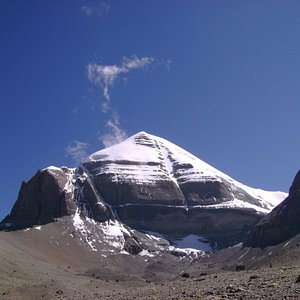
Historic sites

Ultimate Tibet Itineraries: How Many Days to Spend
Tibet is on many travelers' bucket list and is one of those dreamed-of destinations. Regarded as "the roof of the world", Tibet has countless snow-capped peaks, topped by awesome Mt. Everest, and more than 1,000 lakes, which dot the vast highland plateau like blue or green jewels. So where should you start your planning your Tibet trip? How many days are needed to explore Tibet's beauty? This article will help you plan a perfect trip to Tibet.
Content Preview
How many days to spend in tibet.
- 1. A Classic 8-Day with Everest Base Camp
2. A 4-Day Tibet Essence Tour Itinerary
- 3. A 7-Day Tibet Train Tour Itinerary
- 4. A 7-Day Tibet Trekking Tour Itinerary
5. An 11-Day Tibet and Nepal Itinerary
- 6. A 3-Week Tibet, Nepal, and Bhutan Itinerary
7. An 18-Day Tibet, Nepal, and India Itinerary
The number of days to spend in Tibet depends on places you want to see and experience. Generally speaking, we recommend spending at least a week to explore Tibet for a deeper experience. if you want to go on a more adventurous trip such as trekking or mountain biking, consider spending 10–14 days in Tibet.
If you have limited time, a 4–5 days trip to Lhasa would allow you to visit some of the major cultural and historical sites, such as the Potala Palace, Jokhang Temple, and Barkhor Street.
Many people combine Tibet with a trip to Nepal, which would take you 10–12 days. If you want to connect with more neighboring countries, like Bhutan or India, it would need 2 to 3 weeks. The following are some of the tour options from Tibet.
- Nepal: Spend 4 days to explore Kathmandu's historical and cultural sites. See more on How to Plan a Trip to China and Nepal
- Bhutan: Take 5 days to explore the top destinations in Bhutan, including Thimphu, Punakha, and Paro.
- India: Spend 7 days to visit top destinations, including Delhi, Agra, Jaipur, and Varanasi.
1. A Classic 8-Day Tibet Tour Itinerary with Everest Base Camp (Most Chosen)
In this classic itinerary, we have included cultural heritage sites, a holy lake, a glacier, and awesome snow-capped mountains on your way to Everest Base Camp. By joining our special village tour, you can interact with local people, which would enrich your knowledge of Tibetan life and culture.
Days 1–3: Lhasa
In Lhasa (after a day of acclimatization), our guide would take you to visit the top attractions, including the Potala Palace, Drepung Monastery, and Sera Monastery. To help you get a better understanding of Buddhist culture and find the best angles to take photos, our guides choose the best ways to explore the Potala Palace.
On day 3, have a walking tour in Barkhor Street, including its local market, where you can admire traditional Tibetan architecture, see pilgrims doing their prostrating obeisance and Buddhists making a kora (sacred circuit) by turning the prayer wheels. Then, not far away, have afternoon tea in peaceful Ani Tsangkung Nunnery.
Days 4–6: Shigatse
On the way to Shigatse via Gyantse, you would visit Lake Yamdrok, where you could enjoy a lakeside picnic if the weather is good. If you are interested in local farmers' life, we would arrange a short visit to a local Tibetan's house and a chance to help them with their farm work. You could try their daily food, like yak butter tea, momos (Tibetan dumplings), and tsampa (roasted barley flour).
If you visit Shigatse in July or August, you could experience their traditional festivals — Shoton Festival and Horse Racing Festival, which are celebrated with traditional music, food, and dancing as well as horse races and other contests.
Days 7–8: Tingri
Once in Tingri, visiting Mt. Everest Base Camp is the usual travel goal. You can get stunning views of the world's highest peak from there. Explore the highest monastery in the world: Rongbuk Monastery, which is located a few kilometers from Everest Base Camp.
The monastery is renowned for its austerely-Tibetan architectural style. If you have more time, then pay a visit to Tingri County Town, which is the main hub of the area and has a rich history, ancient temples, and some of the best Tibetan cuisine.
Our service is personalized to your needs, interests, travel length, and other requirements. Here are more Tibet itinerary ideas:
- 8-Day Tibet Classic Tour
- 7-Day Tibet Train Tour
- 5-Day Tibet Highlight Tour
- 4-Day Lhasa Tour
- 14-Day Tibet Tour with Mt. Kailash and Lake Manasarovar
If you only have 3–4 days in Tibet, you could still cover the highlights of Lhasa and visit a nearby village.
Days 1–2: Lhasa
Discover the unique construction technology of the Potala Palace with our local guide, who would lead you through the white palace and red palace introducing their exquisite murals, decorated statues, and antiques. With the assistance of our guide, you would view and (photo) the palace from four selected angles, which will allow you to fully enjoy the Potala's beauties.
We can arrange a walking tour visiting Jokhang Temple, Barkhor Street, and exploring the local markets. Take afternoon tea in peaceful Ani Tsangkhung Nunnery to learn more about the history of Lhasa and its people's daily life.
Days 3–4: A Remote Tibetan Village
To help you get a better understanding of Tibetan life and culture, we would arrange a hiking tour to a nomad village, where Tibetans winter or have their summer pasture. You would try some rustic Tibetan food and live as a Tibetan nomad in their tents (in the summer). There you could try interesting activities, like horse riding, milking yaks, making butter, and printing prayer flags.
3. A 7-Day Tibet Train Tour Itinerary (Good for Train Tour Lovers)
If you would like to travel to Tibet by train, then this itinerary would be good for you. You would take the Qinghai-Tibet Railway, highest and longest plateau railway in the world, to enter Tibet.
- Days 1–2: Xining, Qinghai (Explore, Board the Train)
- Days 3–4: Xining to Lhasa Train
- Days 5–7: Lhasa
In Xining, you would visit Tibetan-Buddhist Ta'er Monastery, where you could appreciate its splendid architecture and artwork, including murals, butter sculptures, and embroideries.
And then our guide would help you board the train on the world's highest railway to Lhasa , which would take 22 hours.
In Lhasa , the Potala Palace is a must. Our guide would help you discover this architectural marvel and cultural treasure house: view the palace from four expertly-chosen angles to fully enjoy its beauty. Walk the less touristy corners of Barkhor Street to experience Tibetan daily life.
4. A 7-Day Tibet Trekking Tour Itinerary (Good for Trekking or Camping Lovers)
If trekking and camping is your favorite things, then this itinerary would be good for you . Our guide would help you take an adventure into an undeveloped land of nomads and yaks without the usual multi-day trekking toil and a heavy pack (protecting you from over exertion and altitude sickness). It would truly bring you in touch with authentic and quintessential Tibetan life.
- Days 1–3: Lhasa (as above, visit the Potala Palace, Barkhor Street, and other top attractions)
- Days 4: Lake Yamdrok
- Days 5–7: Galie Village (short hike, nomad family visit)
At Lake Yamdrok, you would view the lake from the popular platform, and get down to the lake side to enjoy a picnic there before returning to Lhasa. From Galie village, you would walk around its beautiful valley, say hello to the villagers, and visit a local Tibetan household to discover the real life of Tibetan people.
Then hike about 2 hours up to a hillside pasture and visit the nomadic family there. You would cook and enjoy a dinner with the Tibetan family. Sleep in a tent right by the nomads' tent.
5., 6., 7. Extended-Trip Itineraries from Tibet to Nepal and/or Bhutan and India
If you have a longer holiday, you could expand your Tibet tour to include a nearby country or two, such as the most popular options: Nepal, Bhutan, and India. Below are some of the tour options from Tibet.
This itinerary combines Tibet and Nepal to help you explore deeply into these places cultures and the Himalayan Mountain Range in between.
- Days 1–4: Lhasa (as above, visit the Potala Place, Barkhor Street, and other top attractions)
- Days 5–6: Shigatse (as above)
- Days 7–8: Tingri (as above)
- Days 9–11: Nepal (Kathmandu, Patan, Bhaktapur)
In Kathmandu , walk around Kathmandu Durbar Square and explore old temples and palaces as they come into view one by one. Visit the most sacred Hindu temple in Nepal, Pashupatinath Temple and the Swayambhunath Stupa (Monkey Temple).
In Patan (south Kathmandu), you would visit magnificent Durbar Square and the exquisite pool for the king in Sundari Chowk, and discover religious artworks in Patan Museum.
In Bhaktapur , which is another city in the Kathmandu Valley, you would visit Bhaktapur Durbar Square. Its Golden Gate and Nyatapola Temple are the sights you cannot miss.
6. A 3-Week Tibet, Nepal, and Bhutan Itinerary (Good for Adventurers)
This is an ideal tour itinerary for adventurers who would like to travel from the roof of the world, to Nepal's jungle national parks, and to Bhutan's hidden-away world to experience Himalayan cultural and Tibetan Buddhist culture.
- Days 1–4: Lhasa (as above, visit the Potala Palace, Jokhang Temple, and Barkhor Street, and explore local markets)
- Days 5–6: Shigatse (as above, visit Lake Yamdrok and a local farmer's house)
- Days 7–8: Tingri (as above, visit Mt. Everest Base Camp and Rongbuk Monastery)
- Days 9–11: Kathmandu, Nepal (as above)
- Days 12–13: Chitwan National Park, Nepal
- Days 14–15: Pokara, Nepal
- Days 16–17: Paro, Bhutan
- Days 18–19: Punakha, Bhutan
- Days 20–21: Thimphu, Bhutan
On the way to the Chitwan National Park , you would visit Tharu Village and see the ethnic people of this area or enjoy Tharu Cultural Dances . Then ride a jeep through the wilderness to discover the local wildlife. You would observe flowers and wildlife, like the one-horned rhinoceros, countless species of deer, and if lucky, even the royal Bengal tiger.
In Pokara , visit Davis Falls, where you would see meltwater from the mountains plunge into its underground plunge pool and have a delightful boat ride on Phewa Lake.
In Paro, Bhutan , you would visit its top attractions including, Ta Dzong, Paro Dzong, the Buddha Dordenma, and the Memorial Chorten. Both of these large Tibetan-style chortens are places where local people perform their daily worship.
On the way to Punakha , you would have a chance to enjoy a stunning panoramic view of the Himalayan Mountain range at Dochula Pass on a clear day. Then explore the most beautiful dzong in Bhutan — Punakha Dzong.
In Thimphu , the heart of Bhutan, you would visit Bhutan's most important dzong, Tashichho Dzong, and the Folk Heritage Museum to discover Bhutanese folk heritage and its rural history.
Lastly, make some stamps with your own photos and put them on postcards for your family and friends in Bhutan Post Office Headquarters.
- A 3-Week Tibet, Nepal, and Bhutan Tour
If India is on your bucket list for a Himalayan region trip, then this itinerary would be good for you. You would experience the highlights of Tibet, Nepal, and India comfortably, while encountering lifestyles and faiths seen nowhere else!
- Days 1–3: Lhasa (as above, visit the Potala Palace, Jokhang Temple, and Barkhor Street, and explore local markets)
- Days 4–5: Shigatse (as above, visit Lake Yamdrok, see a local farmer's house and daily life)
- Days 6–7: Tingri (as above, visit Mt. Everest Base Camp and Rongbuk Monastery)
- Days 8–10: Kathmandu, Nepal (as above)
- Days 11–12: Delhi, India
- Days 13–14: Agra, India
- Days 15–16: Jaipur, India
- Days 17–18: Varanasi, India
In Delhi , you would visit Jama Masjid, a historical and large mosque, and walk down sandstone steps into Old Delhi's bustling streets, where you would take a rickshaw ride through Chandni Chowk Market.
In Agra , a visit to the Taj Mahal is a must. Then head for Agra Fort, a red sandstone rampart situated on the west bank of the Yamuna River. We would arrange a sunset afternoon tea/coffee with cookies at a rooftop restaurant with a view of the Taj Mahal.
In Jaipur , your tour would start with Amber Fort, 11 km from the city center on a hilltop. Then explore the central area of "the Pink City", taking in Hawa Mahal ('Winds Palace'). Visit nearby Jantar Mantar Observatory. Marvel at the wisdom of medieval Indian astronomy. In the City Palace, you would learn about India's rich history through local art.
In Varanasi , you would take a Ganges boat ride to explore Varanasi Old City, where you would see local people going about their daily activities — washing clothes, performing yoga, and giving offerings of flowers. Also visit the Sarnath, an impressive pillar stupa.
- An 18-Day Tibet, Nepal, and India
Tour China With Us
All our tours are customized to your needs, interests, travel length, and other requirements. Our private tours are designed to be the most convenient and fulfilling option for your trip to Tibet. We would create an itinerary according to your flight times, interests, and anything else you might need.
- 2-Week Private China Tour: Beijing–Xi'an–Lhasa-Shanghai
- 12-Day China Silk Road Tour from Xi'an to Kashgar
- 11-Day China Classic Tour
- 14-Day China Natural Wonders Discovery
- 15 Best Places to Visit in China (2024)
- Best (& Worst) Times to Visit China, Travel Tips (2024/2025)
- How to Plan a 10-Day Itinerary in China (Best 5 Options)
- 8 Days in China: Top 15 Tours and Itineraries (2024/2025)
- China Weather in January 2024: Enjoy Less-Crowded Traveling
- China Weather in February 2024: Places to Go, Costs, and Crowds
- China Weather in March 2024: Destinations, Crowds, and Costs
- China Weather in April 2024: Where to Go (Smart Pre-Season Pick)
- China Weather in May 2024: Where to Go, Crowds, and Costs
- China Weather in June 2024: How to Benefit from the Rainy Season
- China Weather in July 2024: How to Avoid Heat and Crowds
- China Weather in August 2024: Weather Tips & Where to Go
- China Weather in September 2024: Weather Tips & Where to Go
- China Weather in October 2024: Where to Go, Crowds, and Costs
- China Weather in November 2024: Places to Go & Crowds
- China Weather in December 2024: Places to Go and Crowds
Get Inspired with Some Popular Itineraries
More travel ideas and inspiration, sign up to our newsletter.
Be the first to receive exciting updates, exclusive promotions, and valuable travel tips from our team of experts.
Why China Highlights
Where can we take you today.
- Southeast Asia
- Japan, South Korea
- India, Nepal, Bhutan, and Sri lanka
- Central Asia
- Middle East
- African Safari
- Travel Agents
- Loyalty & Referral Program
- Privacy Policy
Address: Building 6, Chuangyi Business Park, 70 Qilidian Road, Guilin, Guangxi, 541004, China
- Travel Essentials
- Destinations on Map
- Top Attractions
- Best Things to Do
- Itineraries
- Travel Tips
- Other Articles
Tibet Travel Guide 2024 - Travel to Tibet for the First Time
Tashi Delek! Welcome to Tibet, a mystical land located in the western region of China! Tibet is well connected with mainland China with most popular destinations by air and train. It is also bordered with Nepal that travelers can enter Tibet from Kathmandu via Gyirong Border. A trip to Tibet means a magical journey waiting for you.
Immerse yourself in the rich cultural heritage of Tibet as you explore the tunning monasteries and temples that dot the land. Take on breathtaking high-altitude treks that offer spectacular views of the world’s highest mountains, including the majestic Mount Everest . You will also have the opportunity to meet some of the most hospitable and welcoming people on the planet. In 2024, it is time to embark on a unique and unforgettable journey to the roof of the world with the guidance and expertise of Asia Odyssey Travel, the largest local-based Tibet travel agency. Our comprehensive ultimate Tibet Travel Guide offers useful and up-to-date information on the best places to visit and travel tips to help you plan the Tibet trip.
Important Note: Foreign travelers are required to obtain a Tibet Travel Permit to visit Tibet, which can only be arranged through a registered Tibet travel agency like us. The process of obtaining the permit usually takes around 7 to 20 days, so make sure to plan your Tibet trip accordingly. Contact us today to start planning your Tibet tours now!
Tibet Travel Essentials - Travel to Tibet Before You Go
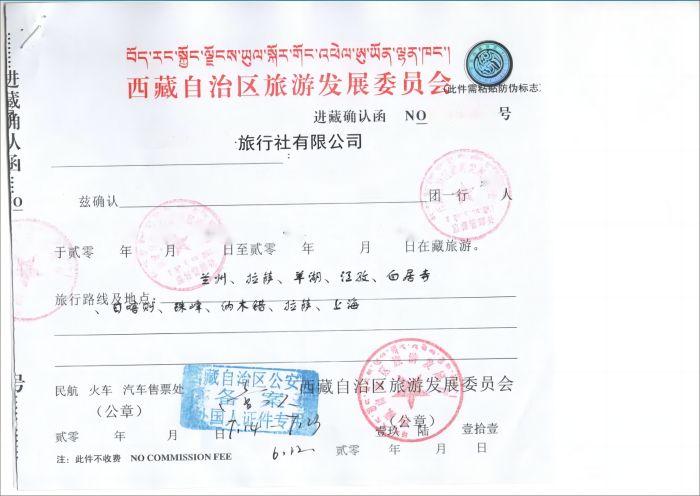
Explore Tibet Destinations on Map
Top attractions in tibet.
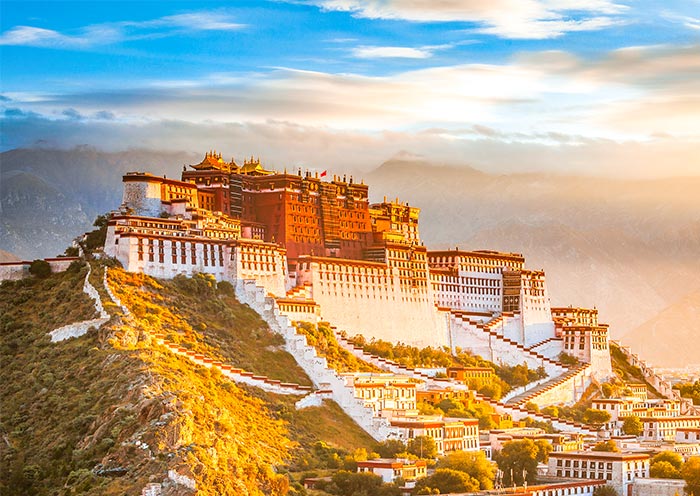
Best Things to Do in Tibet
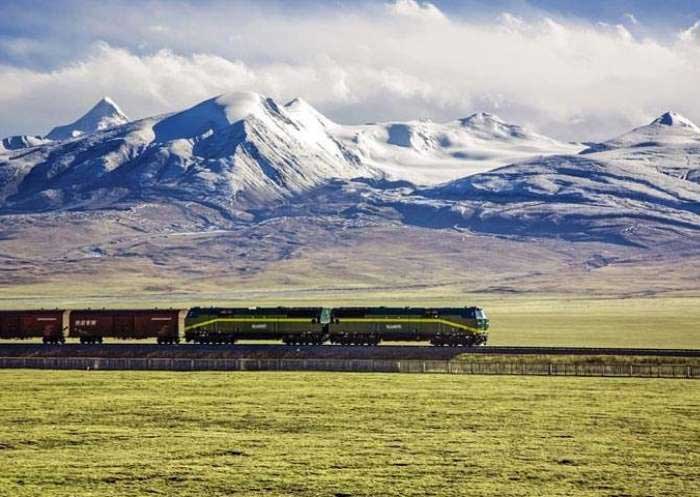
Useful Travel Articles for Each Destination in Tibet
Which destinations in Tibet are you interested in visiting? Lhasa , Mount Everest , Mount Kailash , and Shigatse are must-visit places. Browse through our latest collection of useful travel articles to plan your Tibet trip and get inspired before your visit!
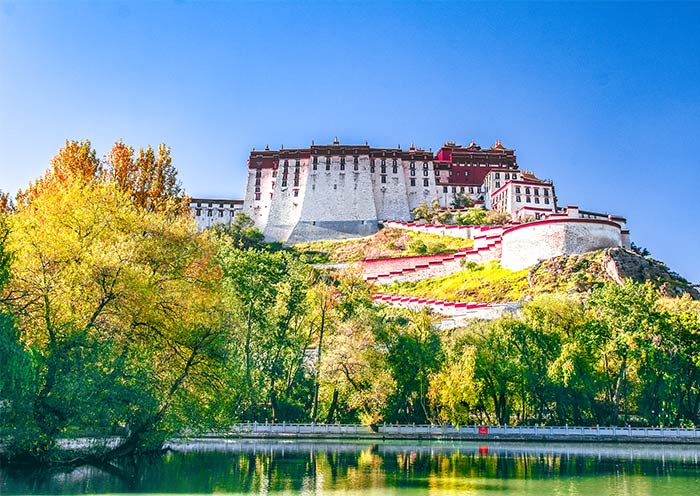
Tibet Travel Itineraries 2024
Join us for a unique Tibet group tour and explore the Roof of the World at the lowest prices in 2024! Choose from our best Tibet group tours, all featuring stable departures throughout 2024. Our tours are all-inclusive, including attractions, comfortable accommodations, transportation, meals, and all necessary permits and fees, ensuring a hassle-free and enjoyable travel experience. With tour lengths ranging from 5 to 15 days and affordable prices to choose from, you can easily select your preferred trip based on travel length, dates, itineraries, and pricing.
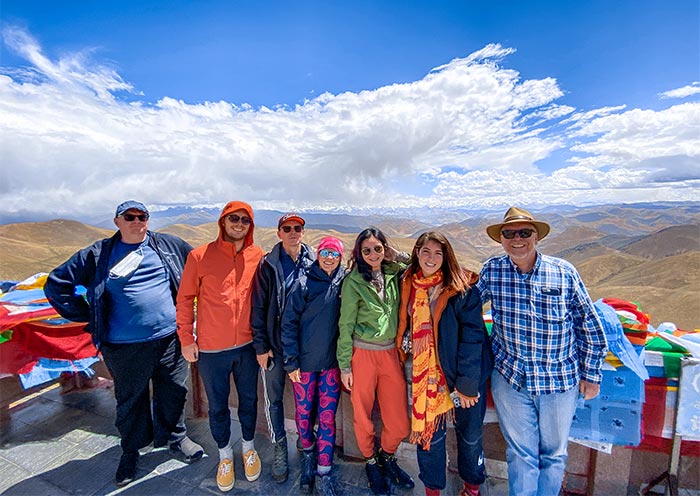
1. Should I worry about altitude sickness when travelling in Tibet? +
The average elevation of the region is over 4,000 meters and altitude sickness is a common concern for travelers visiting Tibet. Not everybody will suffer from altitude sickness when traveling in Tibet and most visitors will be in good condition when they arrive.
The symptoms of altitude sickness can include headache, nausea, dizziness, and shortness of breath. It is important to allow time to acclimate to the high altitude and to take precautions to prevent altitude sickness. Travelers should drink plenty of water, avoid alcohol and caffeine, and eat light meals that are high in carbohydrates. It is also recommended to take it easy for the first few days, avoiding strenuous activities and allowing time to adjust to the new altitude when arrive in Lhasa. Some travelers may also benefit from taking medication to prevent or treat altitude sickness.
If symptoms of altitude sickness persist or worsen, it is important to seek medical attention immediately . Many hotels and travel agencies in Tibet have oxygen supplies on hand to help alleviate the symptoms of altitude sickness. It is important to consult with a doctor before traveling to Tibet, especially if you have a history of heart or lung problems, high blood pressure, or other medical conditions that may be affected by high altitude.
2. How to apply for the Tibet Travel Permits? +
In order to apply for a Tibet Travel Permit , you need to apply for a Chinese visa in the Chinese embassy or consulates in your country first. If you book a tour with us, we will send an invitation letter to you to help you apply for a Chinese visa.
Once you get a Chinese visa, please send the photocopies of the visa and your passport to us, and we will apply for the Tibet Travel Permit for you. Please note that international tourists must book a tour with a local travel agency in Tibet if they want to travel to Tibet.
After the permit is issued, we will send it to your hotel or the places you stay in China. You need to show the permit while boarding on a train or flight to Tibet. The government do not allow travel agencies to send the permit overseas.
3. How to get to Lhasa? By air or by train, which one is better? +
There are usually two ways to get to Lhasa , depending on your starting point and travel preferences.
(1) By Air: You can fly to Lhasa Gonggar Airport from major cities in China such as Beijing, Shanghai, Chengdu, Chongqing, and Guangzhou, as well as from some international destinations such as Kathmandu, Nepal. The airport is located about 62 kilometers (38.5 miles) from Lhasa and can be reached by taxi or bus.
(2) by train The Qinghai-Tibet Railway connects Lhasa with several major cities in China, including Beijing, Shanghai, Chengdu, Xian, and Xining. The train journey is a popular way to reach Lhasa as it offers stunning views of the Tibetan plateau and the Himalayan mountain range. However, the journey can take several days, so it's important to plan accordingly.
Once you arrive in Lhasa, our team at Asia Odyssey Travel will be there to greet you with English-speaking guides and experienced drivers. We'll escort you from the airport or train station to your hotels in Lhasa.
4. How many days for a classic Tibet tour? +
5. How do you get to Tibet Everest Base Camp? +
Travelers can get to Tibet Everest Base Camp from China Tibet side or Nepal side . To reach the Everest Base Camp on the Tibet side, travelers can either take a flight or a train to Lhasa, the capital of Tibet, and then travel by road to the base camp . From Lhasa, it takes around 8-10 hours directly to Tibet EBC, depending on the route taken. Some travelers prefer to join a tour group to explore from Lhasa to Shigatse to Everest Base Camp for 4 days to ensure a smooth and hassle-free journey.
If traveling from Nepal, you will cross the Gyirong Border and then travel by road to Everest Base Camp.
6. Do I need to get a Tibet permit to visit Tibet Everest Base Camp? +
All foreign travelers who wish to visit Mount Everest from the Tibet side are required to obtain a Tibet Travel Permit and Alien's Travel Permit . These permits can only be obtained through a registered travel agency in Tibet. As a local based Tibet travel agency, we can assist travelers in the permit application process.
It's important to note that the Tibet Travel Permit is required to purchase flight or train tickets to Tibet. Therefore, travelers should plan ahead and allow sufficient time for the permit application process, as it can take one to two weeks to obtain the necessary permits .
Create a tour based truly on your preferences, including all aspects of your travel in the destination
Tibet Tours with Travel Inspiration in 2024
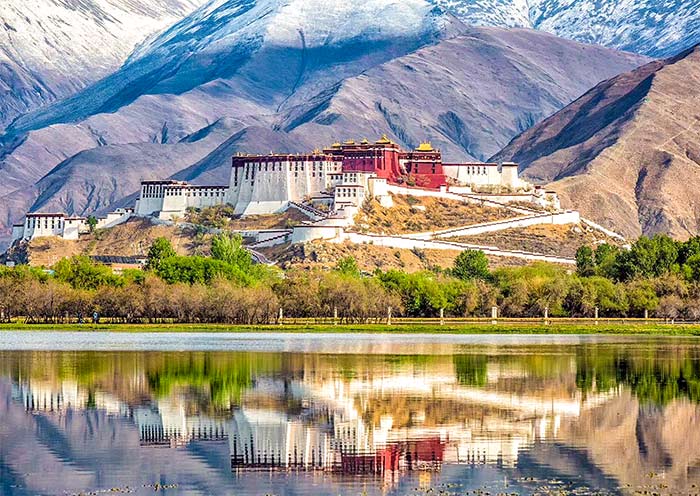
- Lhasa Tours
- Shigatse Tours
- Mount Everest Tours
- Mount Kailash Tours
- Nyingchi Tours
- All Tibet Tours
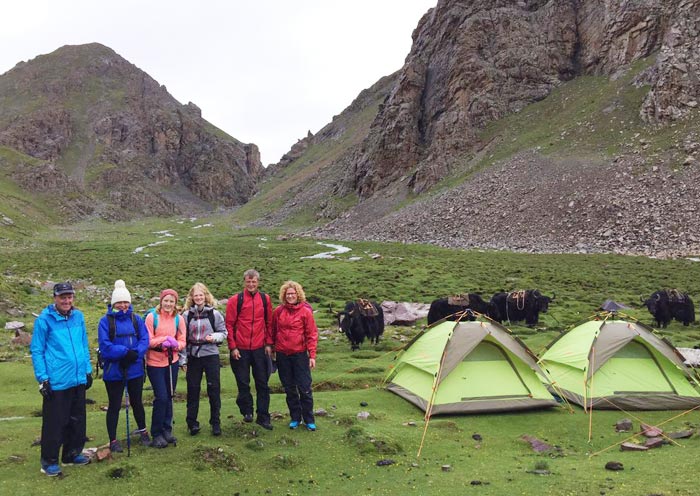
- Top 10 Tibet Tours
- Tibet Private Tours
- Tibet Train Tours
- Tibet Trekking Tours
- Tibet Luxury Tours
- All Tibet Tours 2024
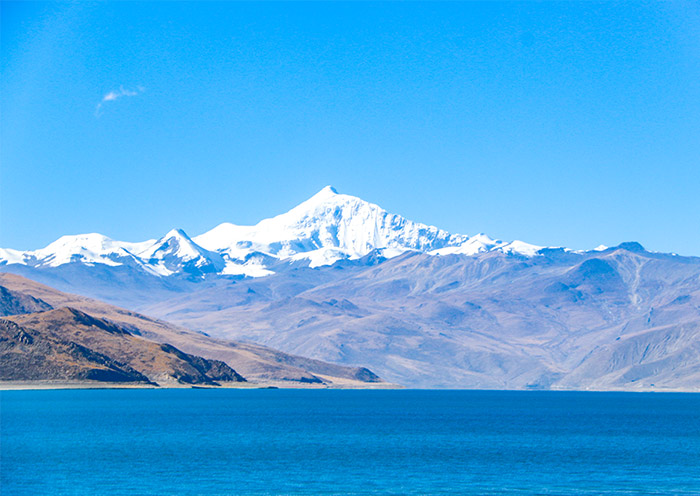
- Beijing Tibet Tours
- Shanghai Tibet Tours
- Xining Tibet Tours
- Chengdu Tibet Tours
- Xian Tibet Tours
- All China Tibet Tours
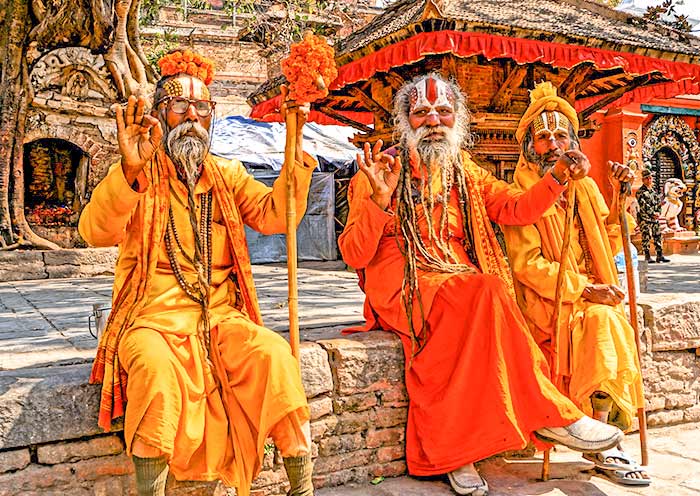
- Lhasa to Kathmandu Tours
- Kathmandu to Lhasa Tours
- Tibet Nepal Tours
- China Tibet Nepal Tours
- Tibet Nepal Bhutan Tours
- Himalaya Tours

- WildChina’s Travelogue
- Bendi Stories
- The China Travel Podcast
- Search All Journeys
- Expert-led Journeys
- Small Group Tours
- Mainland China
- Day Experiences
- Global Departures
- Beshan Website
- Education Programs
- Corporate Services
- Cultural Projects and Spaces
- How to Visit China in 2024
- WildChina Restaurant Guides
- A Guide to China’s Trains
- Travel Updates
- Booking Conditions
- Health and Safety
- Traveling to Tibet FAQ
- How Wild is WildChina?
- Award Winning Services
- Recognitions
- Our Leadership
- Our Designers
- Our Experts
- Work with Us
- Our Sustainability Position
- Plan your journey

Traveling to Tibet FAQs and Tips
What should I be aware of when going to the Tibetan Autonomous Region? See answers to our Traveling to Tibet FAQs and Tips.
(updated April, 2024)
- How do I get to Tibet?
Do I need a permit?
- If I’m already in China, how do I get a Tibet Travel Permit?
- How is the weather in the Tibetan Autonomous Region?
- Can I access internet in the Tibetan Autonomous Region?
- Is Tibet ever closed to foreign visitors?
- Is there a risk of high altitude sickness?
- Do I need vaccinations for traveling to Tibet?
- How are bathrooms in the Tibetan Autonomous Region?
- Have more questions?

How do I get to Tibet?
Tibet can only be accessed via mainland China or Nepal. We recommend entering through mainland China, as the Tibet Travel Permit can be applied for in advance if using this route. If you enter through Nepal, you must apply for a new Chinese visa in Kathmandu (if you already have a valid Chinese visa, it will not be accepted, and will be canceled in order to apply for the new one on-site in Kathmandu) before you can apply for Tibet Travel Permit.
When entering Tibet via mainland China, you have two options: flight or train.
There usually direct flight options from Beijing, Shanghai, Chongqing, Chengdu, Xi’an Kunming and Shangri-La. Flying is the quickest and most-direct option.
The train is an overnight journey from Xining to Lhasa and takes ~22 hours. This is a great option if you have more time, are interested in seeing the scenery along the Tibetan plateau, and seeking a slower acclimatization to the elevation.

You will need a Tibet Travel Permit in order to enter the region. WildChina will arrange this permit for you and send it to you before you fly to the Tibetan Autonomous Region, but please be aware that travel to and within TAR is subject to change with very little notice. In order to do this, you will need to first have a valid Chinese visa. Since the permit takes up to 14 days to process, please ensure you apply for your Chinese visa ahead of time so that it is ready at least 15 days before you intend to enter the Tibetan Autonomous Region.
We advise arranging a phone call with your travel designer before applying for your Chinese visa so we can explain in more detail what to expect and how best to apply.
Once you’ve received your Chinese tourist visa (L visa), we will require a scanned copy of the photo page of your passport and your Chinese visa page, in order to apply for your Tibet Travel Permit.
If traveling outside of Lhasa (still in Tibet) you will also require an Alien’s Travel Permit and Tibet Tourism Bureau Permit (TTB Permit). This will be arranged by WildChina and you will receive the permit once in Lhasa. The cost of these is already included in the land cost.
The Tibet Public Security Bureau requires that a detailed itinerary is submitted when applying for these documents and this itinerary must be followed precisely. As such, it is important to be aware that unplanned deviations from our itinerary are not usually possible.
When handling your Tibet Travel Permit, please take care, as there is a small (not-very-sticky) sticker, which renders the document valid. If this sticker fal ls off, the document is no longer considered valid and will be rejected by authorities.

If I’m already in China, how do I get a Tibet Travel Permit?
If you are working in China and hold a different type of visa than L (tourist), you will
need to provide both a scanned copy of the photo page of your passport and your Chinese visa page, as well as the below additional paperwork:
- Business (F) visa – a letter of recommendation from your company (with the official company seal).
- Work (Z) visa – a letter of recommendation from your company (with the official company seal) and a scanned copy of your work permit.
- Student (X) visa – a letter of recommendation from your school or university, with the school stamp (seal) and a scanned copy of the student ID card.
- Other Types – Diplomats, journalists, and government officials have separate requirements.
Please email us directly to inquire about getting a TTP for these visa types.

How is the weather in the Tibetan Autonomous Region?
Temperatures in the Tibetan Autonomous Region can drop dramatically in the evening. Remember to bring plenty of layers of warm clothing or, if you prefer to travel light, we also recommend purchasing warm clothing in Lhasa then donating the items to a local school/orphanage at the end of your trip!

Can I access internet in the Tibetan Autonomous Region?
Wifi is available in all hotels we use in the region, however it is relatively slow in some areas. 4G is not available, and if you use a VPN service, it may be slower than normal.

Is Tibet ever closed to foreign visitors?
Tibet is closed to foreign visitors during certain months of each year. Exact dates differ each year with little to no warning depending on current circumstances, but the Tibetan Autonomous Region continuously does not issue travel permits for the month of March.

Is there a risk of high altitude sickness?
Lhasa sits at an elevation of 3,656 meters (11,990 feet), and at this height, high-altitude sickness is a risk. High altitudes can make activities, and possibly sleep, more difficult and Acute Mountain Sickness (AMS) can result in headache, nausea, fatigue and loss of appetite.
We recommend visiting your physician to discuss your risk of Acute Mountain Sickness (AMS) 4-8 weeks before departure if you’re traveling in high altitude locations, mainly Xinjiang, Tibet and Yunnan. It is likely he/she will suggest taking Diamox (like with any medication, there are possible side effects, so be sure to ask your doctor about specific compatibility), starting 1 day before you reach the high altitude region and continuing while you ascend.
Once there, it’s important to drink plenty of water. WildChina itineraries are planned as such that you have plenty of time to adjust to the altitude and so you can fully enjoy your trip. In the unlikely event of serious altitude sickness, emergency evacuation measures will be taken.
Most luxury hotels in Lhasa provide a free oxygen lounge and a clinic to help with adjusting, and all WildChina guides and vehicles have emergency-use oxygen on-hand at all times.
If you suffer from high altitude sickness, your local guide and our staff will quickly help you to lower altitude and to the nearest hospital if needed. If you need to leave Tibet early due to altitude sickness, please contact your trip designer so they can assist with booking the earliest-possible departure flight.

Do I need vaccinations for traveling to Tibet?
We recommend visiting your personal physician or a travel clinic 4-8 weeks before departure for information regarding vaccinations. For your convenience when speaking to a doctor, we have included the most useful links regarding recommended immunizations prior to traveling in China.
Many immunizations require at least 10-14 days before becoming effective and should be obtained before you travel to China –especially if you plan to visit more remote, rural areas such as Tibet and Yunnan, or spend a lot of time outdoors.
Helpful resources:
- U.S. Centers for Disease Control and Prevention (CDC)
- Medical recommendations specific to travel in Tibet

How are bathrooms in the Tibetan Autonomous Region?
Hotel bathrooms are generally high standard with Western toilets. However, bathrooms in local restaurants or places of interest will be quite basic and at times, it may be more pleasant to avoid these toilets and use nature instead. As such, we recommend packing a small toilet kit to bring with you, including tissues, hand sanitizer, and wet wipes. Your guide will also have tissues on-hand for you if needed.

Have more questions?
For more information on travel to and around China, feel free to contact us at [email protected] to speak to one of our travel experts.
Ready to plan an unforgettable journey to Tibet?
Take a more profound look at spiritual life in Tibet. You’ll travel through its heart, touring in a loop from Lhasa, along the shores of Yamdrok Tso Lake, through rolling foothills, to Gyantse, Shigatse, and back. At each stop, an adventure, a new facet of Tibetan life to explore.
Travel to Tibet with WildChina
Related Journeys with WildChina

Escape to Lhasa

Sho Dun Festival in Tibet

The Red Dragon and Lhasa

Soul of Tibet
More interesting reads.

We’re on hand to help you get the information you need about travel in China, whenever you need it. We’re not robots; we’re real people, travel designers here to help you.
As COVID-19 restrictions and regulations change, we want to make sure that you can travel in a safe and responsible way. Let us know your China travel questions and, within one business day, we’ll personally get in touch via email, phone call, or WeChat (whichever method you’d prefer) to help you answer it.
Beijing Address:
803 Oriental Place, 9 East Dongfang Rd, Chaoyang District, Beijing, 100027
Shanghai Address:
A12, 3rd Floor, SIP, No. 1318, North Sichuan Road, Hongkou District, Shanghai
Chengdu Address:
26th Floor, No. 1-2 Hangkong Road, Wuhou District, Chengdu, Sichuan
Yangshuo Address:
No. 26 Furong Road, Yangshuo, Guangxi
+86 10 6465 6602
+1 888 902 8808 (Toll Free)
Tibet Tours & Holidays

Lonely peaks, Buddhist monasteries and welcoming people. Tibet is a place unlike any other.
Centuries of isolation have lent the kingdom of Tibet a deep sense of spirituality and mysticism. Once upon a time you could only get there after conquering treacherous terrain and fierce warrior monks, but now – despite the complex political situation – Tibet’s open for travellers to explore. Surround yourself with smoke, incense and the murmuring of the faithful in endless temples and monasteries and experience giddy Everest views. Cross high-altitude passes, twist through towering peaks past plodding yaks, and discover contemporary Tibetan life – a mix of pilgrims and pop music, monks and mobile phones.
Our Tibet trips
Let's create an exclusive trip for your group.
Tibet highlights
Tibet tour reviews.
Filter by rating
Tibet: Beijing to Kathmandu Overland
Articles of Tibet
6 ways you can go beyond Asia’s hotspots in 2023

Climbers have turned Mount Everest into a high-altitude garbage dump, but sustainable solutions are within reach
S pring is go time for climbers who hope to summit Mount Everest, Earth’s highest peak above sea level. Hundreds of mountaineers from around the world travel to Asia in April and May, headed for base camps in Nepal and Tibet.
But jagged peaks won’t be the only thing they see. Especially on Everest’s more heavily traversed Nepal side, they’ll find fields of garbage – including cans, bottles, plastic and human and animal excrement.
Each year, more than 60,000 trekkers and climbers visit the Sagarmatha National Park and Buffer Zone , a high-altitude swath of the Khumbu region in northeast Nepal that includes Everest and seven other peaks. Some 400 to 500 climbers attempt to summit Everest every year.
The trash problem first became evident in the 1980s and 1990s, when climbing on the mountain and trekking in Khumbu began to increase. Climber and trekker numbers have further skyrocketed in the past 20 years .
Most coverage of this issue focuses on negative and sensational aspects, such as the frozen bodies of climbers who remain where they died on the mountain because removal operations are risky and expensive.
We are scholars who study geoscience and mountain geography , and one of us (Alton Byers) has lived in Nepal and worked with communities around Everest. We are encouraged to see increased efforts to address Everest’s massive trash problem. In our view, modern technology and international cooperation are key to ending the pileup of waste in this iconic setting.
Pollution from waste
For most visitors to this area of the Himalayas, Everest base camp on the upper reaches of the rapidly receding Khumbu Glacier is the ultimate destination, at an altitude of 17,589 feet (5,364 meters). Formerly a two- to three-week trek from Kathmandu, today the journey is most likely to begin at the Lukla Airport , which sits about 35 miles (60 kilometers) from base camp.
Climbers who aim to summit Everest typically spend up to two months on the mountain , including weeks making short, incremental ascents above base camp and back down again. This enables them to acclimate to the altitude before climbing to higher camps and then to the summit.
Much of the food and equipment headed to Everest also begins its journey at Lukla. Some is shipped to base camp by helicopter, but much of the gear is carried there by yaks, yak/cattle crossbreeds called dzopkio, mules and horses .
Lots of equipment, food and packaging, plus animals and porters, means a lot of garbage. A 2010 study estimated that park tourism generated 4.6 tons of solid waste per day during peak tourist periods in April-May and October-November.
Eventually most of this refuse is dumped into unsightly landfills a short distance from local villages. There it is burned, adding particulates and toxic chemicals to the air. The remaining ash is buried, where it can contaminate groundwater.
At the base camp, microplastics – likely from discarded mountaineering clothing, tents, ropes and boots – have been found in water and snow samples . High levels of perfluoroalkyl and polyfluoroalkyl substances, or PFAS , widely known as “forever chemicals,” have been found on the Khumbu glacier , probably from materials used to waterproof climbing boots, tents and clothing.
These substances could pose health risks for transient climbers, but are a more serious threat for people who live in the nearby settlements of Gorak Shep, Lobuche, Dugla and Pheriche for most of the year. Some of these villagers work at Everest base camp and are exposed there too.
And then there’s sewage. Most septic tanks at the hundreds of lodges located throughout the national park and buffer zone leak, further polluting groundwater . Camp Four, the last site that climbers occupy before they attempt to summit Everest, is covered with garbage and frozen, wind-swept feces.
National parks in developed countries have infrastructure to handle waste management, trash pickup, recycling and wastewater treatment. At Everest base camp, there are just collection barrels under toilets. Each year, some 50,000 pounds (22,000 kilograms) of human waste are brought to landfills several kilometers away .
Solutions for sustainable tourism
Recognizing the scale of this problem, initiatives are in progress to develop solutions.
The Sagarmatha Pollution Control Committee , created by local Sherpa people in 1991, is an Indigenous nonprofit organization that is responsible for monitoring garbage in the permit-required mountains and peaks. The group focuses on litter control and periodic base camp cleanups.
In 2014, the government of Nepal began requiring every mountaineer who climbs above the Everest base camp to bring back 18 pounds (8 kilograms) of solid waste from the mountain or forfeit a US$4,000 deposit. Of course, if you’ve paid $75,000 or more for the trip, losing the deposit may not be much of an incentive. Many people elect to forfeit it.
A nonprofit called Sagarmatha Next , established in 2019, is working to promote sustainable tourism in the Khumbu region, partnering with companies and organizations from around the world. The group has raised awareness by producing art works and souvenirs from trash. It also launched a “Carry Me Back” program that encourages tourists to take two-pound (one-kilogram) bags of solid waste, such as shredded plastic bottles, to the airstrip at Lukla for processing and disposal in Kathmandu.
At the local government’s request, the University of Colorado Boulder developed a sustainable solid waste management plan in 2019 for the national park and buffer zone. The COVID-19 pandemic delayed implementation of the plan, which proposes creating a five-step process: waste segregation, collection, sorting and shredding, transfer to shipment stations and transportation to recycling facilities in Kathmandu.
Another nonprofit initiative, the NeverRest Project , was created during the pandemic to provide environmental solutions for Mount Everest and other fragile ecosystems around the world. NeverRest is working with the Nepal Tourism Board to revolutionize high-altitude waste management using modern technology.
In 2023, the organization presented a concept plan for a sustainable Everest base camp that would install technologies such as portable solar tents to reduce use of fossil fuel; unisex portable urinals with multi-use filters that convert urine into water; incinerator toilets that transform human waste into ash; and modular geodesic dome tents designed for effective heat retention to reduce energy use.
In the 71 years since Sir Edmund Hillary and Sherpa Tenzing Norgay made the first known successful ascent of Mount Everest , this peak has been a setting for daring expeditions, triumphs and tragedies. We hope that the region’s garbage problem soon will fade into history as new approaches and technologies provide solutions for Everest and other remote high-mountain locations around the world.
- Is it time to stop climbing mountains? Obsession with reaching summits is a modern invention
- Seabirds that swallow ocean plastic waste have scarring in their stomachs – scientists have named this disease ‘plasticosis’
Alton Byers has lived and worked in Nepal, and has collaborated with communities around Everest to protect and restore ecosystems that have been damaged by trekkers, climbers and the tourism industry. He was lead author of a sustainable solid waste management plan for Sagarmatha National Park and Buffer Zone produced in 2020 by University of Colorado Boulder researchers with support from the National Geographic Society.
Suzanne OConnell does not work for, consult, own shares in or receive funding from any company or organization that would benefit from this article, and has disclosed no relevant affiliations beyond their academic appointment.


IMAGES
COMMENTS
1. It is suggested to apply for your Tibet permit at least 20 days before your Tibet tour starts. 2. If you have more than one passport, please make sure you visit Tibet with the same one you used for your Tibet Travel Permit. Or you will be denied entry into Tibet. 3.
Tibet. China, Asia. Tibet offers fabulous monasteries, breathtaking high-altitude walks, stunning views of the world's highest mountains and one of the warmest cultures you will ever encounter. 01 / Attractions.
The Tibet tourism industry generally recommends April to November. Note that summer is green and warm, but also a bit rainy. Avoid: Chinese national holidays in May and October, February and March (due to governmental restrictions). Lhasa Climate Averages.
Updates: Travelers from visa-free countries just need to provide us with passport photos to apply for a Tibet permit if your itinerary in Tibet is less than 15 days.. Applying for a Tibet permit is a different process from getting your China visa.Application from individuals is not accepted: it must be done through a travel agency. Fortunately, it is easy for us to handle all the procedures ...
How to Travel Tibet. But amidst the stunning natural landscapes in Tibet, it's the people of Tibet that truly moved me. Despite mass modernisation and dilution of their culture under China's iron fist, Tibet remains a resilient land underpinned by a rich culture and deep faith. 50 years of oppression and religious control have failed to dull the Tibetans' devotion to their faith.
Tibet Travel Tips. 1. Plan to book at least 10 days before your departure. All Tibet tours must be booked at least 10 days in advance. It normally takes 5 days or so for the Tibet Tourism Bureau to issue a Tibet Entry Permit, and finally (if flying) the original Permit needs to be delivered by mail to the flight departure city in China.. Also, you should make sure you secure an Entry Permit ...
1. Explore the Potala Palace. Potala Palace. The Potala Palace is a symbol of Tibet. The majestic white and red building complex, set against green mountains and blue sky, is an iconic image of the Roof of the World. The fifth Dalai Lama rebuilt this palace and it became the winter home of Dalai Lamas from 1649.
Travel Permits required during Tibet travel. Obtaining necessary permits and documents is of utmost importance when it comes to travel, especially in certain areas or for specific activities. One such example is the Tibet Travel Permit, which is required for foreign tourists to enter Tibet. This permit is issued by the Tibet Tourism Bureau and ...
Tibet is generally open to foreign travelers except in February and March each year. To enter what China calls the Tibet Autonomous Region, you will need both a Chinese visa and a special Tibet permit. Tibet travel permits are issued by the Chinese government, but only through a certified Tibet travel agency. 3.
The extra costs aside from the tour cost itself were: Cost of the Nepal visa ($30 for 15 days, $40 for multiple entries if staying for more days before or after your trip) Cost of the Tibet Visa (Various according to Nationality) American and Brazilian: 195 USD per person. Canadian and Romanian: 150 USD per person.
Travel in Tibet without the supervision of a licensed guide isn't possible. Tibet Permit Tip #2: Extra permits. You need a special permit to visit Tibet. In most cases, a tour company can process all the permits for you. Still, let's take a look at some useful tips concerning Tibet permits.
1. 8 Days Lhasa Gyantse Shigatse Mt Everest Group Tour. 37. 4WD Tours. 3+ days. This is our best-selling tour package! After a three-day sightseeing tour in Lhasa, the capital of Tibet, travelers will…. Recommended by 97% of travelers. from. $992.
Best Months to Visit. The best time to visit Tibet is from June to August. Situated high on a plateau, Tibet experiences low temperatures and frost for the majority of the year. Summer is the only ...
2. Jokhang Temple. 1,230. Religious Sites. Included on UNESCO's World Heritage list in 2000 as part of the Potala Palace, the Jokhang Temple is in the heart of Lhasa downtown. With an area of 25,100 square meters (about six acres), it is the ultimate pilgrimage destination for Tibetan Pilgrims. As the most sacred temple in Tibet, Jokhang Temple ...
Tibet Tourism: Tripadvisor has 29,936 reviews of Tibet Hotels, Attractions, and Restaurants making it your best Tibet resource. Skip to main content. Discover. Trips. Review. USD. ... Tibet Natives Travel Services. 193. Hiking & Camping Tours, City Tours. Lhasa, China. Drepung Monastery (Zhebang Si) 322.
A 7-Day Tibet Train Tour Itinerary (Good for Train Tour Lovers) If you would like to travel to Tibet by train, then this itinerary would be good for you. You would take the Qinghai-Tibet Railway, highest and longest plateau railway in the world, to enter Tibet. Days 1-2: Xining, Qinghai (Explore, Board the Train) Days 3-4: Xining to Lhasa ...
Tibet Tours with Travel Inspiration in 2024. To get more inspiration to travel Tibet in 2024 and 2025, you can browse our Tibet tours sorted by "Regions", "Themes", "Start Tibet Tours from Major City" and "Travel Beyond Tibet". No matter you want a private trip or a group tour, classic exploration or featured travel, you can get ...
Tourism in Tibet has recently become one of the country's development strategies. In 2015, Tibet received more than 20 million tourists, and its total annual tourism revenue reached 28 billion yuan, accounting for more than 25% of the region's GDP and contributing more than 20% to Tibet's economic growth [1] .But at the same time, Tibet's ...
When entering Tibet via mainland China, you have two options: flight or train. There usually direct flight options from Beijing, Shanghai, Chongqing, Chengdu, Xi'an Kunming and Shangri-La. Flying is the quickest and most-direct option. The train is an overnight journey from Xining to Lhasa and takes ~22 hours. This is a great option if you ...
Lonely peaks, Buddhist monasteries and welcoming people, Tibet's a place unlike any other. Surround yourself with smoke, incense and the murmuring of the faithful in endless temples and monasteries and experience giddy Everest views. Book your tour with Intrepid Travel today.
Lots of equipment, food and packaging, plus animals and porters, means a lot of garbage. A 2010 study estimated that park tourism generated 4.6 tons of solid waste per day during peak tourist ...